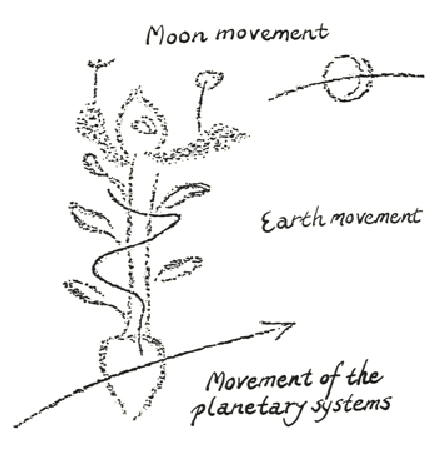| 316. Course for Young Doctors: Christmas Course II
03 Jan 1924, Dornach Translated by Gerald Karnow Rudolf Steiner |
|---|
| 316. Course for Young Doctors: Christmas Course II
03 Jan 1924, Dornach Translated by Gerald Karnow Rudolf Steiner |
||||||||
|---|---|---|---|---|---|---|---|---|
As we shall be able to make use of the eight hours at our disposal for this course of lectures, I need not hurry, and this will certainly be all to the good. I want to develop the material given yesterday by speaking of the characteristic qualities of the several members of the human being. I spoke of the physical body which is to be connected with everything that has definite contours in the organism. There is also the fluid organism. This fluid organism is permeated with the forces of the etheric body, forces which are, however, united with the physical body as primary components of it. These are the peripherically working forces. So far as the astral body is concerned, conceptions of space will not help us at all; the astral body cannot be understood from the quantitative aspect, but only from the purely qualitative aspect. We must picture the astral body in a world that is not the world of space, as we know it, but lies outside this spatial world. And this is all the more true when we come to the ego organization. The easiest way will be to start from the ego organization. What is this ego organization, in reality? In the physical world, it is to be perceived in the form of the physical body. In the physical world, of course, both the inner and the outer form must be included. Looking at the physical body of man as it stands in the physical world, we must realize that it has nothing fundamentally in common with the forces working in the physical world. For the moment a human being passes through the Gate of Death, and the ego organization leaves the physical body, this body begins to be subject to the forces of the external world. This means that the body is no longer built up but is destroyed. If you remember that the physical body is destroyed by the forces that are working in external nature, you will realize at once that the body cannot, in its form, be subject in any way to the forces of the physical world. When the ego organization is forming and shaping the physical body, therefore, this means that it removes the body from the forces that are present in man's earthly environment. In other words, the ego organization is something quite different from all that is to be found in the physical world. This ego organization is connected with death. What happens in death, all at once, goes on continually throughout the period of earthly life, through the ego organization. The human being is really continually dying, but this process of dying is balanced out. To get a picture of this, think of a modified version of the legend of Penelope. Suppose you were occupied every day in doing away with a heap of earth near your house, and during the night, in your absence, someone were to come and shovel the earth back again. As long as the earth is put back you have to shovel it away again. Your activity only ceases when the heap of earth gradually gets smaller and smaller on account of decrease of activity on the part of the one who puts the earth back again. This, approximately, is a picture of the ego organization in its relation to the physical body. Nourishment of the physical body consists in bringing into it substances from the earthly environment. These substances have their own inner forces, a certain complex of forces which belongs to them, and when, for example, you take common salt as an adjunct to food, this salt, to begin with, because it comes from outside, has the same inner tendency of action which it has, as salt, in the external world. But you begin to take these qualities away from it even when it is in the mouth, and then more and more, so that, finally, if the ego organization is working properly, there is nothing any longer within you of the salt, as it was in the external world. The salt has become something completely different. The activity of the ego organization consists precisely in transforming the in-taken foodstuffs. When it is no longer possible for the physical body to take food, the ego has no more to do, just as you had no more to do when nobody was shoveling the earth heap back again. When the body is no longer capable of taking food, it is impossible for the ego to work from out of the warmth, in the physical body. We can say that death occurs when it is impossible for the ego organization to so transform the external substances that nothing remains of the outer characteristics instead of being totally in the service of the ego organization. What does the ego organization do with the physical body? It destroys the body all the time. It does the same as death, only the process is continually balanced out by the physical body being able to take external substances as food. Ego organization and the process of nourishment, therefore, are polar opposites. The ego organization betokens for man exactly the same—but in a process of continuous activity—as death betokens, but, in death, the process is concentrated, it happens all at once. Through your ego organization you are dying all the time, that is to say, you are destroying your physical body inwardly, whereas when you die, external nature destroys your physical body outwardly. The physical body is capable of destruction in two different directions and the ego organization is simply the sum total of the destructive forces working inwards. It really seems, at first, as if the ego organization had no other task than to bring about continual death in the human being—a process that is only prevented because there is fresh reinforcement, so that this activity only begins to bring about death. In the qualitative sense, therefore, ego organization is identifiable with death, and the physical organism is identifiable with the process of nourishment. We will speak in greater detail later on.
Between these two polar processes in the human being lie the etheric body and the astral body. Astral body and etheric body lie between the ego organization and the physical organism. The astral body, as you heard, only works directly in the aeriform part of the human organism, from there by way of the etheric body upon the fluid organism and the physical organism or organism of nourishment. In every single organ there is a working together of etheric organism and astral organism. When the etheric organism works upon an organ, this organ is imbued with budding, sprouting life. The life force in any single organ, or in the organism as a whole, comes from the etheric organism. The astral organism has at every moment the tendency to paralyze this budding, sprouting life—not to kill it, but to damp it down, to lame it. The ego organization strives all the time to kill the organism and the single organs, and in opposition to this there must be the reinforcement from the foodstuffs taken from the external world whereby life is continually poured into the organs. This process is especially active in childhood and youth. The etheric impulses are opposed by the activity of the astral body which damps down the etheric activity all the time. If there were only etheric activity, budding and sprouting life in your organism, you would never have a life of soul, you would never unfold consciousness and would have to vegetate in a plant existence. No consciousness unfolds in a process that is simply one of growing, budding, sprouting. For consciousness to develop, the etheric, budding and sprouting life must be damped down. Therefore in any organ where the etheric life is damped down or lamed, we have, even in normal human life, the perpetual beginning of illness. There can be no development of consciousness without this perpetual tendency to illness. If you wanted just to be healthy—well, that is possible, but then you would have to lead a vegetative existence. If you want to unfold a life of soul, if you want to have consciousness, the vegetative process must be present, but it must be damped down. The polar contrast is not so marked between the etheric and astral organizations as it is between physical organism and ego organization, but it exists, nonetheless, in a modified form. The astral organism must continually damp down what is brought about by the etheric organism. In reality, therefore, what the astral organism does day by day in the life of man, amounts to a tendency to illness. The etheric organism brings about rampant healthiness. Just as in abstract language, we can say: Man consists of physical body, etheric body, astral body, and ego organization—so we can also say: Man consists of the process of nourishment, of the building, sprouting, health-bringing process, of the perpetually in-working processes of disease, and of a continuous dying that is checked until the death-bringing processes gather together as it were into an integer and death occurs. Think of this astral organism with its perpetual tendency to make an organ, or the whole man, ill. Genuine observation will show you that this is so. For no feeling could arise in you if this astral organism were not present. Just picture it. The etheric organism unfolds life and the astral organism damps down the life. In the waking state (I shall yet have to speak of sleep), there must be a continual swinging to and fro in a labile state of equilibrium, between etheric organism and astral organism. This enables a human being to feel. He would feel nothing if this swinging to and fro did not take place. But now suppose the astral activity is not immediately driven back by the etheric activity. When it is driven back, when the astral activity is driven back in statu nascendi by the etheric activity, normal feeling arises. We shall see how this is connected, in the physical, with the activity of the glands. But when the astral organism becomes more powerful, so that the organ cannot work with sufficient strength in its etheric activity, then this organ will be laid hold of too strongly by the astral activity and instead of a swinging to and fro there will arise a deformation of the organ. When the astral body oversteps the mark in this activity of damping down, when it goes beyond the process that is balanced out in statu nascendi—then the cause of illness is located in the astral body. And there is indeed such a close connection between illness and feeling that we can say: The life of feeling in man is simply the reflection, in the life of soul, of the life of illness. If there is a swinging to and fro, there underlies the life of feeling—but always in statu nascendi, in the moment of ‘becoming’—the same process which is a process of illness when the astral organism gets the upper hand. Now it may also happen that the etheric organism gets the upper hand of the astral, which withdraws. Then there will be rampant growth, which is illness in the other direction. When the astral body gets the upper hand, inflammatory conditions arise; when the etheric activity gets the upper hand, swellings or growths appear. In the entirely normal life of feeling, a delicately poised balance is always maintained between growths and the inflammatory process. The normal life of man needs this possibility of becoming ill, only a continual balancing must take place. Thus if we are able to perceive truly, we can see in the normal life of feeling a great deal of what is represented by the processes of illness. If we can observe such things truly, we can ascertain the approach of the illness a long time before it can be physically diagnosed, in a wrong functioning of the life of feeling. Illness is only an abnormal life of feeling in the human being. The life of feeling lies in the realm of the soul, because a continual equalization or balancing takes place in the etheric. When the balancing no longer takes place, the life of feeling strikes down into the physical body, unites with the body. Illness is present, therefore, as soon as the life of feeling shoots down into the organ. If, in the normal way, a person can keep his feeling within the realm of soul, he is healthy. If he cannot do this, if feeling shoots down into some organ, illness arises. I say this by way of introduction, because you will realize from it how necessary it is for the physician to have a quick and delicate eye for the soul life as well. There can be no aptitude for true diagnosis without a faculty of delicate perception for the life of soul. We will speak of details later on and this will become still more intelligible. But now, what of the ego organization and the physical organism? Think, first, of the process of nourishment. This process of nourishment is all the time destroying the substances as they are in the external world; the astral organism damps down what the human being is, inwardly, through his etheric organism. An inner balance is established between astral organism and etheric organism. Between the ego and the physical organism there is also a balance—here between outer world and inner world. Salt, as we know it, is outer world. When the salt is taken hold of by the forces of nourishment and by the ego organization, the ego organization must be in a position completely to transform the salt as it is in the external world, to leave nothing of it behind in this form. If anything is left behind, this means that a foreign body is within the organism, but you must not merely think of this ‘foreign body’ in the organism as necessarily having definite contours, for this is least often the case. A foreign body in this sense may also be the external warmth. There should be no warmth in the organism that is not engendered by the ego organization. You must be able to conceive of a person being seized, somewhere or other, by a condition of external warmth upon which he himself does not work—it is just like a piece of wood being seized by some condition of outer warmth. An external condition of warmth may not be only a stimulus to the human being to work up a warmth of his own, but the external warmth (or cold) may begin to work directly, and this outer cold or warmth would also have to be regarded as a foreign body in itself. Thus we can say: The inner balance between illness and health is produced by the astral organism and etheric organism. The balance between the human being and the world is produced by the polar contrast between physical body and the ego organization. The thing of importance is to get a true perception of the activities of these four members of the human organism. You realize now, surely, that illness is simply not to be understood from the external, physical organism. The process that constitutes illness lies entirely in the super-sensible. Before we can understand illness at all we must have a conception of the astral organism. And you will get this conception if you will consider the following state of things: pain arises in some organ. When the astral body becomes too powerful, the organ is ‘deformed’, and pain arises. If the organ immediately balances the influence of the astral body in statu nascendi, feeling arises. Pain is really feeling, but an enhanced feeling, proceeding from the deformation, so we can understand why illness is accompanied by pain. Without knowing this, it is very easy to ask: What is it that really causes pain in manifestations of illness? It is easy to understand why pain arises when we know that this illness is merely caused by such a strong expression of the life of feeling that this life of feeling is deforming the organ concerned. You will see now that all manifestations of feeling can be judged truly through a thorough and deep study of man's life of soul. But these things can only be seen in their right light when we say to ourselves: Conditions differ according to which organ in the human being is laid hold of by excessive activity of the astral body. Suppose, for example, it is the liver which is being thus laid hold of by the astral body. The liver behaves quite differently from other organs. The astral body can cause much deformation without pain being produced, without pain arising exactly in the liver itself. The reason why liver diseases are so hidden, so treacherous, is because they do not announce themselves through pain. This is because the liver is an organ which, in its whole make-up, is an enclave in the human organism. There are processes in the liver which, of all processes which arise in the organism, most resemble the processes of the external world. The fact, therefore, is that in the liver, man is least man. In the liver he really ceases to be man. He becomes outer world; he has a piece of the outer world within him. This is very interesting. We have the external world; we have the human being; and within the human being, inside him, we have something like a piece of the external world. It is as if a kind of cavity were hollowed out in the organism and just as it would not hurt if the astral body were to press into this cavity, just as little is there pain when the astral body presses into the liver. The astral body can destroy but cannot cause pain where the liver is concerned, for the liver is an organ where a piece of the external world appears in the organism, as it were, in an enclave. Without entering into such things, we shall never be able to understand the human organism. In ordinary textbooks of anatomy and physiology you will find all kinds of indications about the liver. You will understand them when you know that the liver is an organ within the human being which is most foreign to him. Why is this? Think of an eye, or some other sense organ. It lies in a cavity which digs itself into the human being from the external world. There are processes in the human eye which can almost be explained by physics. It is easy for a physicist to speak rationally about the human eye. A physicist makes a sketch with some lines on it which, although it is all really nonsense, gives a picture of the process of the breaking-up of the light and the production of an image by an ordinary lens. The same kind of drawings are made of the eye. People draw a ray of light which passes through a lens, is broken up and then forms a picture in the background of the eye. People have really become physicists in regard to the eye and since the days of Helmholz the ear, too, has almost become a kind of piano. It has become common to apply to the sense organs conceptions that are applicable to external nature. In the sense organs, something is being continued from outside inwards, a piece of the external world is continuing
on into the inner world. There is even biological proof of this. In certain lower animals the eye is formed through an indentation which is then filled from outside. The eye is built into the organism, as it were; it does not grow out of the organism. The sense organs, therefore, are a piece of the external world within the organism. But they open outwards. In the sense organs the external world passes into the organism like a gulf. The liver is enclosed on all sides, but nonetheless it is a sense organ, a sense organ which, in the unconscious, shows a high degree of sensibility for the value of the different substances we take as foodstuffs. We can only understand what is going on in digestion, in the process of nourishment, when we no longer ascribe to the liver only those physical processes which are ascribed to it today. These processes are the expression of the spirit and soul. We must see the liver as an inner sense organ for the perception of the process of nourishment. For this reason the liver is much more closely related to the substances of the earth than are the familiar sense organs. With the eye we are exposed to the working of the ether, with the ear we are exposed to the air; but the liver is directly exposed to the qualities of the substances in the external world and it has to perceive these qualities. The heart is a sense organ of a different kind. The perceptive faculty of the liver is exposed to external substances that come into the human being. The heart is a sense organ for perceiving the inner being of man. I have often said that it is nonsense to regard the heart as a kind of pump which drives the blood through the arteries. The movement of the blood is the result of the activity of the ego and astral body, and the heart is merely a sense organ which perceives the circulation, particularly the circulation from the lower to the upper man. The task of the liver is to perceive, in the digestive process, what value a carbohydrate, let us say, has for the human being. The task of the heart is to see how astral body and ego are working on the human being. Therefore the heart is an entirely spiritual sense organ, the liver a wholly material one. This distinction must be made. We must develop a qualitative knowledge of the organs. What are the methods of the natural science upon which medicine is based today? Some tissue or other—it really does not matter very much which—is taken from some part of the organism, perhaps from the heart or the liver. The outer structure and make-up of this tissue are then examined. But this tells us nothing about the organ as it actually is, within the human organism. Suppose I have, here, a knife, and, there, a knife. I examine them. This is a knife, and that is a knife, only the one, when I examine its form, has a blunt edge on one side and a cutting edge on the other, and the blade is in a handle. The same could be said of the other knife—therefore the net result is, here, a knife; there, a knife. But to find the difference between a table knife and a razor I must go beyond this kind of examination. I must relate the knives to something that is a whole. Regarded externally, a razor might also be a table knife; therefore, merely from the form, I cannot know whether I have to do with a table knife or with a razor. Each thing must be observed in its whole nexus. Out of the kind of observation that is applied today to an organ, one cannot know anything about the significance of this organ in reality. It must always be regarded in the whole nexus of things. Mere examination of the structure and the make-up of an organ leads nowhere. The human being must be studied with quite different methods from those of chemistry which merely examines the chemical affinities and forces. In this respect, people are terribly naive today. In a certain physiological institute, experiments were made to see how mice could be nourished with milk. The result was splendid, for the mice flourished and became fat and big. At the same time, for the purpose of proving that there is something more in milk than its component parts, these components were separated and given to the mice. They perished within three or four days and could not be kept alive. And then people said: Milk does not only contain its known components, but it contains, as well, another substance—the vitamin. They were obliged to affirm the existence of yet another, very fine substance, namely, the vitamin. The point of importance is not the discovery of such a 'substance' but that to take the separate components of the milk is like taking a clock and looking at the brass, the silver, the other metals in it, the glass and so on. Yes, but the brass, the silver, the glass and all the other metals do not make a clock. The clock depends upon what the mind of the mechanic makes out of these substances. And in the case of milk and its components we are thinking with the mind of the mechanic, when we are concerned with the fact that earthly qualities are contained within these components—qualities which they get from the earth. Up to a certain point of time the peripheric forces from the etheric body are still present, as well as the earthly components. People must finally bring themselves to accept these things. It is not so much a question of things being hidden, and then ‘found’. The discovery of vitamins, for example, simply confirms what exists. Quite a different mode of observation must become current. Suppose you are eating too many potatoes. You will never find out anything with the ordinary methods of investigation. It will be useless to try to ascertain the effect of potatoes in the human organism by computing the quantity of carbohydrates. The other carbohydrates which are present, for example, not in roots but in leaves or in fruits, are worked up in the digestive tract. There is something very remarkable about the potato. The potato passes with its forces so intensely into the human organism, that, what in the case of the bean happens while still within the digestive tract, happens in the case of the potato only in the brain. In the brain, too, processes of nourishment are continually taking place. I am only indicating these things in order to speak in greater detail later on. A person who eats too many potatoes may, under certain circumstances, overwork his brain. He transfers processes which ought to take place below the brain to the brain itself. It will only be possible to get something from medical science for hygiene and for social life in general by learning the relations of the human being to the substances around him, not from their chemical make-up but from their world connections. Whether a substance appears in leaf or in root constitutes a fundamental difference. It is much more important to know from which part of the plant a substance comes than to know whether it contains carbohydrates. Roots are more connected with the head organization of man; flowers and leaves more with the lower man. The chemical make-up really plays no outstanding part. The relations of the human being to the surrounding world must be learned from quite other things if we really want to understand the curative and the disease-producing factors, the disease itself, and its remedy. The heed that is paid to the indications given by abstract chemistry has really, little by little, buried all knowledge of the human being, because knowing the chemical make-up of a substance does not tell us anything about the real relations of man to the surrounding world. Take another example—the point of view derived from chemistry is that oxygen is necessary in the air but that nitrogen is not necessary to the same extent. From what is commonly thought about oxygen and nitrogen, we might imagine that it does not matter so much to the breathing when there is too little nitrogen in the air, provided there is enough oxygen. But the truth is, that when air contains too little nitrogen, the human being gives off nitrogen in order to replace it in the air around him. The human being is so constituted that there must be a certain relation between his own nitrogen content and the nitrogen content of the surrounding air quite apart from the breathing process. All these things are exceedingly important for an understanding of the nature of man. But although they are investigated and known, here and there, they remain fruitless for the modern world of science as long as there is no basis for understanding how man is membered into the world around him. We will try to find this basis in order to get insight into the healthy as well as the ill human being.
|
| 316. Course for Young Doctors: Christmas Course IV
05 Jan 1924, Dornach Translated by Gerald Karnow Rudolf Steiner |
|---|
| 316. Course for Young Doctors: Christmas Course IV
05 Jan 1924, Dornach Translated by Gerald Karnow Rudolf Steiner |
|---|
In the three previous lectures I have tried to give you an outline of the kind of knowledge that should serve as a foundation for physicians. Owing to the very brief time at our disposal, it has only been the merest sketch. But you will have realized that to speak in detail would need considerable time. The kind of knowledge I have given as a foundation for medicine would constitute, as it were, a first course which would take at least a year and longer still if that were possible. It is impossible for me to do more than give a general description of these things, so I should like you to regard what I have said in the three previous lectures as a sketch of what a physician ought to have as a basis. Let me call it the exoteric side of medical knowledge, and it ought really to be followed by the esoteric side, of which we will speak now. This esoteric side must be built upon the foundation of the exoteric knowledge. In your medical studies you must not be too proud to master the exoteric side; you must master this with all earnestness. It is difficult at the present time, but, as we shall see, much will be achieved in this direction by the establishment of the Medical Section here at Dornach. After all, it is possible now to expand the short sketch that has been given by many details contained in my lecture courses and writings. Up to now, very little has been done in this direction and the work will only begin to develop in the real sense of anthroposophical medicine when this work that I am preparing with the help of Frau Dr. Wegman comes to the fore. It will then be apparent that Anthroposophy can give a great stimulus to medicine and medical studies. But you must realize quite clearly that medicine is a very special kind of study, with definite preliminary requirements—a study in which the results of Spiritual Science simply cannot be ignored. There can be no true medicine without the knowledge that results from Spiritual Science. The chaotic conditions prevailing today are due to the fact that the current trend of study and knowledge is utterly unsuited to medicine. We have a science of nature that has found its way even into theology, a science that is suited only to technical purposes and not at all to a real knowledge of the being of man. This science is not able to impart a true knowledge of man's nature. Medical science in the real sense demands something quite special and you will realize that this is so when I come to speak of how the human being really comes into existence. I spoke yesterday from the exoteric side and will now make the transition to the esoteric aspect: external substances are, in reality, processes. Salt is only a precipitation of processes; the magnesium process, the iron process are processes which exist outside in nature. The lead and mercury processes are processes in external nature which the human being cannot have within his physical organism. For all that, it is only in outward semblance that these processes are not within the human being. How does the human being come into existence? The physical germ comes into being through fertilization and there must be a union between this physical germ and the etheric body of the human being. But fertilization does not create the etheric body. The etheric body forms around what are, later on, ego organization and astral organization, in order to receive the being of spirit and soul who comes down from the spiritual worlds, the being who has been living in pre-earthly existence. The real kernel of man is of the spirit and soul. It has come firstly, from earlier incarnations, secondly, from the period between death and rebirth, and has been in existence long before any fertilization takes place. This kernel of spirit and soul exists before a connection is made with the physical germ cell which is the result of fertilization. It unites, first, with the etheric body which in turn unites with the physical embryo. Ego, astral organization, etheric organization—this trinity unites with what comes into being through the physical fertilization. You must regard the etheric body as something that is built in from out of the cosmos. Now at the time when the etheric body first unites with the physical organization it contains within itself the forces which are not suitable for the physical organization, namely, the lead forces, the tin forces and so on. It is only in semblance that the human being is not a complete microcosm because certain substances are not within him physically. The substances that are not contained in the physical organism of man are of the greatest importance for the constitution of the etheric body, and in the etheric body, before it unites with the physical body, there are lead processes, tin processes, mercury processes, and so on. And now the etheric body (and the other members, too, of course) unite with the physical body. All the forces derived by the etheric body from the substances that are not contained within the physical body now pass over to the astral body—this happens to a slight degree during the embryonic period but in a high degree when the real breathing begins at birth. The etheric body then takes on those forces which the physical body works up within itself. Thus the etheric body passes through a very significant metamorphosis. It takes on the content and constitution of the physical body and gives over to the astral body its own constitution, its relationship with the environment of the human being. The astral body is now inwardly linked with what the human being is capable of knowing, and the moment you begin, my dear friends, to acquire not merely a theoretical but a true and inwardly digested medical knowledge—in that moment you make alive within you the knowledge that is already within the astral body. It is there, but it remains unconscious, and it is, in reality, a knowledge of man's relationship with his environment. Let me take a special case. Think of some district that is depressing—on account of the soil containing gneiss and the mineral known to you as mica. Mica has a very strong influence on the physical constitution of a person who is born in such a district. The physical body is different in a district where there is much mica. The mica forces work upon the physical body from out of the soil. Now you will find that many rhododendrons grow in districts where the soil contains a great deal of mica. This plant grows plentifully in the Alps and in Siberia and so forth. The rhododendron substance is something that is intimately connected with the etheric body before it comes down into the physical body in such regions. This relationship with the rhododendron the ether body gives over to the astral body. And now, suppose that illnesses occur which are due to a preponderating working of the mica by way of the ground water. The etheric body has given over what came to it from the rhododendron, to the astral body. This element is present externally, in the rhododendron plants. This indicates that the rhododendron contains a sap that has a remedial effect upon this illness. In many cases, though not in all, a specific remedy is to be found in regions where particular illnesses occur. And now suppose you are a physician. Every night when you go to sleep, you pass, in your astral body, into the environment which was once connected with the etheric body but is now connected with the astral body. If you have medical knowledge, if you know what healing forces exist in the environment, that knowledge becomes experience during sleep, and so you have continually the confirmation of what you learn, externally, through dialectics. And this factor must be reckoned with in medical study, because no outer dialectic learning of medical science really helps. It becomes fragmentary and chaotic if there cannot arise during every sleep, within the span of the astral body, the confirmation that is necessary. If medical knowledge is not acquired in such a way that the astral body, in the intercourse with the environment, is able to say “Yes” to what the student has learned, it is just as if he were listening to something that he cannot understand and only confuses him. So you see, medical knowledge is intimately connected with the sleeping state. Such things convince us that medical knowledge must be acquired by the whole man, by man as a living, feeling being, for together with this ‘nightly’ intercourse with the healing substances, something else grows up, something that can never be acquired through dialectic—I mean, the true desire to help. Without the sincere desire to heal, the feeling of sympathy on the part of the physician with the person he has to cure, without this strong desire to give personal help, no healing in the real sense is possible. And here I must say something that may seem very strange and paradoxical, but as you want to know in what way things are wrong today and what ought to be done, I must say it, for in Dornach we are working from esoteric impulses. People have often said to me that steps might have to be taken to protect the remedies that are prepared in our pharmaceutical laboratory, so that they shall not be copied by other people. I once replied that I was not so very anxious about this, provided we succeeded in bringing true esoteric impulses into our medical work. Then people will realize that the remedies are made with an esoteric background, and that it is not the same if the remedies are made here, with the esoteric life behind the work, or whether some factory copies them. This may seem very strange, but it is true nevertheless. Much more important than protecting things by business devices is the growth of an attitude which aims at making the remedies effective from out of the Spiritual. This is not superstition—it is something that can be substantiated in Spiritual Science. Therefore, people possessed of understanding will begin to realize that with the taking of remedies that are produced here, a beginning has been made in the right direction. Such objections as have been made to me are due to the fact that people do not realize in the least how seriously the esoteric, spiritual life must be taken, above all, in medicine. If you once grasp this, you see that a center for medicine must be instituted here as a reality, not as a mere formality. And now you will understand that a first, exoteric course of medical study should be followed by a second which approaches the human being esoterically, which merges medical knowledge into what becomes a true medical consciousness, a true medical attitude. There have, of course, always been individuals who sought instinctively for this. And in the last third of the nineteenth century, at a time when there was so little that was capable of producing this attitude, one could see, but only in isolated individuals who were then regarded as cranks, sporadic manifestations of this medical consciousness. The basis of the reputation enjoyed by the Viennese School of Medicine at the time when I was growing up was connected with its attitude to therapy, where the actual therapy hardly mattered at all, especially treatment of pneumonia, an illness where one can do very little for the central disease itself. You have all heard of medical nihilism, and this is its origin. The most eminent physicians in Vienna were deliberate advocates of medical nihilism In other words, they held the point of view that no remedy heals. To a certain extent, Rudolf Virchow (1821–1902), too, held this view. His view was: If a hundred patients are said to have been cured, one can assume with fifty percent of them that it did not matter whether they had been given a remedy or not; they would have got well without it; with 30 percent it could be said that the remedy had done actual harm; and with the remainder, chance might have brought it about that the remedy selected had helped. It is not I who make this statement, but Virchow, who had a great reputation in the medical world last century. I know eminent men today, too, who adhere to this view, although they may be advocates of therapy. No true medical consciousness is expressed in this view. Medical consciousness can never be regarded as a merely formal attitude. It must be a reality. Therefore, the second medical course would have to contain the human aspect that is built up on the basis of the exoteric material. There must be that human factor that worked, in a somewhat degenerate form, but, for all that so magnificently and attractively, in a person like Paracelsus. Certainly, objections to Paracelsus can be made in certain details, but this medical consciousness lived in him, in a splendid way. Whenever he came to a district where the soil was strikingly red, he knew that a number of diseases—especially those that are due to diseases of the blood—were caused by the red sandstone in the soil. {Translator's note: The word in the German is the name of a substance described as a system of sandstone, shale and conglomerates of the lower terrain of Germany.} The way in which a process of illness develops is very characteristic. We find that the people living in a district where there is this red sandstone soil have accustomed themselves to this soil and have a certain characteristic temperament. They have a very lively activity of the spleen. Coming as a stranger to the district, one does not easily take a liking to them. They are frightfully stubborn, dogmatic, obstinate, and when one considers what they do to be foolish—they just return the ‘compliment!’ But suppose a stranger comes and wants to set up a business or something of the kind. He cannot stand the soil, especially not the water, and he will show certain symptoms of illness. Paracelsus said that illnesses which are contracted in such a district are then passed on to the natives who are born there. He said that something must be present in the etheric body (which he calls the ‘Archaeus’). He said that the ‘Archaeus’ must have undergone something before it entered the embryo. Now in these districts we always find that laburnums are prevalent and in the blossoms, leaves and sometimes also in the roots of the laburnum there is a fluid which can provide a very useful remedy. What is important is to unfold a quite different perception of nature through this medical consciousness. In my young days I knew a physician whom one often met in the meadows and fields—among the plants and insects and flowers. In the place where he carried on an unpretentious practice, there were three or four very learned men. But the work of this unpretentious physician who had such a love for the wildflowers in the meadows was much more fruitful for the sick people than that of the city physician and the other learned men. Their wisdom came from the schools, but his wisdom and understanding of remedies came from that direct intercourse with nature which leads to a real medical knowledge when we can love nature, in all her details. To look at fragments of nature under the microscope is not to love her. We must love nature. We must all be able to expand her to the macrocosmic. This shows you how necessary it is to call up this subconscious life of the astral body, particularly for medical knowledge, to call it up in reality. It is not at all my wish to revive the stock-in-trade of ancient medicine, my dear friends, but only to lay before you the results of present-day observation. One is obliged to resort to the terminology of ancient tradition, because neither modern language nor modern medical terminology contain the right expressions. It might even be more favorable for the spreading of our views if we were to devise an altogether new terminology. But that would take years, and as you want to hear about these things now, I shall have to use the old expressions with certain modifications. It will be a good thing to look, first of all, at the plant world—not because I want to recommend plant remedies for everything, but because much can be learned from the plants, above all for an esoteric deepening. It is very important to study three things connected with medical tradition, but not to study them in the way that is current in present-day science. When a student has learned something of today, he knows it and he thinks: Well, that's all right, I know it and I can apply it. But a religiously-minded person learns the Lord's Prayer. He, too, knows it, but he does not think that the mere fact of knowing it is sufficient. He says it every day as a prayer. What he knows, he prays, every day. He lets what he knows pass through his soul every day, and that is a very different matter—very different, indeed. Or think of an Initiate. We presuppose that he knows the elements of occult science. He himself attaches no importance to the mere fact of knowing them, to the fact that he once assimilated them. He knows that it is much more important to let the very first rudiments and then all that follows flow through his soul from time to time so that his soul can always be receiving new forces of inspiration. A person who is fundamentally religious has quite different experiences from one who merely regards nature as something that is there before us in the physical world. We must live in the rhythms of nature again and again if we desire a living and not a dead kind of knowledge. There must be constant, rhythmic repetition of knowledge and the activity of knowledge. That is what I mean when I say that a real medical consciousness must be the basis for medical science. The acquisition of medical knowledge from the nature of the human being and from his environment—that is what is so important, in therapy as well. Again and again you must let the plants really come to life in the soul. Three things are of particular significance in the plant. One is the scent that is connected with the oils. The scent, or aromatic element is that which attracts certain elementary spirits who like to come down into plants. The activity (not the substance) which underlies this aromatic nature, is to be found, in its most concentrated form, in the mineral kingdom, in sulfur. This spiritual extract that is active in the aroma of the plants gives rise to a kind of longing in the elementary beings who come down through the scent. In ancient medicine, this element was known as the sulfuric nature of the plants. If we contemplate the sulfuric nature of the plants we can acquire an understanding for their scent, if we know that something spiritual is in play above and below when the plant gives off its scent. That is the first thing. A second thing that we acquire is an inner feeling-filled understanding of what is growing in the leaf. The form and character of leaves is so manifold; they may be serrated, with pointed or round ends, geniculated, and so forth. We should evolve a delicate perception of this leaf nature of the plants. For those spiritual beings who come down through the scent can draw life from this leaf nature. And streaming from the cosmic periphery inwards, there is everywhere the striving to the drop formation. This can give you a marvelous feeling for the cosmic, form-loving principle that is contained in the leaf. And then, think of the plant covered with glistening drops of dew in the morning. In their essential nature these drops of dew are a reflection of the striving of the cosmic periphery to produce the spherical form, the drop form in the plant kingdom. The principle of drop formation is at the basis of the leaf nature in the plant. If the peripheric, cosmic forces alone were spiritually active in the plant, it would always produce this spherical form. The spherical formation is particularly to the fore when the cosmic forces get the upper hand in the formation of berries, also in the formation of many leaves, but the drop formation here is immediately taken possession of by the earthly forces, and manifold forms arise. This striving towards drop formation is concentrated, in the mineral world, in quicksilver. Therefore, ancient medicine called this 'striving towards drop formation', the Mercurial principle. In ancient medicine, Mercury was not the substance of quicksilver but the dynamic striving towards the drop formation. On the earth, quicksilver is the metal which has the drop form because the conditions for this exist. On the earth, quicksilver has the form which silver has on the moon, where it would also have to exist in the drop form. The point is that ancient medicine called everything that had the drop form Mercury. All metals were also 'Mercury' in ancient medicine. This ancient medicine had living, mobile concepts, and we, too, must develop them. We must gradually grow into a frame of mind which makes us say: “When I walk over the fields in the morning and see the silver pearls of dew on the leaves, these pearls of dew reveal to me what is living spiritually in the leaves themselves; it is the striving towards the cosmic form of the sphere.” But this must become a feeling within us, so that we are able to understand the plants. We must understand them in their cosmic, spherical form. If you get such an insight into the nature of the plants that you understand the forces in them which are striving towards drop formation, and then again think of their scent, you will gradually begin to understand everything that works centrifugally in the human being. There is a centrifugal force at work when the nails are cut. The centrifugal forces working through the human being make the nails grow again. During the first seven years of life particularly, the forces which come to a conclusion with the second dentition, work out centrifugally through the human being. They express themselves strongly in the formation of sweat. The element which in the scent of plants strives upwards and attracts the Nature Spirits is also active in the smell of sweat which works in the centrifugal direction. And so if you want to look for the plant nature in the human being, you must seek it where it strives outwards, and in this way you unfold an intimate knowledge of the connection between what is outside and what is within the human being. For you see, when the etheric body gives over its special features to the astral body, the whole thing is changed. The inclination of the etheric body would be to unfold what it takes from the environment, in the upward direction; inasmuch as this is given over to the astral body, it unfolds in the centrifugal direction. In this respect, too, the human being bears the plant existence within him. And now think of how the plant sinks into the earth with its root; how with its root it enters into a close connection with the salts in the soil. A process takes place here that is exactly the opposite of the one we know in the material world. Take sodium chloride which, in solution, tastes salty, and now think of the process being exactly reversed, the solution being arrested, a congealment taking place and the smell and the taste become latent. There you have the process which goes on between the soil and the root of a plant. That is what was known as the salt process in ancient medicine. Ancient medicine did not use the word salt in the way we use it today, but meant by salt that element which, in the downward-pointed root of the plant, enters into a connection with the substances of the earth. That is the salt nature. By directing your attention rhythmically to these wonderful secrets of nature you fill your medical knowledge with life that is capable of practical application. If you try in this way to fill your medical knowledge with life, you will begin to regard nature and the human being in such a way that the capacity to heal will be born of the strong impulse to give help, of which I have spoken. The capacity to heal can only come from this foundation. It must be quickened by keen, diligent, and zealous exoteric learning, for otherwise mere vagueness will be the result. But it is necessary to know that the real foundation of medical knowledge lies in this rhythmic, meditative absorption in the natural environment of the human being, and not in theoretical study. What I am now going to write on the blackboard is not there in order that you may “learn” it, but in order that it may quicken life in your medical thinking.
This is what the soul receives in looking out into the universe around. The human being answers:
If over and over again, as the pious are wont to do in prayer, we make this inwardly living, it will quicken in the soul the forces which render us capable of medical work. The ordinary powers that are educated in the schools cannot awaken true medical knowledge, for true medical knowledge must be drawn forth from the soul. And so at the very summit of the esoteric studies which we are to pursue, I always place this thought: that the powers of the soul must first be quickened in order to bring to birth in the soul the faculty that can lead to true medical knowledge. |
| 316. Course for Young Doctors: Christmas Course V
06 Jan 1924, Dornach Translated by Gerald Karnow Rudolf Steiner |
|---|
| From now onwards, from the time that began with our Dornach Christmas Foundation Meeting, a kind of change must take place in our whole conception of the anthroposophical movement. |
| Now in the human head we find the same forces that play around the roots of plants, but in the human head we find them in quite a different form from that in which they exist around the roots of plants in the soil. |
| I have already said that in the future, impulses will be given from esoteric sources, for account must be taken of the realities which exist and which were reckoned with in the foundation of the General Anthroposophical Society at the Christmas Meeting. As I said yesterday, the question of others copying the remedies causes me no anxiety, if in Dornach, it is really understood that esoteric medical study must be carried on in a much deeper connection with Dornach. |
| 316. Course for Young Doctors: Christmas Course V
06 Jan 1924, Dornach Translated by Gerald Karnow Rudolf Steiner |
||||||||||||
|---|---|---|---|---|---|---|---|---|---|---|---|---|
I have now studied your questions, which are all connected with the matters of which we spoke yesterday. A first category of questions has arisen out of a certain uneasiness. Single questions will find their answer in the course of the lectures: in the case of others which are fundamentally similar, it will not be possible to give theoretical answers—the answers will only emerge as a result of the whole course of lectures. Fundamentally, the trend of all these questions is: How can those who are attending this course develop their medical work in association with Dornach? The true development of the impulse of which I spoke in the esoteric sense yesterday and shall speak of again tomorrow—this true and real development of our work is the foundation of everything, although, naturally, such matters can only be inadequately dealt with in so few lectures. To begin with, I will make certain general remarks in connection with what was said yesterday. Little is accomplished, my dear friends, if we simply direct a person's general attention, or if he does this himself, from the material world to the spiritual world. In every sphere of life—and most strongly of all in the medical sphere and for the physician—this general indication towards the spiritual does correspond with an innermost need of the soul. But in many respects this need requires much greater definition and clarity and also possibly most important of all—a greater inner strength than that with which it usually arises. It is a striving in you, my dear friends, but a definite path must be taken. The impulse towards this path can, in the first place, be given by me, but having received this impulse you yourselves must continue to work in association with Dornach—definitely those of you who have set yourselves this task. It is not enough to strive, in a general way, towards the spiritual; this striving towards the spiritual must be concrete and real in every domain of life. We must enter into a real communion with the being of the world, with the being and reality of the external cosmos. Man has no experience of the cosmos today and because he does not experience the cosmos, he does not experience spirituality, for spirituality can only be acquired by way of the cosmos. In its external form, medical science yields no spiritual knowledge concerning existence. It is only by being able to place things in their whole cosmic connection that we learn to see through the veil of nature to the spiritual forces behind her. For more than twenty years now within the Anthroposophical movement, it has been possible to study and to get a very exact knowledge of the difficulties that may arise in the pursuit of the spiritual life. And it may sound rather trivial when one describes, in a few brief words, in what these difficulties have consisted. They have consisted simply in the fact that those who were striving for esotericism in some domain or other wished to make things too easy, too comfortable for themselves. The esoteric path is either difficult or it is no path at all! Esoteric development is not to be obtained along an easy or comfortable path. We must take in complete and solemn earnestness the general and often repeated statement that it is a matter of overcoming difficulties, of man growing out of and beyond himself. From now onwards, from the time that began with our Dornach Christmas Foundation Meeting, a kind of change must take place in our whole conception of the anthroposophical movement. This change must also take place in the individual sections of the work. And you who are seeking to find your path in the medical sphere, must, from the very beginning, share in this essential change. There can be no question of regarding the esoteric path as a mere adjunct to life; one's path of life must be completely filled with esoteric impulses. The help that can be given will be given in the lectures. But, as I shall say at the end of this lecture, something else must be added as well. Let us first consider one particular detail. For if you have not the will to enter into details in spiritual studies, you will not be able to find the way to the spiritual. Let it not be imagined that one can really find the spiritual as a dreamer, or as a person who gives himself up to all kinds of vague inspirations and the like. The spiritual must be attained today by the most intensely earnest, inner striving. And it can only be attained through the knowledge that comes from the spiritual world. I have already said that much can be learned from the world of the plants. And now let us think of a plant. People study plants today by looking at the root, stem, leaves, flowers, pistil, stamens, seed. The seed develops in the ovary, and then people describe what they thus see in the plant more or less as they would describe an armchair, adding that they often sit in one! This, more or less, is the way in which a plant is described. We are told how the roots are set in the soil, how they draw in physical and chemical forces and substances, how the saps rise up through capillary action, or the like. To speak of a spiral arrangement of the leaves is considered an error, an aberration. At any rate, it is not known that this spiral arrangement is connected with the cosmos. So far as the blossoms and flowers are concerned, the most that can be said is that botanists picture some kind of force in connection with the colors and substances of the flowers, or with fertilization. The whole thing is described entirely from the external point of view, just as one describes how a person sits in an armchair. Yes, but the reality that must be grasped simply cannot be grasped by these methods. In studying a plant we must realize that a wonderful mystery is indicated as it stands there with its root sunk in the soil. The stem with the leaves points to another mystery and the processes in the blossom to yet another mystery. Think of it, my dear friends—the root, sinking into the soil, represents the end of the plant existence in the direction of the solid earth. But this root could receive nothing from the soil if the soil of the earth had not first come under the influence of the cosmic environment. The cosmic environment, not only the warmth and light of the sun but also those forces which proceed from the rest of the planetary system belonging to the earth, influence the earth from the surface a little way inwards. And the forces that are quickened in this way in the earth's substances make it possible for the root to be within the earth. Now in the human head we find the same forces that play around the roots of plants, but in the human head we find them in quite a different form from that in which they exist around the roots of plants in the soil. Inner perception of these things will never unfold if we go no further than what can be learned today from natural science. Many of your questions speak of this as the chaotic knowledge given you by contemporary natural science. What is necessary is to understand, out of real experience, the nature of what was once called the earthy, the watery, the airy, the fiery. For if you simply go on speaking about hydrogen, oxygen, carbon, nitrogen, sulfur, phosphorus, in the way modern chemistry speaks, these things will always remain something quite external. You will never be able to think in any other way than that you stand there as a human being and somewhere outside there is oxygen or nitrogen. What modern physiology or chemistry tells you about oxygen or nitrogen is something quite direct. Physiology tells you that nitrogen exists in the organism, but you do not experience nitrogen in the organism. What is necessary is to take one's start from what can be experienced. And things that can be experienced must be deeply united with our whole being, if it is our aim to place ourselves in the service of the shaping of the world. And that is what we are doing when we heal. Now so far as one of the elements of antiquity is concerned, everyone can know that he experiences it. This element is warmth, warmth as a quality of nature. We experience warmth, for we feel warm, or we feel cold. We are not as external to warmth as we are to oxygen and nitrogen. It was characteristic of ancient study of nature that it took as its fundamental element something that could actually be experienced, something in which a man can be, not something that he must remain outside of. Let us first take this element of warmth, of fire, because here it is easiest to grasp the factor of actual experience. We know that as human beings we experience warmth. Now what is, for the plant, the earth—the earthy element is, for the human head, warmth. Suppose you have here the earth, and 'think away' from it what appears to you as the earthy element; also think away the fluid and the airy, but let the warmth remain, so that you have a kind of ‘soil’ of warmth. You can picture this quite easily. Now take the whole thing (See Illustration I on the next page) and turn it round, so that what was formerly below is now above (See Illustration I on the next page)—it is a polar opposite. You can now say: I behold the root of the plant, it is within the earthy soil; I behold the human head, it is in the 'warmth' soil, but the soil is in the reverse position. That is because what happens here (See Illustration I on the next page) lies four stages further back than this. (See Illustration I on the next page) If you speak of what goes on in the plant root as an earth happening, you must speak of what goes on in the human head, out of the warmth, as a Saturn happening. Between them are Sun and Moon happenings. And now 'think away' from the human head everything that came into it at later stages. Think away the earthy, the watery, the airy, and picture merely the warmth working in the human head, the warmth that provides the rest of the organism with differentiated warmth—and then you have the human head as it is today, a miniature Saturn. In the human head today you have the old Saturn organization. And if you understand the connection, then you say to yourselves: In the cosmos, untold millennia ago, there was a structure that anticipated everything that exists today as warmth in the human head. And the plant root in the earthy element today creates an image of the condition that thus preceded it. There you have a connection. You behold ancient Saturn in the warmth organization of the human head. But if this act of beholding is to be true, it must be connected not merely with theoretical ideas but with inner, moral impulses. Looking at the human head must be an experience that moves us inwardly; we feel that the human head is the living, embodied remembrance of a very ancient evolutionary period of the cosmos, of the old Saturn period. Try, for once, to let this feeling permeate you. I am a human being who has reached a certain age. My childhood stands before me; the remembrance of childhood rises up. As one who has grown older, I sink myself into the remembrances of my childhood. This in itself gives rise to a certain inner experience which we can confront with moral power. And now expand this feeling to the point where you say to yourselves: “As a human being I was present during the old Saturn period. If, in this present time I understand my head truly, it is like a living remembrance of a primeval evolutionary period of the cosmos.” All that takes shape through the remembrances of childhood is infinitely multiplied when contemplation of the living head leads us back to the time of Old Saturn. Such knowledge is only of value when it is steeped in moral feeling, when one can really be filled with awe by the fact that our own activity leads us into a real experience of the cosmos. Meditation, above all for the physician, does not consist in merely brooding over thoughts; meditation consists in actually bringing such interrelationships before the soul and having, in regard to them, manifold feelings through which one may experience all kinds of inner shocks and emotions. Suppose I meet a human being whom I have not seen for, say, forty years. As he comes before me in his present form, the picture of his childhood stands before my soul. I see him before me as a child. This gives rise to certain inner emotion or shock. I look at the root nature of the plant, I acquire the capacity to relate this root nature to the human head, and the human head leads me back to the time of Old Saturn. Meditation must penetrate to the very soul; it must quicken a deep inward life. This is an indication of how, after the foundation has been laid by a course of exoteric study, everything in the esoteric domain must aim at promoting intuitive experience of the cosmos in connection with the whole being of man. For just as the Old Saturn existence can arise within you when you study the connection between the human head and the root of a plant, so too can the Old Sun existence arise within you when you study the connection between the human heart and the development of the stem and leaves of a plant. The stem and leaf development in the plant is, again, a remembrance that has now become living, of the Old Sun existence. The flower in which the seed is produced is connected with the human metabolic system, the limb-metabolic system. And when we study what goes on in the flower in connection with the metabolic or limb system in man, a remembrance of the Old Moon period arises. And if you have this inner experience, if in deepest meditation you feel these connections inwardly, then you experience still more. Something of great significance is experienced. If with this deepened feeling you turn your soul to the root of the plant, you will begin to feel as if no plant root were really still, but as if it were moving. You learn to recognize this movement. I can only give an outline of these things. I can only point to an impulse, to the way in which inner experience must be built up and how knowledge of nature becomes a real wisdom. You will experience this movement in the root of the plant. And contemplating it, you will feel as if, together with the root, you were moving through cosmic space. Through this very experience, in which you seem to be in the chariot which travels with you through the cosmos with the swiftness of the plant root, you will discover that what you are really experiencing is the movement of the planetary system through cosmic space. In the root of the plant you experience the movement of the whole planetary system through cosmic space. And if then, in the same way, you experience the growth of the leaves, again you experience a movement in which you yourselves participate. And this is the true movement, the inwardly experienced movement of the earth.
What the Copernican system has to say about the revolution of the earth around the sun is nothing but a series of constructions. The true movement of the earth becomes an
inner experience when we deepen ourselves in the connection which exists between stem and leaves. In your contemplation of stem and leaves you move, together with the earth, in the wake of the sun, so that the earth really seems to be doing what the Copernican system describes. But the movement is, in reality, a much more complicated one. If you contemplate the processes in the blossom around the stamens and the pistil deeply enough, you will experience the movement which the moon carries out around the earth. In experiencing the flower you experience the movement of the moon—a movement that is already separate from the earth. The planetary system as a whole is experienced in the root of the plant, the earth's movement in the stem and leaves; the moon's movement which has been separated off, is experienced in the generation of the seed in the plant. I say this to you, my dear friends, in the first place, in order that you may learn to have insight into things of which ordinary science takes no account at all, because it considers that such matters are neither knowable nor worth knowing. But they must be known—otherwise nothing of reality can be known. And I tell you all this for yet another reason. I do not think that, in the ordinary way, anybody gets a shock or feels emotion from what he learns about the plants. It causes him no inner concern—he simply assimilates it. And he experiences nothing at all, in reality. But in a second medical course such as that of which we spoke, if you begin to know the planets' movements, the earth's movement, the moon's movement from your contemplation of the plants, the minerals, (though here things are rather different) and also of the human being—then these things will not leave you indifferent. It is essential for us today, my dear friends, to bring activity of knowledge into these things. The heart feels that these are the ways which knowledge should take. But what is offered to the heart is something that is merely didactic, containing nothing of the realities. People think they have the realities in what is nothing more than a tiny fragment. What is the attitude of science today? It always seems to me to be rather like this—suppose someone were to go to Dresden and were looking at the Sistine Madonna. A scientist might come up to him and say: This Sistine Madonna is, after all, nothing but an external impression which comes to you from outside. Then he might proceed to take the Madonna out of the frame and break it up into fragments getting smaller and smaller until they were mere atoms. And then he might say: Now you have real knowledge of this Madonna. But this is all wrong. If we want to have a real understanding of the Sistine Madonna we must first be able to enter into the aims of religion, then into all that poured into this Madonna figure from Raphael's spirituality, then into many other things too, but this is the first: we must try to enter into the intentions of the Gods, of the Divine Spiritual Beings behind the physical world. This would have to form part of the second medical course of which I have spoken. Only in such ways is it possible to bring people near to reality. If you will take what I have just said as a stimulus, you will understand the two meditations which will awaken the power of medical understanding within you. In this meditation you may proceed as follows: First of all you can deepen yourselves in contemplation of the external phenomenon of fire, of fire that gives warmth, realizing in this contemplation that this external manifestation of fire is Maya, semblance, illusion. Behind the fire there is something quite different. Behind the fire there is working, active will. You may ask: Yes, but how do I get to know that there is active, working will behind the fire? All true esoteric instruction addresses itself to the powers in the pupils themselves. If you will allow what I have said today really to enter into your hearts, there will arise within you the realization that wherever there is fire, there, too, is active working will—just as when you see the form of a human countenance, a human figure, you realize that here there is spirit and soul. Wherever you have fire, even in the tiniest match, there is active, working will. In order that you may also be able to penetrate the other substances of nature, you must reach the point where a burning match is no longer merely the external phenomenon that would be described today, but where you actually see it as active, working will. When you are able in this way to transform your minds and hearts, you will find that your soul learns to experience quite differently, to have quite a different attitude to the environment in which you find yourselves. You will find that your own working, active will is akin to fire. You will live out into the world from your own inner being and you will have a much more subtle and delicate perception of fire than before, because you realize its kinship with your own will. You will find this kinship wherever there is fire. You must learn to realize: I am really within this fire, for it is active, working will; it belongs to me, just as my own finger belongs to me. Air must be encouraged in you as courage. Wherever wind blows, you will experience it in your own soul as courage. What you see in outer nature as air—this is courage. Courage is air. This must be an experience in your soul. Water is the outer manifestation of feeling. In feeling there is the same inner activity as is present in the external world, in water. Water is feeling. Earth, solid earth, is the same as thought. In thought, life freezes. If you can grasp these four points in meditation; if you can learn to think of fire as active, working will—if you can take the external appearance of fire as manifestations of this active will—if you see in the fire this active will just as you see spirit and soul in the form of a human being—if you can feel that the external form of the fire is maya—if you can feel that the blowing wind and the clouds are phenomena which are a revelation of courage—if you can see water as an expression of feeling, and the earth as something that resembles your own thoughts—then you will discover that this organic process, which arises in your own being as an earthly going out from the head and stretching downwards, is a continuation of the earth formation, the uniting of a substance of earth formation which has weight, and this is the nature of thought. If you then pass to the breathing and feel how, in the breathing the aeriform nature of the human being is circulating, then you will recognize, in the activity of man's aeriform nature, everything that may be called activity in the human being, that takes him into the outer world, in order that he may assert himself within this outer world. And you will try to learn from the study of many phenomena in outer nature, what it is that happens to the air in the human being. And you will know that the watery organism of man, the fluid organism with its inner mobility, is the seat of feeling, the feeling that flows in the centrifugal and centripetal directions. You will know that the movement of air is a semicircular movement, from above downwards. You will know that what lives in the fluid nature has a centrifugal and centripetal movement in man and strives everywhere to hold the balance. Thus, from observation of what exists outside in nature, you will find the transition to what happens with these elements in the human being. The essential point is that we shall not rest content with observation of the ordinary kind, for this makes us earthy ourselves, dried up and rigid, and we lose our mobility. Much has been given in what I have sketched today. Intermediary stages have been left out because it would take too long to give you every detail. I can only give suggestions. You will have realized from what I have said that the whole method, the whole way of medical study must become different. And now see to it that what I have told you here really bears fruit within you. Many of the questions which you have put with heavy hearts and which I have read with a heavy heart because they point so tellingly to what is needed in our times, will be answered if you always remain in connection with the Goetheanum. If you do this, your medical studies, wherever they may be, will constantly be enriched. It is, of course, essential that you should realize the necessity of earnest striving, earnest learning. You must work seriously and earnestly. And you must have a second feeling which arises in you in all sincerity—you must decide whether you will follow this feeling, or whether you will not. This feeling must be that the enrichment of medical study is to proceed, in future, from Dornach; in Dornach we shall try to give the enrichment that is so needed today. You must choose the path you are going to take in medicine. For one thing, there will be the problem of karma. In the nature of things, those who want to heal must have an intimate understanding of karma in the world. I shall speak of this again. In healing, one cannot run counter to karma; one can only heal in accordance with karma. But where karma is concerned one cannot say superficially: When someone is ill, it is his karma to remain ill; and when he is well again, his karma has given him health. It is not right to speak thus. The question of how karma works in human life needs a real, fundamental deepening, a cosmic deepening. These things will be taken care of in Dornach for those who seek them. I have already said that in the future, impulses will be given from esoteric sources, for account must be taken of the realities which exist and which were reckoned with in the foundation of the General Anthroposophical Society at the Christmas Meeting. As I said yesterday, the question of others copying the remedies causes me no anxiety, if in Dornach, it is really understood that esoteric medical study must be carried on in a much deeper connection with Dornach. To this end it will be necessary to carry out this medical work in the same way as other branches of the spiritual life in Dornach. In the life of the Anthroposophical Society it was always the case that those who wanted to become esotericists did not pay enough heed to the inner conditions of the esoteric life. And so the years went by. It has only been in two spheres that we have been able to achieve what is necessary, namely, in the sphere of General Anthroposophy and in the sphere of Eurythmy and the Art of Speech. But the independent, inner activity that has developed in these spheres must be developed in all the Sections now to be formed. And to this end you must really submit to the conditions that will be made; you must submit to them in full confidence and trust. One of these conditions is that I shall carry out everything connected with the medical sphere in association with Dr. Wegman, who in the course of years within the anthroposophical movement has prepared herself for medicine and whose place in this medical movement is such that it will be led by her in association with me. And so those who join Dr. Wegman with confidence will get help from Dornach as they go along. An arrangement will have to be made that those who want to remain permanently connected with the Section for the renewal of medicine shall address themselves, with their requests, to Dr. Wegman, in complete confidence. Periodically—perhaps about every month—we will answer, in a circular letter, the questions of those who, at the end of this lecture course, want to become pupils at the Goetheanum. It will be the same in all the sections. This circular letter will answer the questions put by individuals and all those who are members of the corresponding section will receive the answers. But unless there is inner confidence, there will be no success. A real link will be created by these means, and all your human and medical needs will be satisfied. This is how things will be arranged to begin with, until we can take further steps. The great failing that has existed in the esoteric life hitherto is that people have been arrogant enough to think that they should always receive their esoteric exercises from me. They all wanted to come to me, not to others. That is where the esotericism has foundered hitherto. For inner, occult reasons, the only possible way is for what lives in the well-spring of esotericism to be led and guided by the personalities who are suited for this work. This leadership by persons who are destined for it by fate—this is part of esotericism. It is a principle that has been rejected because people were immodest. If this principle is not adopted we shall not make progress, even in the newly founded Anthroposophical Society. Thus I have sketched, and I will still further develop, how the true esotericism must work on into the future. Tomorrow I will try to answer the greater part of the questions which have been put and will all amount to this: How can I find my way into a training that has its center in Dornach? You will be able to find the way, but you must have confidence. It is not a matter of belief in authority but of an intelligent building upon an inner foundation, and an acceptance of conditions that are created by destiny.
|
| 143. Festivals of the Seasons: Thoughts of Christmas Eve
24 Dec 1912, Berlin Translated by Harry Collison Rudolf Steiner |
|---|
| Thus, for example, we grasp him in his deepest being, when at Christmas Eve the child awaits the coming of the Christmas child or the Christmas angel. How does the child wait at Christmas Eve? |
| And just as the child feels towards the angel of Christmas who brings it its Christmas presents—it feels itself, in its childlike way, connected with the spiritual—so may we feel ourselves connected with the spiritual gift that we long for on Christmas night as the impulse which can bring us the high ideal for which we strive. |
| Though they may not be sitting here or there under the Christmas-tree in the way that is customary in this cycle of time, our dear friends are yet sitting under the Christmas-tree. |
| 143. Festivals of the Seasons: Thoughts of Christmas Eve
24 Dec 1912, Berlin Translated by Harry Collison Rudolf Steiner |
|---|
It is beautiful that circumstances permit of our uniting here this evening at this festival. For though the vast majority of our friends are able to celebrate the festival of love and peace outside in the circle of those with whom they are united by the ties of ordinary life, there are many among our anthroposophical friends who to-day are alone in a certain sense. It also goes without saying that those of us who are not thus drawn into this or that circle are, considering the spiritual current in which we stand, least of all excluded from taking part in the festival of love and peace. What should be more beautifully suited to unite us here this evening in the atmosphere, in the spiritual air of mutual love and peace that radiates through our hearts than an anthroposophical movement? And we may also regard it as a happy chance of fate that it is just in this year that we are able to be together on this Christmas Eve, and to follow out a little train of thought which can bring this festival near to our hearts. For in this year we ourselves stand before the birth of that which, if we rightly understand it, must lie very close to our hearts: I mean the Birth of our Anthroposophical Society. If we have lived the great ideal which we want to express through the Anthroposophical Society, and if we are accordingly inclined to dedicate our forces to this great ideal of mankind, then we can naturally let our thoughts sweep on from this our spiritual light or means of light to the dawn of the great light of human evolution which is celebrated on this night of love and peace. On this night—spiritually, or in our souls—we really have before us that which may be called the Birth of the Earthly Light, of the light which is to be born out of the darkness of the Night of Initiation, and which is to be radiant for human hearts and human souls, for all that they need in order to find their way upwards to those spiritual heights which are to be attained through the earth’s mission. What is it really that we should write in our hearts—the feeling that we may have on this Christmas night? In this Christmas night there should pour into our hearts the fundamental human feeling of love—the fundamental feeling that says: compared with all other forces and powers and treasures of the world, the treasures and the power and the force of love are the greatest, the most intense, the most powerful. There should pour into our hearts, into our souls, the feeling that wisdom is a great thing—that love is still greater; that might is a great thing—that love is yet greater. And this feeling of the power and force and strength of love should pour into our hearts so strongly that from this Christmas night something may overflow into all our feelings during the rest of the year, so that we may truthfully say at all times: we must really be ashamed, if in any hour of the year we do anything that cannot hold good when the spirit gazes into that night in which we would pour the all-power of love into our hearts. May it be possible for the days and the hours of the year to pass in such a way that we need not bo ashamed of them in the light of the feeling that we would pour into our souls on Christmas night! If such can be our feeling, then we are feeling together with all those beings who wanted to bring the significance of Christmas, of the ‘Night of Initiation,’ near to mankind: the significance and the relation of Christmas night to the whole Christ-Impulse within earthly evolution. For this Christ Impulse stands before us, we may say, in a threefold figure; and to-day at the Christ-festival this threefold figure of the Christ-Impulse can have great significance for us. The first figure meets us when we turn our gaze to the Gospel according to St. Matthew. The Being who is born—or whose birth we celebrate—on this Christmas Eve, enters human evolution in such a way that three heads of mankind, three representatives of high magic come to pay homage to the kingly Being who is entering man’s evolution. ‘Kings’ in the spiritual sense of the word: magic kings come to pay homage to the great spiritual King Who appears in the high form that He has attained. For as high a being as Zarathustra once was, passed through his stages of development in order to reach the height of the spiritual King whom the magic kings came to welcome. And so does the Spirit-King of St. Matthew’s Gospel confront our spiritual gaze: He brings into human evolution an infinite fount of goodness and an infinite fount of mighty love, of that goodness and that love before which human wickedness feels itself challenged to battle. Thus again do we see the Spirit-King enter human evolution: that which must be enmity against the Spirit-King feels itself challenged in the figure of Herod; and the spiritual King must flee before that which is the enemy of spiritual kingship. So do we see Him in the spirit, in His majestic and magic glory. And before our soul there arises the marvellous image of the Spirit-King, of Zarathustra reincarnate, the flower of human evolution, as He has passed from incarnation to incarnation on the physical plane, and as wisdom has reached perfection, surrounded by the three magic spirit-kings themselves, by flowers and heads of human evolution. In yet another figure the Christ-Impulse can come before our souls, as it appears in the Gospel according to St. Mark, and in St. John’s Gospel. There we seem to be led towards the cosmic Christ-Impulse, which expresses how man is eternally related to the great cosmic forces. We have this connection with the great cosmic forces when, through an understanding of the cosmic Christ, we become aware how through the Mystery of Golgotha there entered into earthly evolution itself a cosmic impulse. As something yet infinitely more great and mighty than the Spirit-King Whom we see in the spirit surrounded by the magicians, there appears before us the mighty cosmic Being who will take hold of the vehicle of that man who is himself the Spirit-King, the flower and summit of earthly evolution. It is really only the short-sightedness of present day mankind which prevents men from feeling the full greatness and power of this incision into human evolution, wherein Zarathustra became the the bearer of the cosmic Christ-Spirit. It is only this short-sightedness which does not feel the whole significance of that which was being prepared in the moment of human evolution which we celebrate in our ‘night of initiation,’ in our Christmas. Everywhere, if we enter but a little more deeply into human evolution, we are shown how deeply the Christ-Event penetrated into the whole earthly evolution. Let us feel this as we follow this evening a relevant fine of thought, whence something may stream out into the rest of our anthroposophical thought, deepening and penetrating into the meaning of things. Many things might be brought forward for this purpose. It could be shown how, in times which were still nearer to the spiritual, an entirely new spirit appeared before mankind: new in comparison with the spirit that held sway and was active in earthly evolution in pre-Christian times. For instance, there was created a figure, a figure, however, which lived, which expresses to us how a soul of the early Christian centuries was affected when such a soul, having first felt itself quite immersed in the old Pagan spiritual knowledge, then approached the Christ-Impulse simply and without prejudice, and felt a great change in itself. To-day we more and more have a feeling for such a figure as Faust. We feel this figure, which a more modern poet—Goethe—has, so to speak, reawakened. We feel how this figure is meant to express the highest human striving, yet at the same time the possibility of deepest guilt. It may be said, apart from all the artistic value given to this figure by the power of a modern poet, we can feel deep and significant things of what lived in those early Christian souls, when for example we sink into the poem of the Greek Empress Eudocia. She created a revival of the old legend of Cyprian, which pictures a man who lived wholly in the world of the old heathen gods and could become entwined in it—a man who after the Mystery of Golgotha was still completely given up to the old heathen mysteries and forces and powers. Beautiful is the scene in which Cyprian makes the acquaintance of Justina, who is already touched by the Christ-Impulse, and who is given up to those powers which are revealed through Christianity. Cyprian is tempted to draw her from the path, and for this purpose to make use of the old heathen magical methods. All this is played out between Faust and Gretchen, in the atmosphere of this battle of old Pagan impulses with the Christ-Impulse. Apart from the spiritual side of it, it works out magnificently in the old story of the Cyprian and of the temptation to which he was exposed over against the Christian Justina. And even though Eudocia’s poetry may not be very good, still we must say: there we see the awful collision of the old pre-Christian world with the Christian world. In Cyprian we see a man who feels himself still far from the Christian faith, quite given up to the old Pagan divine forces. There is a certain power in this description.- To-day we only bring forward a few extracts, showing how Cyprian feels towards the magic forces of pre-Christian spiritual powers. Thus in Eudocia’s poem we hear him speak: (‘Confession of Cyprian.’)
Thus had Cyprian learned to know everything that was to be learned by being, so to speak, initiated into the pre-Christian mysteries. Oh! he describes them exactly—those powers to whom those could look up who were entrusted with the ancient traditions of initiation in a time when those traditions no longer held good; his description of them and of all their fruits which were no longer suitable to that age is fascinating.
And then it goes on to describe how the temptation approaches him, and how all this works on him before he comes to know the Christ-Impulse-
And from this confusion into which the old world brought him, Cyprian is healed through the Christ-Impulse, in that he cast aside the old magic to understand the Christ-Impulse in its full greatness. We have later in the Faust poem a kind of shadow of this legend, but filled with greater poetic power. In such a figure as this, it is brought home to us very strongly how the Christ-Impulse, which, with some recapitulations we have just brought before our souls in a twofold figure, was felt in the early Christian centures. A third figure, as it were a third aspect of the Christ-Impulse, is one which can especially bring home to us how, through that which in the full sense of the word we may call Anthroposophy, we can feel ourselves united with all that is human. This is the aspect which is most uniquely set forth in St. Luke’s Gospel, and which then worked on in that representation of the Christ-Impulse which shows us its preparation in the ‘Child.’ In that love and simplicity and at the same time powerlessness, with which the Christ Jesus of St. Luke’s Gospel meets us, thus it was suited to be placed before all hearts. There all can feel themselves near to that which so simply, like a child—and yet so greatly and mightily—spake to mankind through the Child of St. Luke’s Gospel, which is not shown to the magic kings, but to the poor shepherds from the hills. That other Being of St. Matthew’s Gospel stands at the summit of human evolution and paying homage to him there come spiritual lungs, magic kings. The Child of St. Luke’s Gospel stands there in simplicity, excluded from human evolution, as a child received by no great ones—received by the shepherds from the hills. Nor does he stand within human evolution, this Child of St. Luke’s Gospel, in such a way that we were told in this Gospel, for example, how the wickedness of the world felt itself challenged by his kingly spiritual power. No! but—albeit we are not at once brought face to face with Herod’s power and wickedness—it is clearly shown to us how. that which is given in this Child is so great, so noble, so full of significance, that humanity itself cannot receive it into its ranks. It appears poor and rejected, as though cast into a corner by human evolution and there in a peculiar manner it shows us its extra-human, its divine, that is to say, its cosmic origin. And what an inspiration flowed from this Gospel of St. Luke for all those who, again and again, gave us scenes, in pictures and in other artistic works—scenes which were especially called forth by St. Luke’s Gospel. If we compare the various artistic productions, do we not feel how those, which throughout the centuries were inspired by St. Luke’s Gospel, show us Jesus as a Being with whom every man, even the simplest, can feel akin? Through that which worked on through the Luke-Jesus-Child, the simplest man comes to feel the whole event in Palestine as a family happening, which concerns himself as something which happened among his own near relations. No Gospel worked on in the same way as this Gospel of St. Luke, with its sublime and happy flowing mood, making the Jesus-Being intimate to the human souls. And yet—all is contained in this childlike picture—all that should be contained in a certain aspect of the Christ-Impulse: namely, that the highest thing in the world, in the whole world, is love: that wisdom is something great, worthy to be striven after—for without wisdom beings cannot exist—but that love is something yet greater; that the might and the power with which the world is architected is something great without which the world cannot exist—but that love is something yet greater. And he has a right feeling for the Christ-Impulse, who can feel this higher nature of Love over against Power and Strength and Wisdom. As human spiritual individualities, above all things we must strive after wisdom, for wisdom is one of the divine impulses of the world. And that we must strive after wisdom, that wisdom must be the sacred treasure that brings us forward—it is this that was intended to be shown in the first scene of The Soul's Probation, that we must not let wisdom fall away, that we must cherish it, in order to ascend through wisdom on the ladder of human evolution. But everywhere where wisdom is, there is a twofold thing: wisdom of the Gods and wisdom of the Luciferic powers. The being who strives after wisdom must inevitably come near to the antagonists of the Gods, to the throng of the Light-Bearer, the army of Lucifer. Therefore there is no divine all-wisdom, for wisdom is always confronted with an opponent—with Lucifer. And power and might! Through wisdom the world is conceived, through wisdom it is seen, it is illumined; through power and might the world is fashioned and built. Everything that comes about, comes about through the power and the might that is in the beings and we should be shutting ourselves out from the world if we did not seek our share in the power and might of the world. We see this mighty power in the world when the lightning flashes through the clouds; we perceive it when the thunder rolls or when the rain pours down from heavenly spaces into the earth to fertilise. it, or when the rays of the sun stream down to conjure forth the seedlings of plants slumbering in the earth. In the forces of nature that work down on to the earth we see this power working blessing as sunshine, as forces in rain and clouds; but, on the other hand, we must see this power and might in volcanoes, for instance, which seem to rise up and rebel against the earth itself—heavenly force pitted against heavenly force. And we look into the world, and we know: if we would ourselves be beings of the world-all, then something of them must work in us; we must have our share in power and in might. Through them we stand within the world: Divine and Ahrimanic powers live and pulsate through us. The all-power is not ‘all-powerful,’ for always it has its antagonist Ahriman against itself. Between them—between Power and Wisdom—stands Love; and if it is the true love we feel that alone is ‘Divine.’ We can speak of the ‘all-power,’ of ‘all-strength,’ as of an ideal; but over against them stand Ahriman. We can speak of ‘all-wisdom’ as of an ideal; but over against it stands the force of Lucifer. But to say ‘all-love’ seems absurd; for if we love rightly it is capable of no increase. Wisdom can be small—it can be augmented. Power can be small; it can be augmented. Therefore all-wisdom and all-power can stand as ideals. But cosmic love—we feel that it does not allow of the conception of all-love; for love is something unique. As the Jesus-Child is placed before us in St. Luke’s Gospel, so do we feel it as the personification of love; the personification of love between wisdom or all-wisdom and all-power. And we really feel it like this, just because it is a child. Only it is intensified because in addition to all that a child has at any time, this Child has the quality of forlornness: it is cast out into a lonely comer. The magic building of man—we see it already laid out in the organism of the child. Wherever in the wide world-all we turn our gaze, there is nothing that comes into being through so much wisdom as this magic building, which appears before our eyes—even unspoiled as yet—in the childlike organism. And just as it appears in the child—that which is all-wisdom in the physical body, the same thing also appears in the etheric body, where the wisdom of cosmic powers is expressed; and so in the astral body and in the ego. Like wisdom that has made an extract of itself—so does the child lie there. And if it is thrown out into a comer of mankind, like the Child Jesus, then we feel that separated there lies a picture of perfection, concentrated world-wisdom. But all-power too appears personified to us, when we look on the child as it is described in St. John’s Gospel. How shall we feel how the all-power is expressed in relation to the body of the child, the being of the child? We must make present in our souls the whole force of that which divine powers and forces of nature can achieve. Think of the might of the forces and powers of nature near to the earth when the elements are storming; transplant yourself into the powers of nature that hold sway, surging and welling up and down in the earth; think of all the brewing of world-powers and world-forces, of the clash of the good forces with the Ahrimanic forces; the whirling and raging of it all. And now imagine all this storming and raging of the elements to be held away from a tiny spot in the world, in order that at that tiny spot the magic building of the child’s body may lie—in order to set apart a tiny body; for the child’s body must be protected. Were it exposed for a moment to the violence of the powers of nature, it would be swept away I Then you may feel how it is immersed in the all-power. And now you may realise the feeling that can pass through the human soul when it gazes with simple heart on that which is expressed by St. Luke’s Gospel. If one approached this ‘concentrated wisdom’ of the child with the greatest human wisdom—mockery and foolishness this wisdom! For it can never be so great as was the wisdom that was used in order that the child-body might lie before us. The highest wisdom remains foolishness and must stand abashed before the childlike body and pay homage to heavenly wisdom; but it knows that it cannot reach it. Mockery is this wisdom; it must feel itself rejected in its own foolishness. No, with wisdom we cannot approach that which is placed before us as the Jesus-Being in St. Luke’s Gospel. Can we approach it with power? We cannot approach it with power. For the use of ‘power’ can only have a meaning where a contrary power comes into play. But the child meets us—whether we would use much or little power—with its powerlessness and mocks our power in its powerlessness! For it would be meaningless to approach the child with power, since it meets us with nothing but its powerlessness. That is the wonderful thing—that the Christ-Impulse, being placed before us in its preparation in the Child Jesus, meets us in St. Luke’s Gospel just in this way, that—be we ever so wise—we cannot approach it with our wisdom; no more can we approach it with our power. Of all that at other times connects us with the world—nothing can approach the Child Jesus, as St. Luke’s Gospel describes it—neither wisdom, nor power—but love. To bring love towards the child-being, unlimited love—that is the one thing possible. The power of love, and the justification and signification of love and love alone—that it is that we can feel so deeply when we let the contents of St. Luke’s Gospel work on our soul. We live in the world, and we may not scorn any of the impulses of the world. It would be a denial of our humanity and a betrayal of the Gods for us not to strive after wisdom; every day and every hour of the year is well applied, in which we realise it as our human duty to strive after wisdom. And so does every day and every hour of the year compel us to become aware that we are placed in the world and that we are a play of the forces and powers of the world—of the all-power that pulsates through the world. But there is one moment in which we may forget this, in which we may remember what St. Luke’s Gospel places before us, when we think of the Child that is yet more filled with wisdom and yet more powerless than other people’s children and before whom the highest love appears in its full justification, before whom wisdom must stand still and power must stand still. So we can feel the significance of the fact that it is just this Christ-Child, received by the simple shepherds, which is placed before us as the third aspect of the Christ-Impulse; beside the Spirit-Kingly aspect and the great Cosmic aspect, the Childlike aspect. The Spirit-Kingly aspect meets us in such a way that we are reminded of the highest wisdom, and that the ideal of highest wisdom is placed before us. The cosmic aspect meets us, and we know that through it the whole direction of earthly evolution is re-formed. Highest power through the cosmic Impulse is revealed to us—highest power so great that it conquers even death. And that which must be added to wisdom and power as a third thing, and must sink into our souls as something transcending the other two, is set before us as that from which man’s evolution on earth, on the physical plane, proceeds. And it has sufficed to bring home to humanity, through the ever-returning picture of Jesus’ birth at Christmas, the whole significance of love in the world and in human evolution. Thus, as it is in the Christmas ‘night of initiation’ that the birth of the Jesus-Child is put before us, it is in the same night as it comes round again and again that there can be born in our souls, contemplating the birth of the Jesus-Child, the understanding of genuine, true love that resounds above all. And if at Christmas an understanding of the feeling of love is rightly awakened in us, if we celebrate this birth of Christ—the awakening of love—then from the moment in which we experience it there can radiate that which we need for the remaining hours and days of the year, that it may flow through and bless the wisdom that it is ours to strive after in every hour and in every day of the year. It was especially through the emphasising of this love-impulse that, already in Roman times, Christianity brought into human evolution the feeling that something can be found in human souls, through which they can come near each other—not by touching what the world gives to men, but that which human souls have through themselves. There was always the need of having such an approaching together of man in love. But what had become of this feeling in Rome, at the time when the Mystery of Golgotha took place? It had become the Saturnalia. In the days of December, beginning from the seventeenth, the Saturnalia took place, in which all differences of rank and standing were suspended. Then man met man; high and low ceased to be; every one said ‘thou’ to the other. That which originated from the outer world was swept away, but for fun and merriment the children were given ‘Saturnalia presents,’ which then developed into our Christmas presents. Thus ancient Rome had been driven to take refuge in fun, in joking, in order to transcend the ordinary social distinctions. Into the midst of all this, there entered about that time the new principle, wherein men do not call forth joking and merriment, but the highest in their souls—the spiritual. Thus did the feeling of equality from man to man enter Christianity in the time when in Rome it had assumed the merrymaking form of the Saturnalia, and this also testifies to us of the aspect of love, of general human love which can exist between man and man if we grasp man in his deepest being. Thus, for example, we grasp him in his deepest being, when at Christmas Eve the child awaits the coming of the Christmas child or the Christmas angel. How does the child wait at Christmas Eve? It awaits the coming of the Christmas child or angel, knowing: He is coming not from human lands, he comes from the spiritual world I It is a kind of understanding of the spiritual world, in which the child shows itself to be like the grown-up people. For they too know the same thing that the child knows—that the Christ-Impulse came into earthly evolution from higher worlds. So it is not only the Child of St. Luke s Gospel that comes before our souls at Christmas, but that which Christmas shall bring near to man’s heart comes near to every child’s soul in the loveliest way, and unites childlike understanding with grown-up understanding. All that a child can feel, from the moment when it begins to be able to think at all—that is the one pole. And the other pole is that which we can feel in our highest spiritual concerns, if we remain faithful to the impulse which was mentioned at the beginning of this evening’s thoughts, the impulse whereby we awaken the will to the spiritual light after which we strive in our now to be founded Anthroposophical Society. For there, too, it is our will that that which is to come into human evolution shall be borne by something which comes into us from spiritual realms as an impulse. And just as the child feels towards the angel of Christmas who brings it its Christmas presents—it feels itself, in its childlike way, connected with the spiritual—so may we feel ourselves connected with the spiritual gift that we long for on Christmas night as the impulse which can bring us the high ideal for which we strive. And if in this circle we feel ourselves united in such love as can stream in from a right understanding of the ‘night of initiation,’ then we shall be able to attain that which is to be attained through the Anthroposophical Society—our anthroposophical ideal. We shall attain that which is to be attained in united work, if a ray of that man-to- man love can take hold of us, of which we can learn when we give ourselves in the right way to the Christmas thought. Thus those of our dear friends who are united with us to-night may have a kind of excellence of feeling. Though they may not be sitting here or there under the Christmas-tree in the way that is customary in this cycle of time, our dear friends are yet sitting under the Christmas-tree. And all of you who are spending this ‘initiation night’ with us under the Christmas-tree: try to awaken in your souls something of the feeling that can come over us when we feel why it is that we are here together—that we may already learn to realise in our souls those impulses of love which must once in distant and yet more distant future come nearer and nearer, when the Christ-Impulse, of which our Christmas has reminded us so well, takes hold on human evolution with ever greater and greater power, greater and greater understanding. For it will only take hold, if souls be found who understand it in its full significance. But in this realm, ‘understanding’ cannot be without love—the fairest thing in human evolution, to which we give birth in our souls just on this evening and night when we transfuse our hearts with that spiritual picture of the Jesus- Child, cast out by the rest of mankind, thrown into a comer, born in a stable. Such is the picture of Him that is given to us—as though he comes into human evolution from outside, and is received by the simplest in spirit, the poor shepherds. If to-day we seek to give birth to the love-impulse that can pour into our souls from this picture, then it will have the force to promote that which we would and should achieve, to assist in the tasks that we have set ourselves in the realm of Anthroposophy, and that karma has pointed out to us as deep and right tasks in the realm of Anthroposophy. Let us take this with us from this evening’s thoughts on the Christmas initiation night, saying that we have come together in order to take out with us the impulse of love, not only for a short time, but for all our striving that we have set before us, inasmuch as we can understand it through the spirit of our anthroposophical view of the world. |
| 292. The History of Art I: Mid-European and Southern Art
15 Nov 1916, Dornach Translator Unknown Rudolf Steiner |
|---|
| The gradual entry of Christianity into the life of the people is also recognisable, or, rather, would be recognisable, if the dramatic representations which did, indeed, grow more and more significant toward the 13th century, had been preserved. All that we now bring to light again—the Christmas and Easter Plays, and Plays of the Three Wise Men—are of a later date, and are but a faint reflection of those earlier ones which tended to a more universal presentation of the Christian world-conception. The Play concerning Anti-Christ, of the 12th century, which has been found at Tegernsee in Bavaria, and a later Play on the Ten Virgins, these, too, are but echoes of Plays that were presented everywhere, dramatising the Biblical stories and the sacred legends. |
| We need only bear in mind how much in the Southern Art is due to the fact that there still existed a living atavistic perception of what plays from spiritual regions into the realms of sense. For this was, indeed, preserved in what are known to us of the Byzantine forms of Art—in all the suggestive forms and figures that have come down to us. |
| 292. The History of Art I: Mid-European and Southern Art
15 Nov 1916, Dornach Translator Unknown Rudolf Steiner |
|---|
Continuing our studies on the great works of Art, we will show some further slides today, supplementing those that were shown last week. Today I propose in the main to supplement what I endeavoured to explain last week, of the connections and contrasts between the Mid-European, or Northern, and the Southern Art. I tried to show how the specifically artistic quality is always influenced by the character of the South or of the North, while, on the other hand, there were continual interpenetrations of the Southern and Mid-European impulses, layer upon layer, as it were, so that it is by no means easy now to see how these things really worked together. Spiritual scientific investigations will in course of time have to bring more and more light into these matters. Today I wish to draw attention to the contrasts from certain other points of view. You will remember what I emphasised last time. From underlying impulses of the Mid-European spiritual life, there arose what we may call the art of expression—expression of Will and Intelligence—the power to express the ever-mobile life of the soul. The soul in movement—that is the goal of the Mid-European impulse; while the Southern (which was, however, influenced at a very early stage by the Mid-European) looks more to all that enters our perceptions from the Divine-spiritual in the Cosmos, which finds expression in the power of composition, and in features which transcend the human. It is a characteristic abuse of our time to consider Art—even the plastic Arts—far too much from the mere point of view of the narrative and subject matter, while appreciating far too little the specifically artistic qualities. At the same time there is another equally pernicious error. Art is very frequently severed nowadays from the general life of culture and civilisation, and treated as though it were something that lives a life apart. This, too, is wrong. For we need only have a feeling for the specifically artistic qualities, for all that works in form and colouring, in composition and the like—we need only wean ourselves of the tendency to explain everything symbolically, or in other artificial ways; we need but feel—before such pictures as Dürer's ‘St. Jerome,’ or ‘Melancholia,’ for example,—how infinitely deeper is the mysterious ebb and flow of the masses of light themselves, than any artificial symbolism we may choose to read into these pictures. Then we shall recognise that the specifically artistic qualities that come to expression in the great works of Art, are also living in the whole general life of civilisation. Out of the common feeling of his time the artist works into the spheres of form and color and expression. The time itself works through the soul of the artist. The whole culture of the age finds expression in the characteristic works of Art. We saw last time how the Mid-European, or Northern element, works its way upwards more or less independently, while at the same time it grows together with all that is brought to it through the Church—through Christianity from the side of Rome. Until the 12th and 13th centuries we witness the development of a unique artistic life in Middle Europe, uniting the more Roman or Latin elements with a strongly individual characterisation of all that is life and movement in the human soul. We cannot understand what took place until the 12th and 13th centuries if we merely consider what we know of the spread of Christianity in the succeeding time. For the whole spread of Christianity was a very different thing in those earlier centuries from what it afterwards became. It was only in later times that the rigidly dogmatic qualities which so repel us, came into prominence, though, needless to say, there were all manner of excesses even before the twelfth century. And while in Middle Europe the systemmatising, formal tendency of Rome was always felt like a foreign body, still the Christian impulses found their way most wonderfully into the soul-life of the people—especially into the more subconscious, feeling elements of the soul. This entry of Christianity into the soul found expression especially in the sphere of Art, where there was a wrestling for plastic power of expression. Here we may point to a truth which can be characterised in two very simple statements which are, none the less, very far-reaching. We may ask this question: To what does Art appeal among the Southern peoples? To what did it appeal already in antiquity? And elsewhere in the South, in the period of its decline and in its resurrection from the early to the late Renaissance? To what does Art appeal in the more southern regions? It appeals to the fancy and imagination. This statement is of infinite importance. The appeal is to the life of the fancy and the imagination, which is present in the souls of the southern people with a slight, suggestion of a sanguine temperament in these respects. Thus in the southern regions we see the Christian ideas entering, above all, into the imaginative life, and borne by fancy into the realm of Art. Needless to say, such a statement must not be pressed too far. I would say, the statement itself should be artistically understood. Only so, my dear friends, could it come about that in the time of the Renaissance artistic fancy rose to such great heights of creation, while the moral life, as we showed in a recent lecture, fell to the state revealed in the attacks of Francis of Assisi, and later of Savonarola. The situation stands before us when we contrast the fiery attacks of Savonarola which were all in vain, with the infinitely rich life of Christian vision and imagination in the plastic works of Donatello, Michelangelo, Raphael, Leonardo and many others. Art in the North speaks differently and appeals to a different element of soul, namely, to mind and feeling. Once more, these things must not be pressed; nevertheless, in such a statement guiding lines are given for the understanding of whole epochs of History. However we may believe that Christianity contains a peculiar, morally religious impulse of the soul, this impulse did not find its way into the element of fancy and imagination in the Southern culture which reached such giddy heights in the Renaissance. But in the North, the centuries until the 12th—nay, the beginning of the 13th—reveal in Art the progressive appeal of Christianity, and especially the tragic elements of Christianity, to human heart and feeling. The Art of the Italian Renaissance strives to make the countenance of Christianity itself as fair as possible—that, after all, is the essential element in the Renaissance Art: But the centuries to which I now refer, in Middle Europe, are all devoted to the striving to realise the Story of the Passion—with all its tragedy and drama, until the tragic story becomes their very own in heart and soul. Down to the Carolingian period in Middle Europe, Mid-European paganism continually breaks through into the life of feeling. But in the centuries from that time onward until the 12th and 13th there arises out of the very soul of Middle Europe an inherently Christian Feeling for all human life. And the strange thing is that from the 13th century onward a certain decline can be observed. Yet, as I explained last time, even now when another element once more overwhelms it, there is still the constant striving for the Mid-European soul to assimilate into its deepest inner life all things that come to it, so that, after all, there is a continuity of work and progress in the best souls, from the 11th century on into the 15th and 16th. The gradual entry of Christianity into the life of the people is also recognisable, or, rather, would be recognisable, if the dramatic representations which did, indeed, grow more and more significant toward the 13th century, had been preserved. All that we now bring to light again—the Christmas and Easter Plays, and Plays of the Three Wise Men—are of a later date, and are but a faint reflection of those earlier ones which tended to a more universal presentation of the Christian world-conception. The Play concerning Anti-Christ, of the 12th century, which has been found at Tegernsee in Bavaria, and a later Play on the Ten Virgins, these, too, are but echoes of Plays that were presented everywhere, dramatising the Biblical stories and the sacred legends. Out of this life with the Christian world-conception as a whole, there arose the works of Art which we shall see again today and which we say last time. There followed what I might call a slow and silent working towards the deepening of the soul's life and its artistic power of expression. It finds expression wonderfully in Dürer's representations of the Passion, and notably in the head of Christ Himself as conceived by Dürer and others. It will be a satisfaction to me if we can show these pictures, too, on some future occasion; we do not possess them at present. If we study the progress of artistic penetration in pictures of the countenance of Christ till Dürer's time, and in other things as well, we find there was really attained in Mid-Europe at that time an astonishing degree of maturity. It lies inherent in the subtle difference between the Mid-European and Northern, and the Southern life, which developed, as it were, the last phases of the Fourth Post-Atlantean epoch—(albeit the Fifth epoch already shone into the Renaissance);—the South in its deepest tendencies of feeling was still expressing the last phases of the Fourth; while in Mid-Europe and the North the Fifth Post-Atlantean epoch was preparing. What afterwards became the expression of the individual, and of all that is mobile in the human soul—the soul in movement and emotion—all this was working its way up from unconscious depths. Here we see the whole life of the two regions in their essential difference. We need only bear in mind how much in the Southern Art is due to the fact that there still existed a living atavistic perception of what plays from spiritual regions into the realms of sense. For this was, indeed, preserved in what are known to us of the Byzantine forms of Art—in all the suggestive forms and figures that have come down to us. Take, for instance, what works upon us with such suggestive power in the Art of the Mosaics, and in all that is connected with the name of Cimabue. Here it is more the Christ Figure that works upon us. In Middle Europe it is, rather, the life of Jesus that is presented to us, for the artistic forms are created directly out of the inner life of the soul. Superhuman as is the Byzantine type of Christ, inwardly human is the Christ type which was afterwards worked out by Dürer. The Fourth Post-Atlantean epoch, including the latest flower (in the Italian Renaissance) has essentially the quality of looking upward to the superhuman and typical; the superhuman and generic nature of the soul, setting aside the individually human. The Southern peoples brought to their Art, in a far higher degree, the ancient, the generic nature of the soul in its superhuman and divine quality. In the Northern Art, on the other hand, we see the strong decided striving of the individual, as it works its way upwards out of every single human soul. The more these things are understood, the more this will be confirmed. The southern life still contains mankind as a whole. Think how intensely an Athenian was an Athenian, or a Spartan a Spartan, so that Aristotle rightly called man a “Zoon politicos”—a political animal. The “political animal” was developed to its greatest height in Rome, where, we might say, man lived more in the streets than in his own house; and with his soul-life, also, he lived more in the life that surrounded him than in the house of his own soul. Such, truly, was the Southern imagination as it worked in the world of space. From the very outset men live together, live together as a whole, and the life of Art itself arises out of this principle. This is a feature common to all the Southern Art. They decorate the churches and the public squares; everywhere we see how they reckon with the fact that the people run gladly together, crowd gladly into the churches, or in the public squares, drawn thither by their very temperament and expecting what will there be set before them. To possess themselves fully, they need this life in the outer world, this living with the group-soul nature—with all that is most eminently political—in the right sense of the word. All this is different in Middle Europe. In Middle Europe man lives within himself; seeks his experiences in his own house and home, even the house of his soul. And if he is to dedicate himself to the group-nature, his heart must first be conquered for it, he must in some way be summoned to it. Many of the underlying impulses of Gothic architecture will be found to lie in this direction. The buildings erected by Gothic architecture stand there not because the people are already running together of their own accord, but, on the contrary, because they must first call the people, bring them together, as it were, through mysterious and suggestive influences. This is expressed in the very forms of the Gothic. The individuals must first be called to the group-life. And the same thing lies inherent in the whole treatment of light and darkness which I described to you the other day. In the elemental surging and interweaving of the light into the darkness, man finds an element into which he can enter to free himself from his own separate existence; albeit he can carry his individual existence, his individuality with him into this very element, because it is so akin to the nature of the soul. In all these things we find the distinguishing feature of the Northern as against the Southern Art. Hence the striving—the successful striving—of the Northern Art to express inwardness of life and soul. We need only call to mind the portraits, the Madonnas, for instance, of Van Eyck. These Madonnas—their facial expression altogether determined by a turning inward of the life of the human soul—this speaking from an inwardness of soul in the countenance and gesture—all this, Raphael would never have painted. Raphael raises what he paints beyond the human; Van Eyck lifts it into the still more deeply human, so as to seize the human emotions with his paintings, the human hearts of those who see them. Once more it is a question of grasping the human soul. The priesthood until the 12th and 13th centuries were well aware of these possibilities of the human soul in Europe. They reckoned with these things. They worked with the heart and mind of the people. And without a doubt, much that arose out of this wrestling for artistic powers of expression, came about through the co-operation of the religious orders with that inner life and character of the people which we have here described. We must by all means understand how these more Northerly qualities of artistic creation are connected with the protesting folk-soul of the North, rising up in opposition against the Roman element. Luther went to Rome. But he saw nothing of the sublime heights of artistic creation; he saw only the moral degradation there. And this implies very much. No doubt he met one or another of the great painters of Rome on the Square of St. Peter's, but what concern had they for him, these men who created out of al altogether different mood of soul, something to which he had no inner relationship. And yet, Luther's very radical one-sidedness was in another way the product of the same Mid-European characteristics which, if I may say so, wrestled most sublimely in the realm of plastic, pictorial expression, and attained an artistic height that stands, in a certain way, so magnificently and independently side by side with the Art of the Italian Renaissance. (We need make no comparisons, for they are always trivial.) We will therefore now show a few more pictures, supplementing those we showed last week. First we will show some wood-sculptures from the very beginning of the 13th century. They are at Halberstadt.  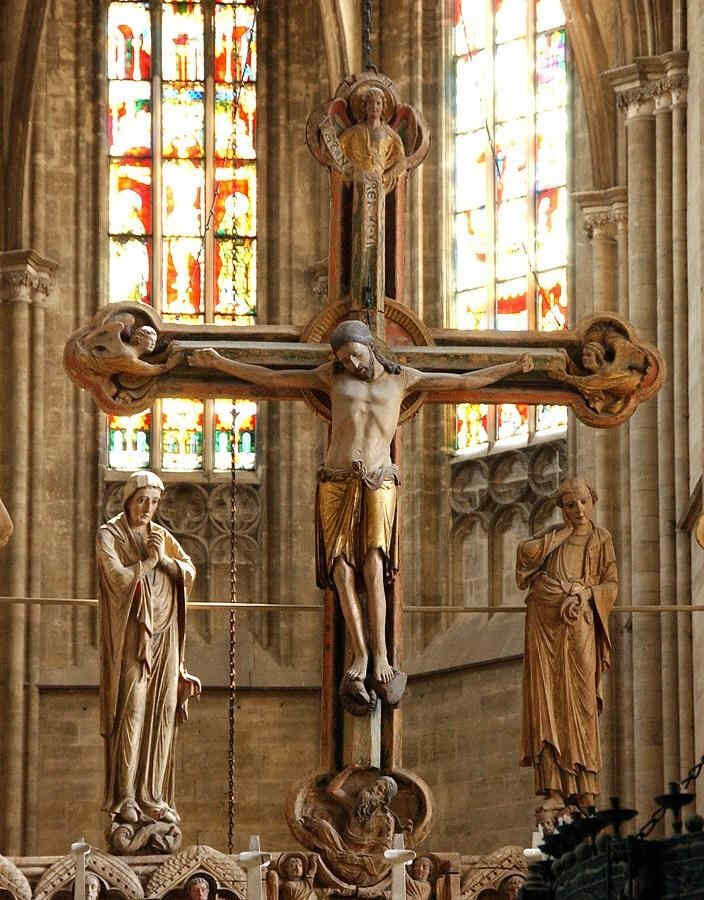 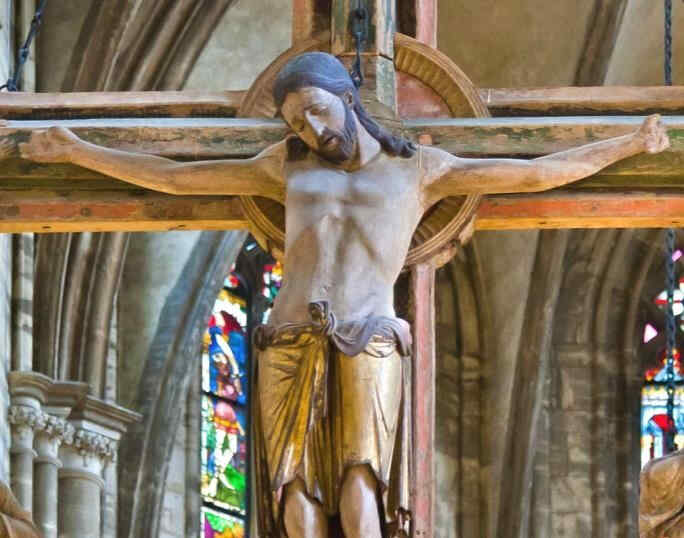 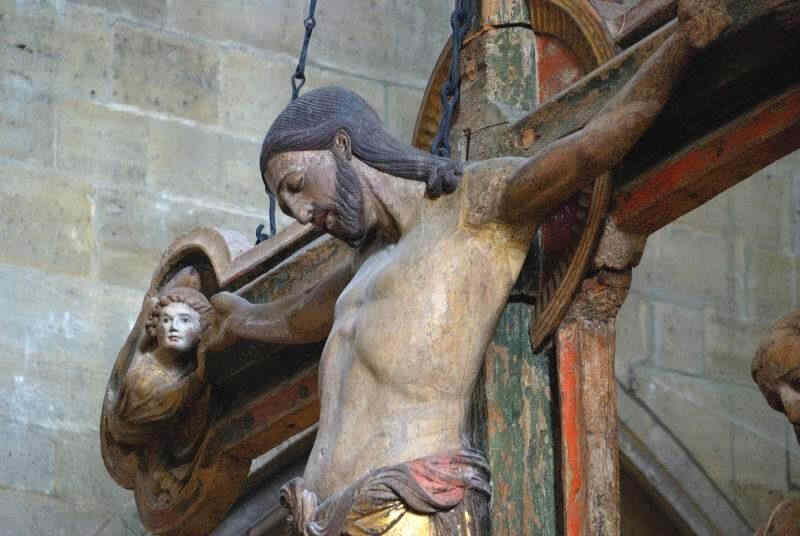 Look at this Crucifixion Group. I will only say one thing to characterise what is most important. In this group you can see how deeply the story of the Passion had found its way into their lives by that time. There is Mary, there is St. John, and in the center the Christ, looking down towards her. If you could see the face you would see an infinite deepening of soul in the expression, an overwhelming depth. In Mary, if you have a feeling for these things, you will recognise at once the flowing together of the more Roman, priestly conception with the Mid-European depth and tenderness of feeling. Here it is recognisable in a most wonderful way. We shall presently show the face of Mary in detail. This group reveals how they contrived, out of the specifically Mid-European creative impulse of the soul, to mould the Christianity which had conquered the Mid-European country. We will now show the detail. 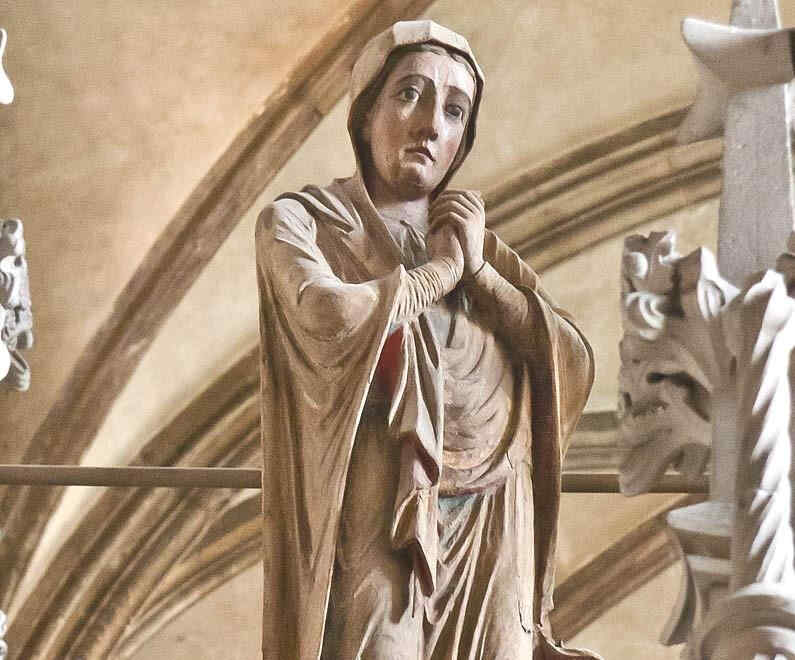 Wonderfully characteristic is the expression of the face. The expression in the Southern Art is such that the eyes look far out into the world; in the Northern Art the soul, as it were, presses forward into the look of the eyes from within. Here the two are altogether interwoven—united with one another. A tenderness of soul in the expressions hovers gently, wonderfully, over a more Latin, Roman rounding and perfection of the features. These things must not be pressed. But I beg of you to observe in all the following pictures how very differently the clothing and drapery is treated in the Mid-European Art and in the Southern. Undoubtedly, such things must not be pressed too far; yet it is true to say that in all the Southern Art the drapery rather surrounds and veils the human form, follows the lines of the form closely, continuing, as it were, the bodily forms. In the Mid-European Art the treatment of the drapery is different. It proceeds from the emotion and movement of the soul. According to the gesture of the hand and the whole attitude of the figure, the quick, mobile life of soul is continued into the raiment. The latter adheres less closely to the body. It does not seek, as in the Southern Art, to veil or to express the forms of the body. It is, rather, like a continuation of the living experience of the soul. You will see this more and more distinctly as we go on into the following centuries. We have now come to the famous: 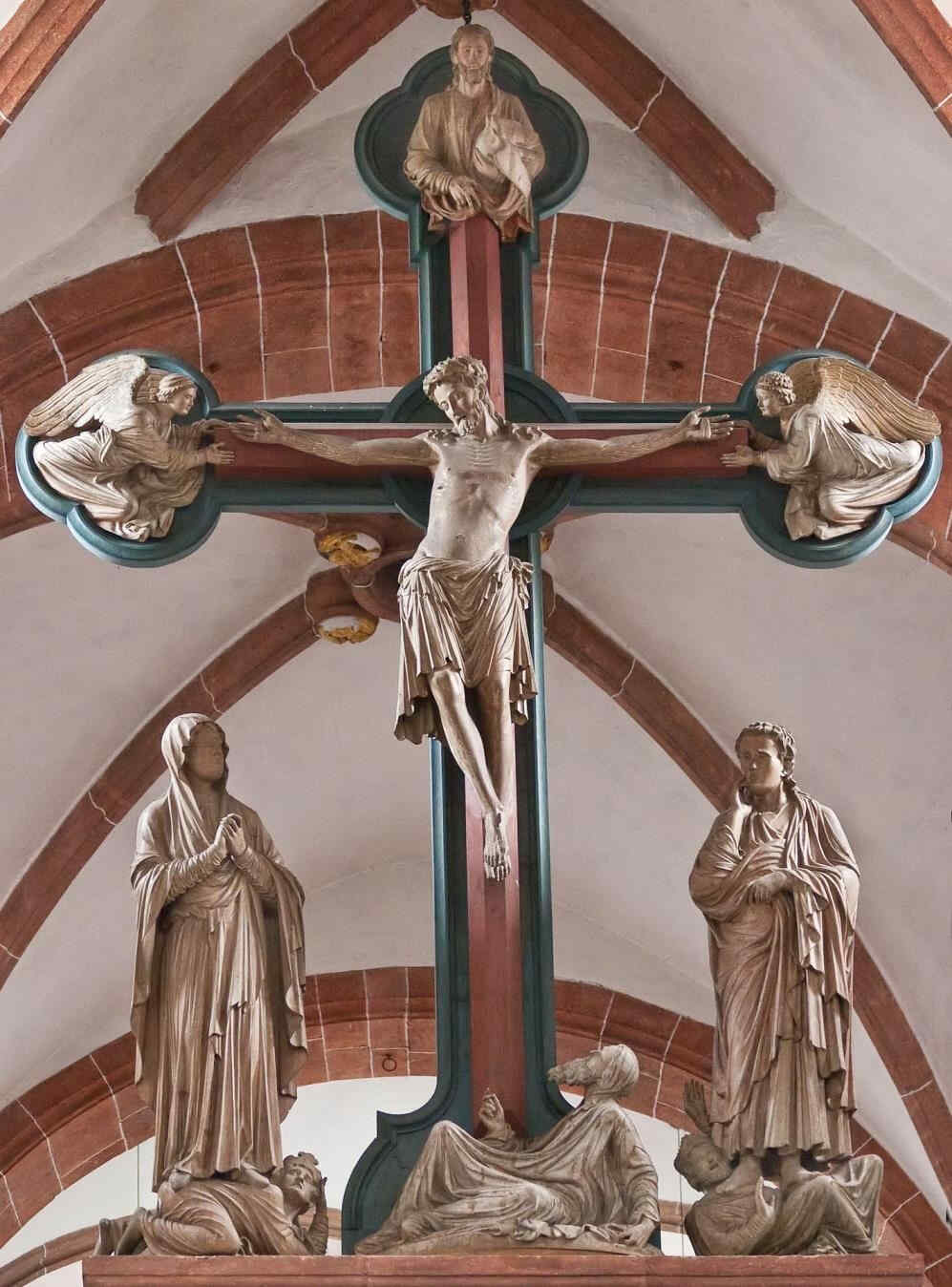 This, too, is in the wood, and dates from the first third of the 13th century. None the less, you will see in it a wonderful progression from the former group whose subject is so similar. Observe the communion of soul between the Mary and the Christ-Figure. See how the faith in the Christian world-conception, deeply united with the human soul, appears in the St. John and in the Mary-Figure, as the power that overcomes all things. The Christian world-conception had entered into the souls of these people so as to become an universal historic conception of all earthly evolution. See how Adam, down here, receives the Blood of the Redeemer dropping downward from the Cross. Study the face of Adam, how he is touched by the influence of Grace which he can now receive inasmuch as he may catch the Blood of the Redeemer flowing from the Cross. You will realise with what infinite depths Christianity had found its may into the lives of these people. It had risen to a universal and truly Cosmic conception. Angels carry the Cross. God the Father descends with the Dove, setting His seal upon the fact that what He had given to the Earth in His Son gives, at this moment, the whole Earth its meaning. In this group with all its artistic perfection we see how deeply Christianity had found its way into Middle Europe,because they tried again and again to permeate it with the human heart and feeling,—to permeate it from within the human soul. On the other hand, in the South, it was permeated by fancy and imagination, thus producing that peculiar permeation, so free from the moral element—(or shall we say, in order not to give offence, so free from moral cant)—which comes to expression in the Renaissance in the South. If you were to make a study of the progress in the representation of the Christ-Figure, this Head of Christ would be an important station. Also the Head of Christ in the Cathedral of Amiens, and afterwards, the Head of Christ by Albrecht Dürer. 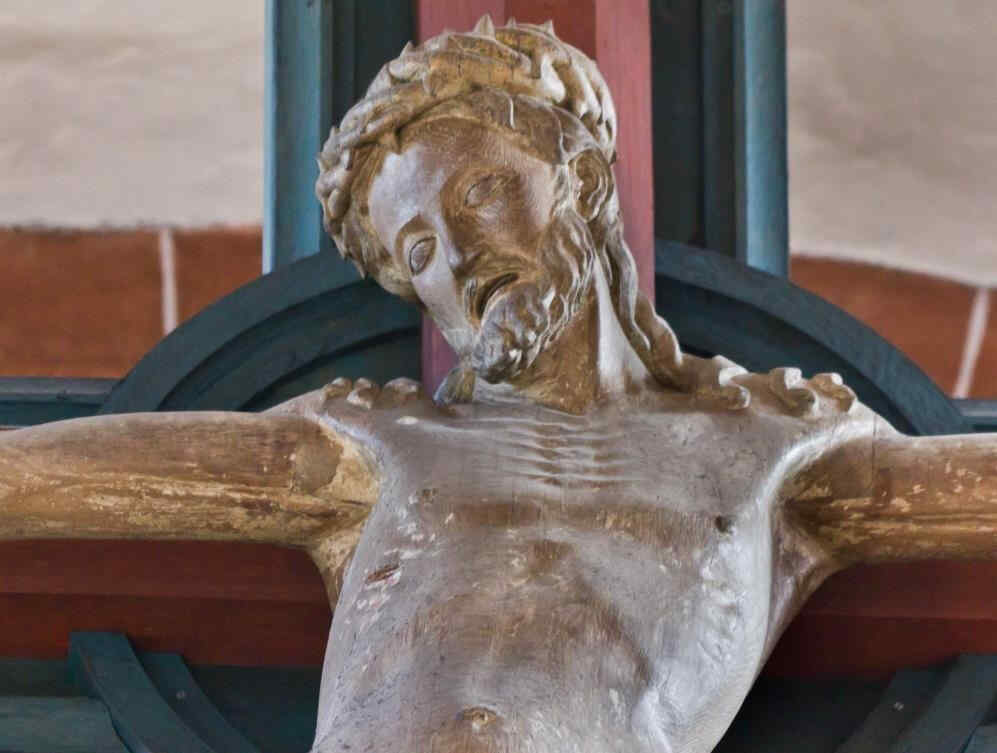 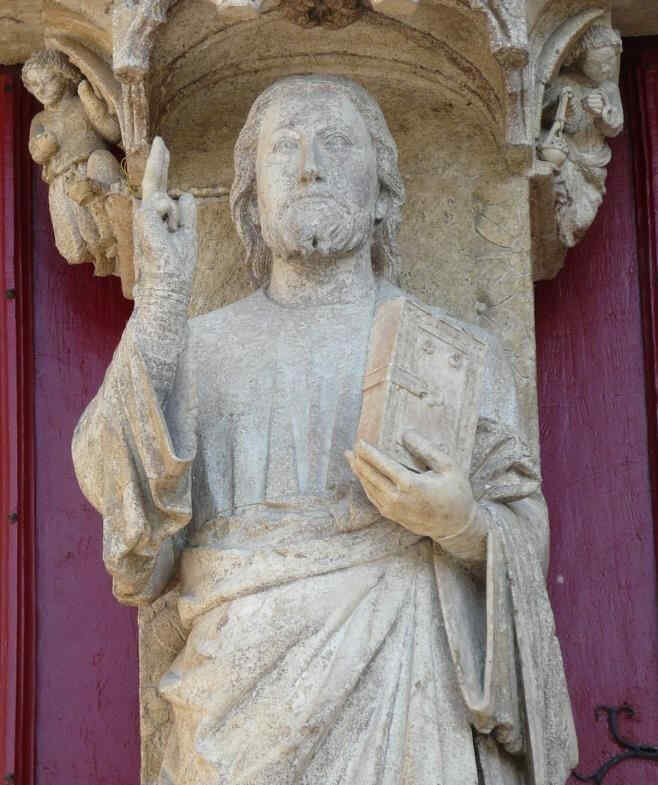 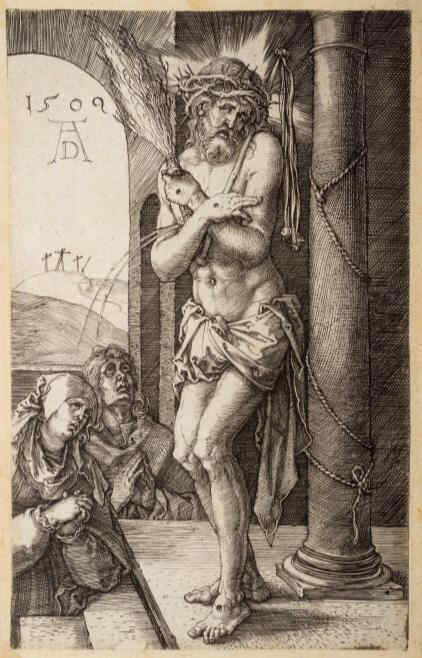 We now pass to some sculptures which are found at Freiburg in Saxony, also dating from the first third of the 13th century. They show an altogether different aspect, though here, too, it is the sacred history, and a deep striving for inwardness. It is not too much to say that one loves to dwell on every single face. The next picture:  (St. Mary's Cathedral, Freiburg.) shows us two figures. The one, the figure of a woman, is hard to interpret. Perhaps she is an “Ecclesia.” The other is said to be Aaron. These things are not essential. The figures are undoubtedly connected, allegorically or in some other way, with the Christian world-conception. Once more, observe the deepening of the soul's life. The contrast of expression between the face on the left, and that on the right is particularly fascinating from this point of view. 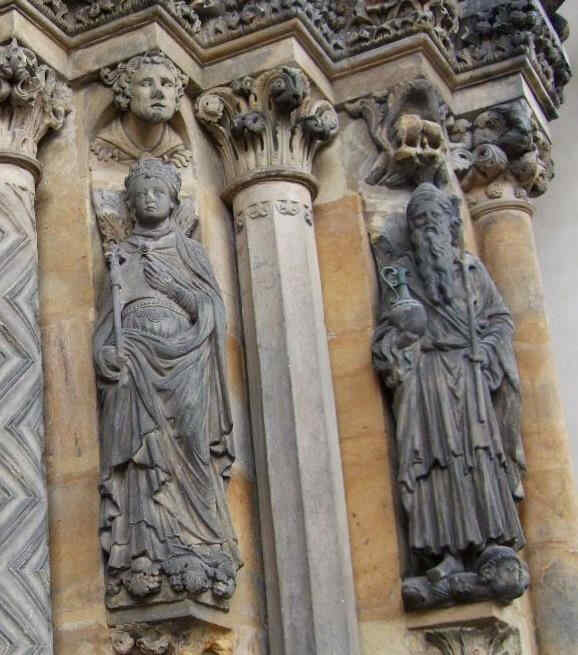 Supplementing what we showed last time of the Cathedrals at Naumburg and Strasburg, we will now show some sculptures from the Cathedral at Bamberg. Here, to begin with, we have two. 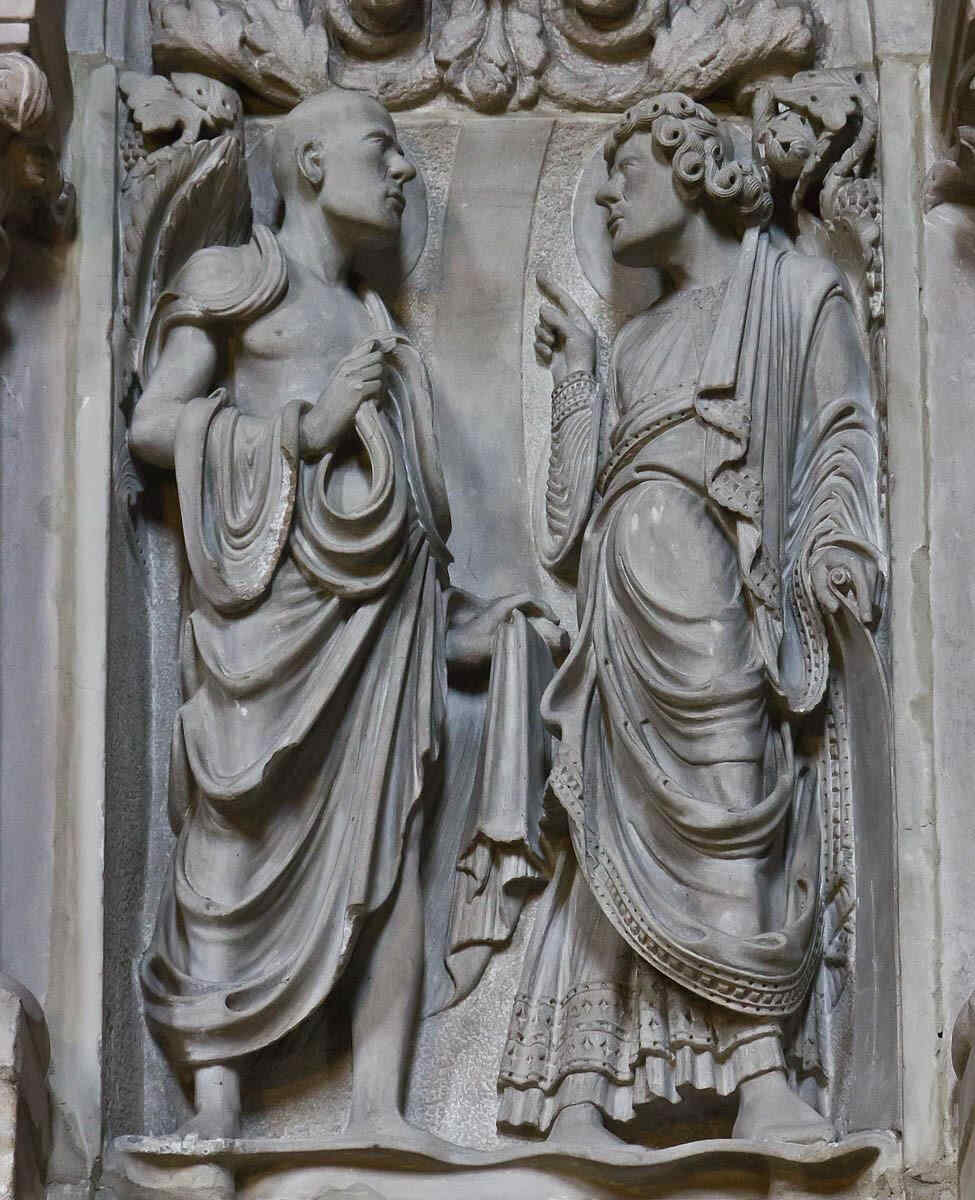 See how directly the dramatic element, the living movement of soul, is expressed in the attitudes, representing the interchange between one soul and another. C. single moment is presented to us, while at the same time the two contrasting characters are well expressed.  The composition is by no means great, but the expressiveness of soul is marvellous. He must remember that this dates from about 1240. Spiritual scientific research will in course of time be confirmed, in that it does not suggest—as many people still do today—that the Mid-European element, in its presentation of the Christian world-conception, was in any high degree influenced by the Southern. That, indeed, is not the case. On the contrary, the very opposite is true. The different streams are not as yet clearly seen by external history. It is not seen, for instance, what I pointed out the other day—how the Northern impulses worked down even into the creations of Raphael and Michelangelo. Artistically, this conception is altogether a product of the Northern spirit. 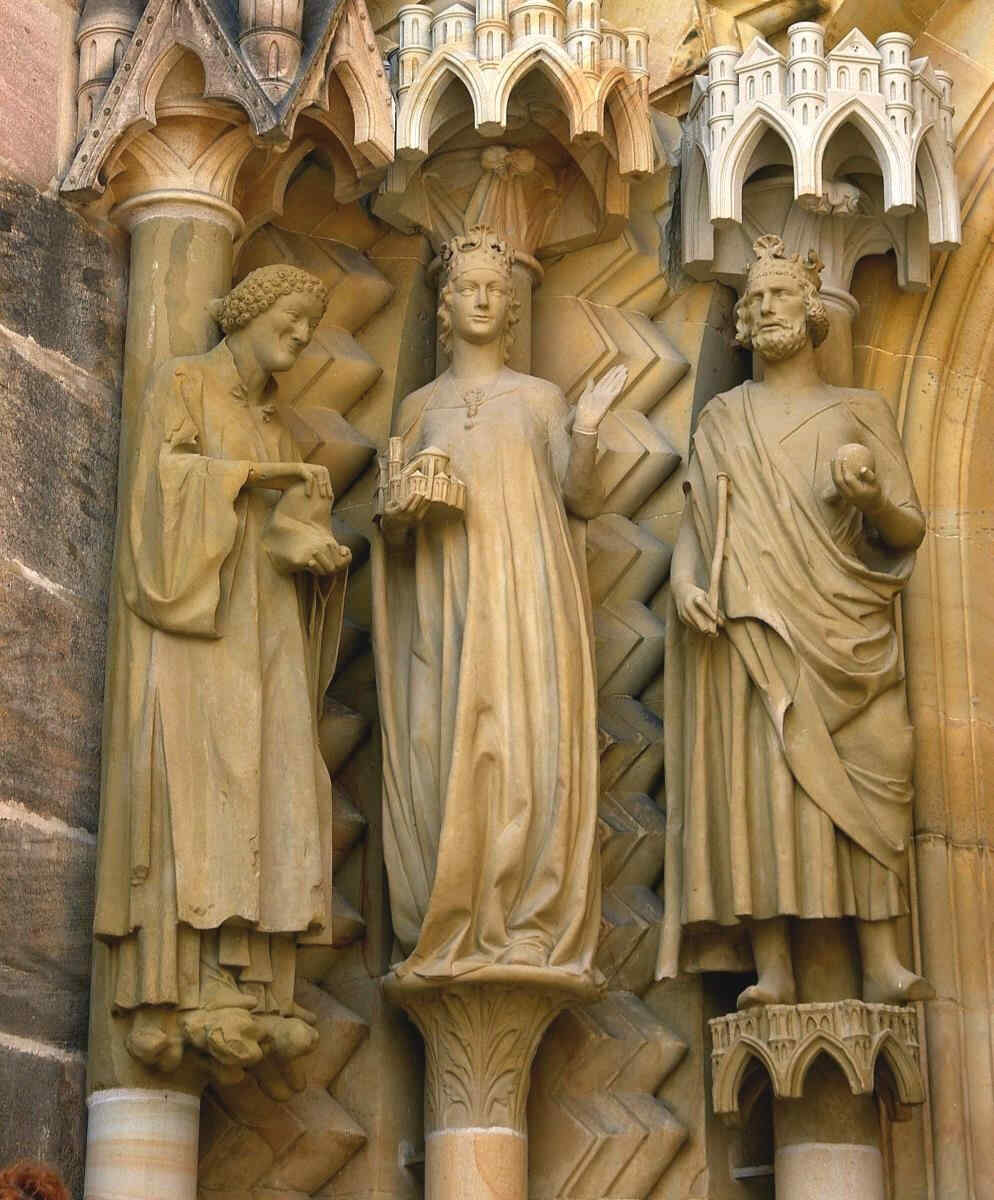 This example shows how the worldly and the religious elements played into one another. This was, indeed, the case, especially at the time with which we are now dealing. The worldly and the religious were brought together in the effort which I characterised just now. The souls of men had to be won over; the individual souls must first be called—must by some means be gathered together, if they are to look up in community, in congregation, to the spiritual world. Likewise, they must first be called if they are to express reverence in one way or another, for something in the outer worldly sphere. Hence the worldly is brought together with the ecclesiastical element. Here, then, we see the Emperor Heinrich, the Empress Kunigunde, and, on the left, St. Stephen. Needless to say, these things presuppose, as a rule, the naivete of the common people, their blind devotion and dependence. Today, in the fond belief of our contemporaries, these things are overcome. Inwardly, they are present all the more. On the part of the great lords themselves there is very frequently the underlying idea (not unconnected with very human qualities, which shall be nameless), that they themselves stand just a little nearer to the various Saints and supersensible powers than ordinary mortals do. 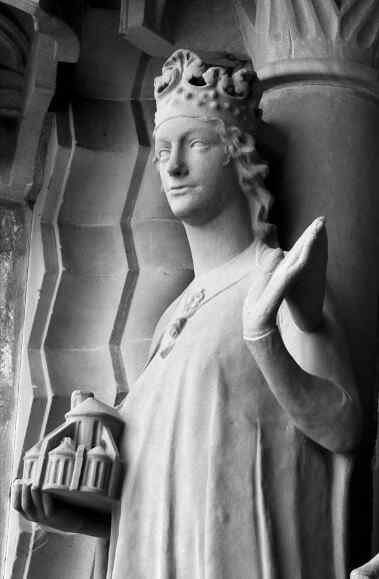  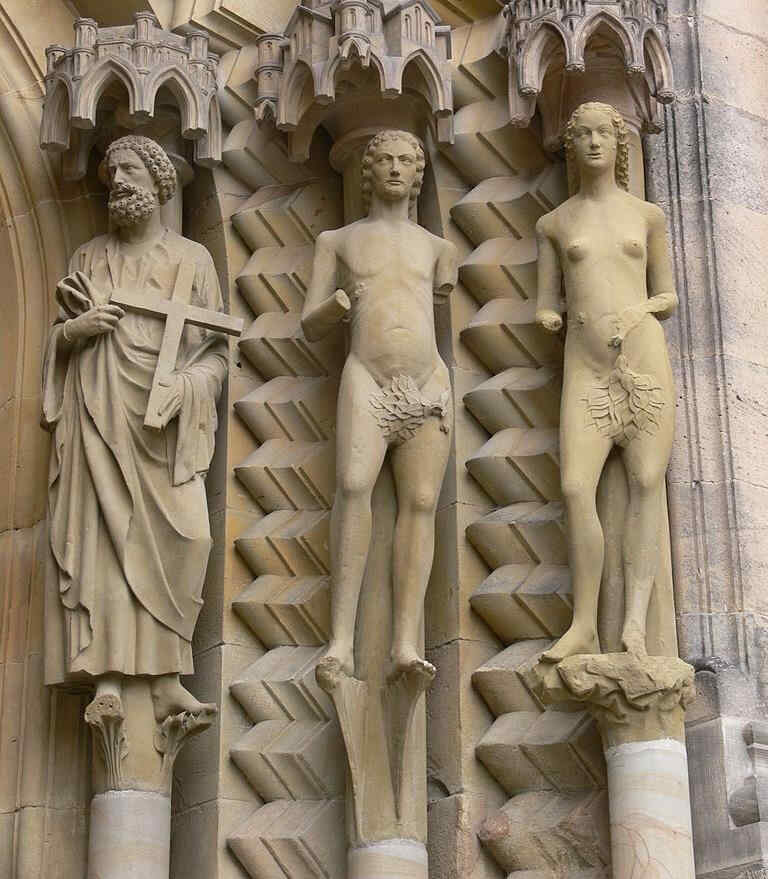 The Old and the New Testament were always conceived in unison, as the promise and the fulfilment. Follow the detail of these figures. 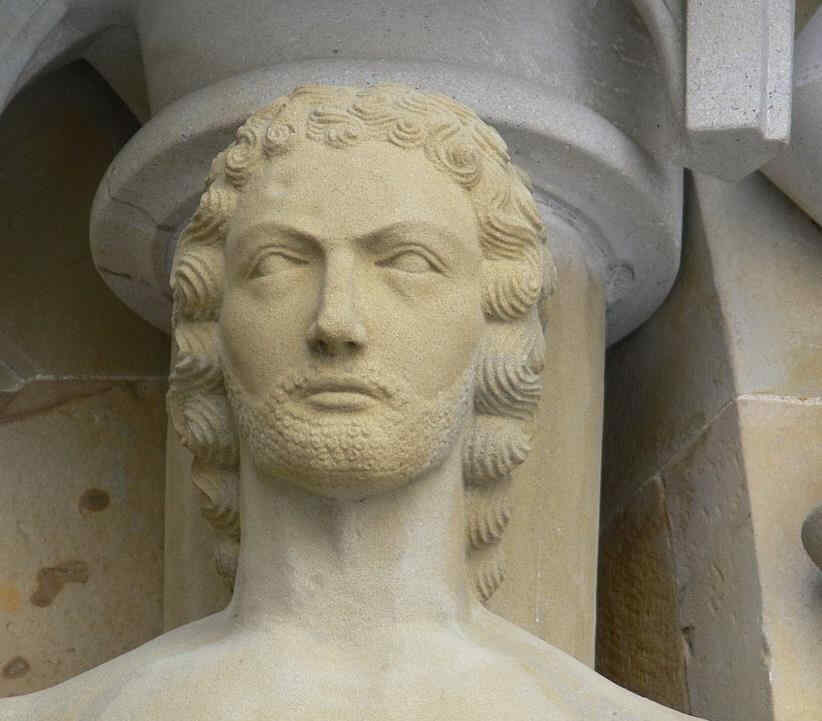 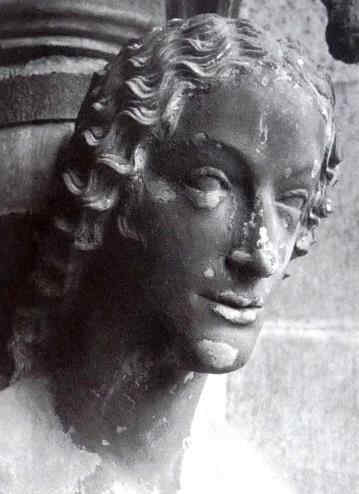  And now another figure from the same Cathedral.  A figure of Mary, showing—from whatever point of view you may consider it—how richly the qualities which I described before, come to expression in this stream of Art. You must remember that this was done about the year 1245. What would you look for in the South at that time? The next Picture, from the Cathedral at Bamberg again, represents the figure of: 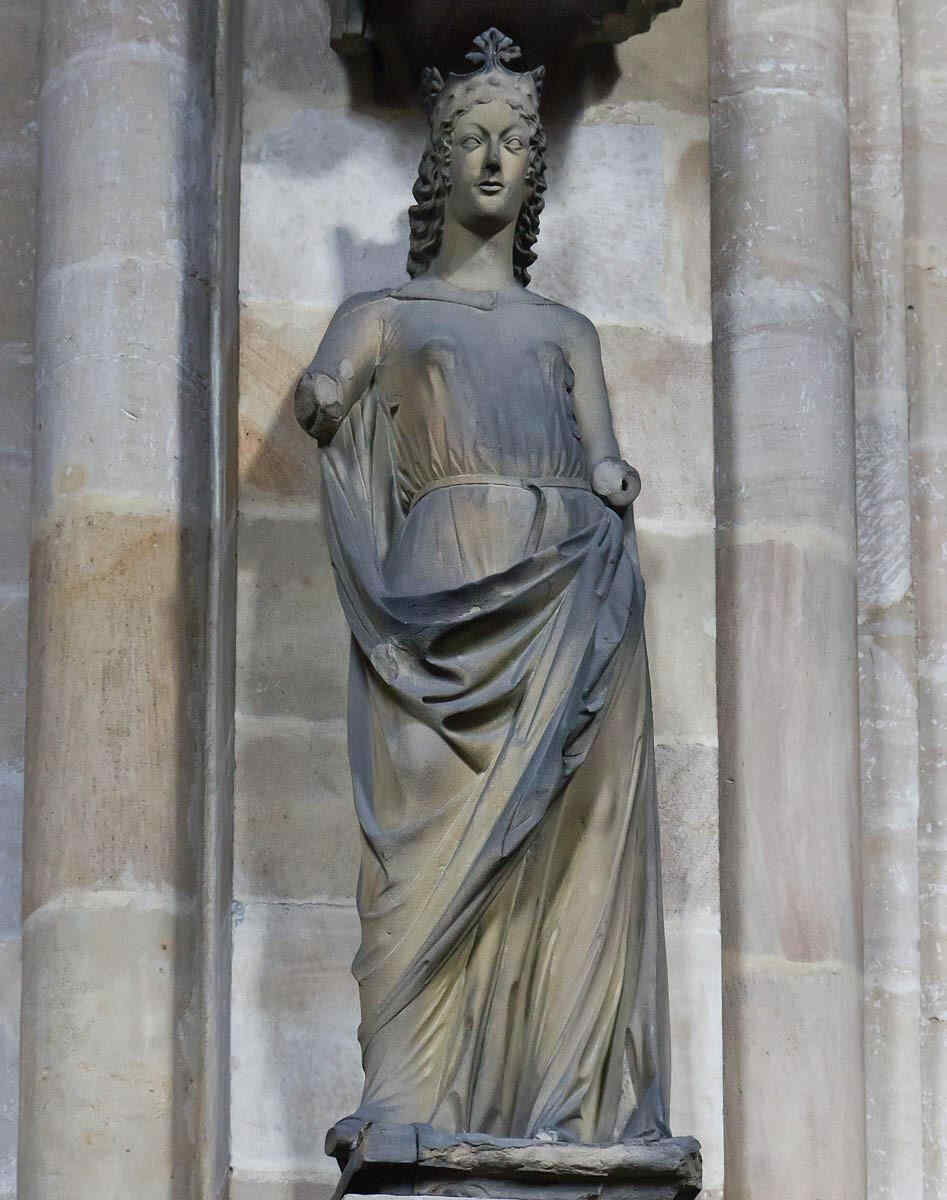 A favorite representation at that time. Last time we saw the corresponding figure from the Cathedral at Strasburg. The figure of the Church is conceived with a certain inner freedom. Her soul is free, she gazes freely far into the world, with wisdom. 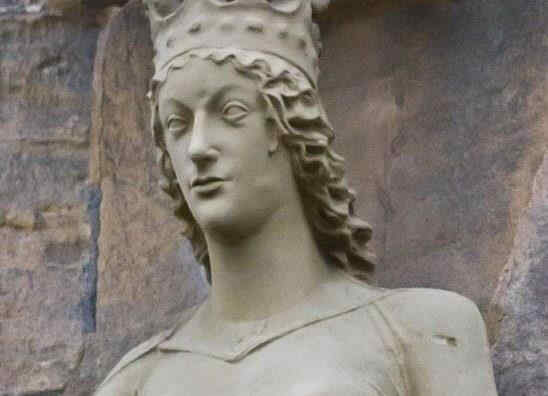 This figure is in contrast, as we saw last time, with the Synagogue, who is represented once more with bound and downcast eyes. The whole posture is intended to represent this contrast in every detail, even to the sweep of the drapery.  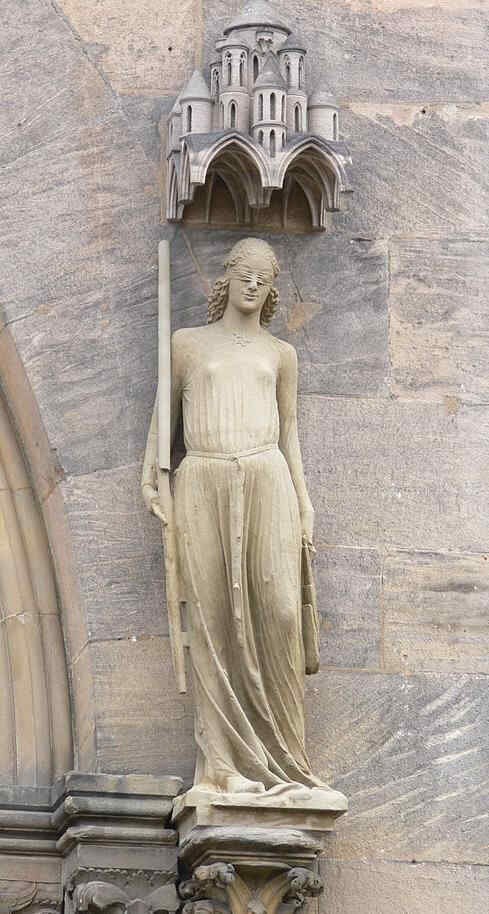 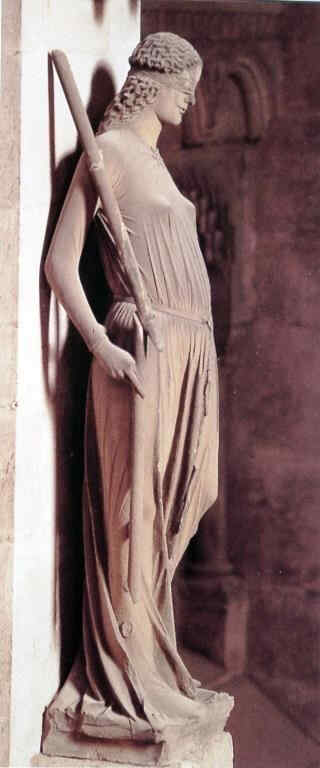 Look at the lower portion of the dress, how well it is adapted to the movement of the soul. We will insert the 'Church' once more, in order that you may compare the draperies:  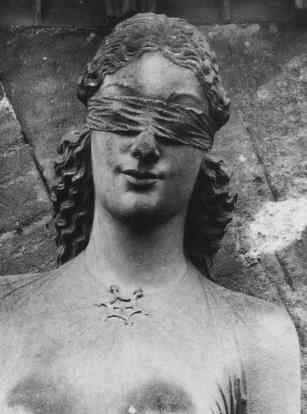 And now a worldly, or secular figure from the same Cathedral. 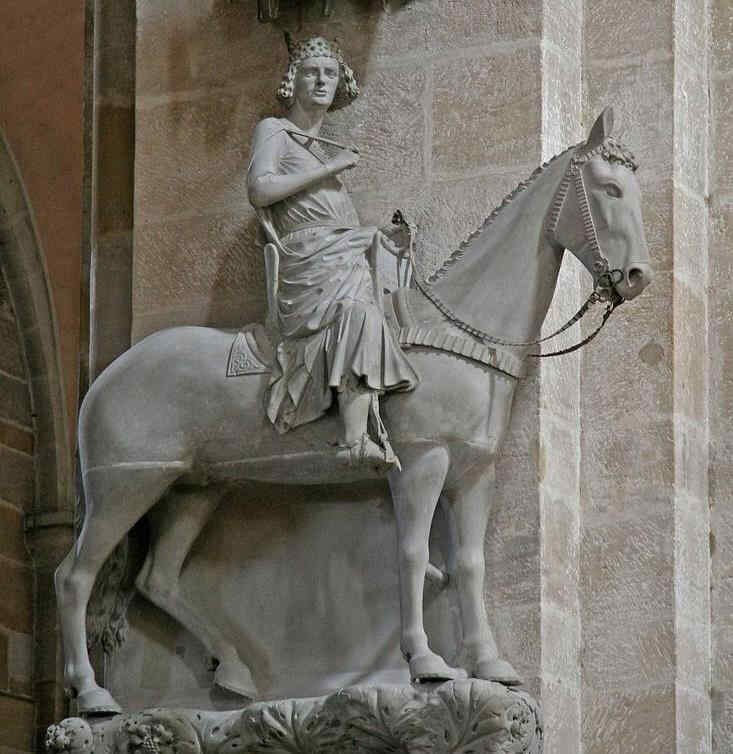 Study the expression well. The head, which we will now show in detail, is most wonderful:  We now pass on to the 14th century, and see what had occurred by that time. We have a few figures from the Cathedral at Cologne, first half of the 14th century. 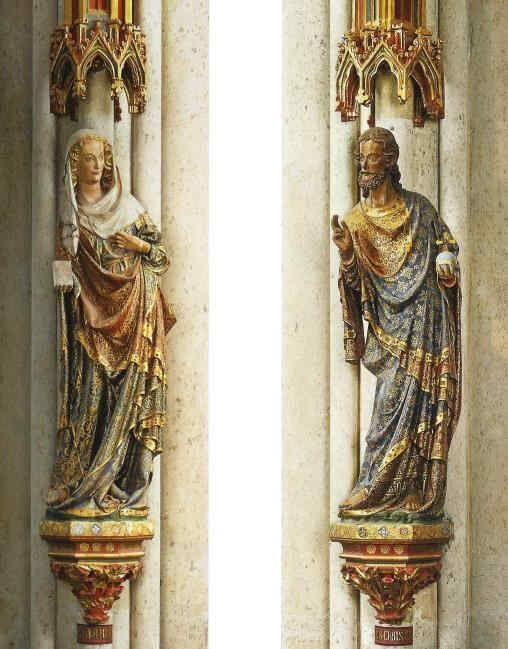  It is easy to see that a certain decline had taken place. The next picture is also from Cologne: 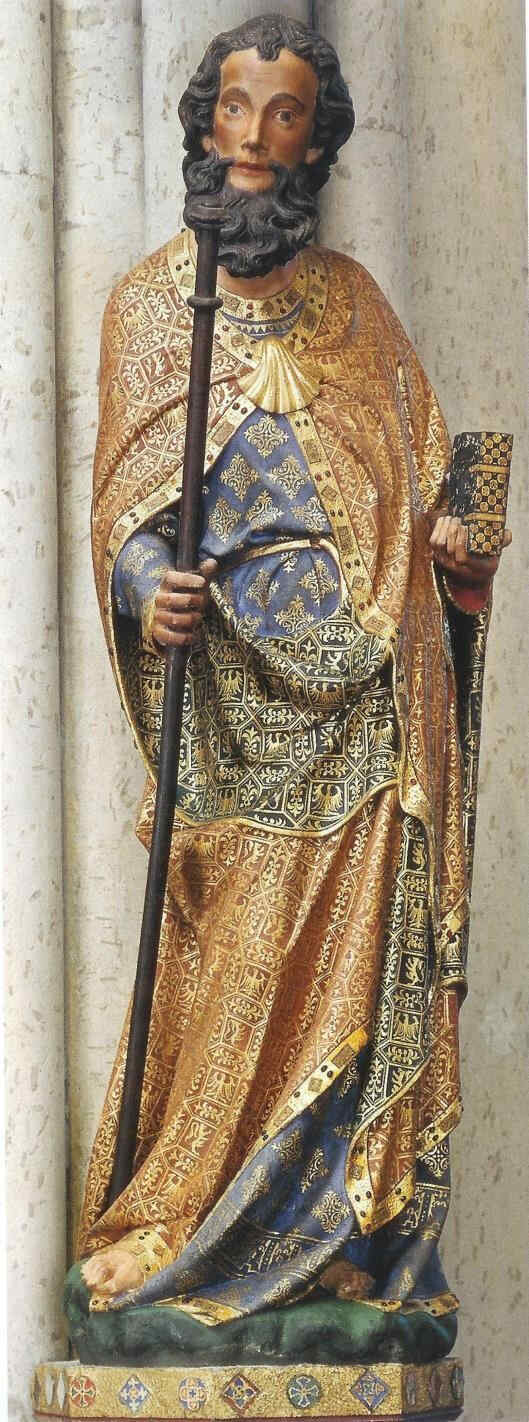  Going further in the 14th century we now come to a figure of St. Paul by a master known as the “Master of the Clay Figures.” These figures were executed in burnt earthenware. 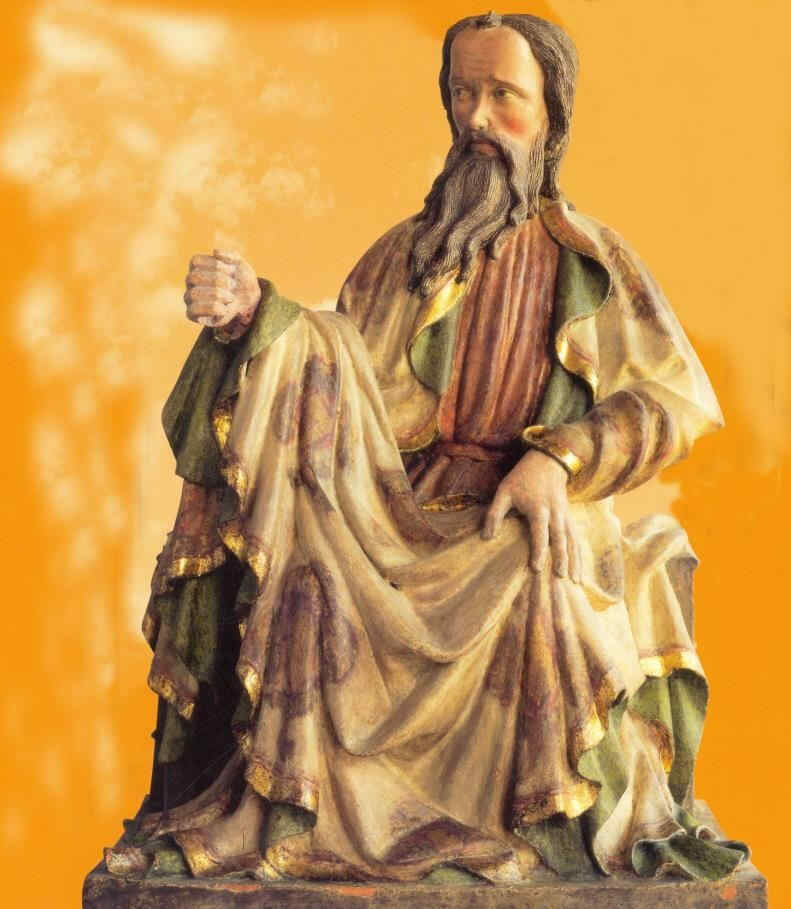 Having now shown the rise, and to some extent the decline of a stream of evolution complete in itself, we will give a series of pictures from the Chartreuse de Champmol at Dijon, which are really great of their kind. Most, if not all of them are the independent work of the Dutch sculptor, Sluter, or else done under his direction. He brought to the Chartreuse at Dijon, from the Netherlands, an almost unique power of individual characterisation. From many points of view we see this individualising tendency in his work. 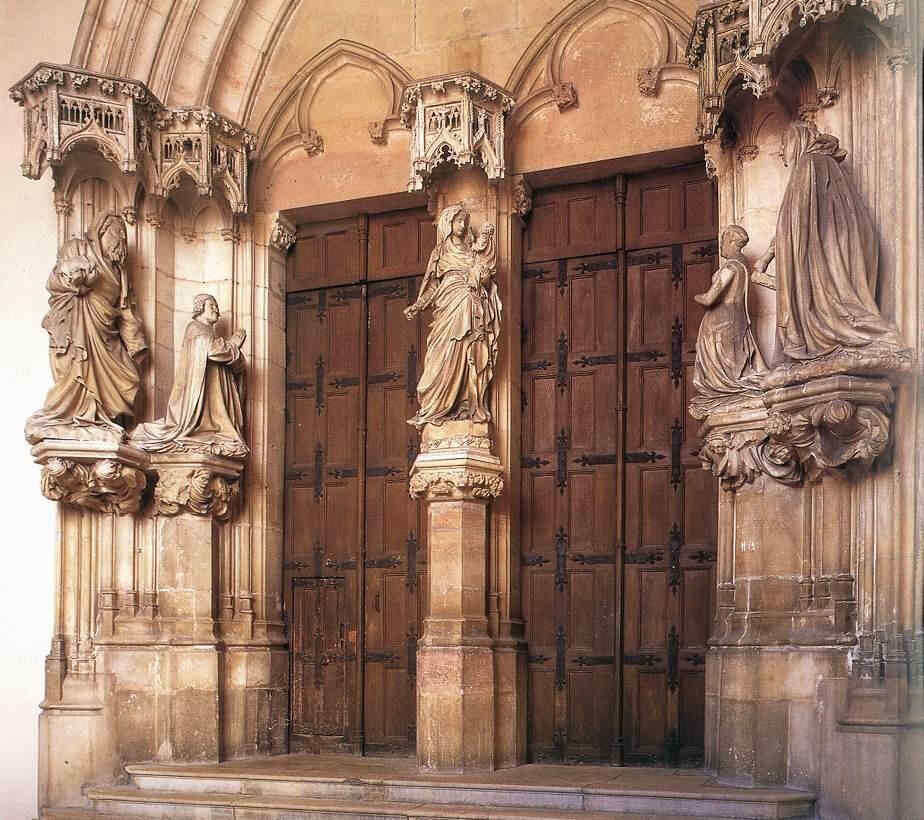 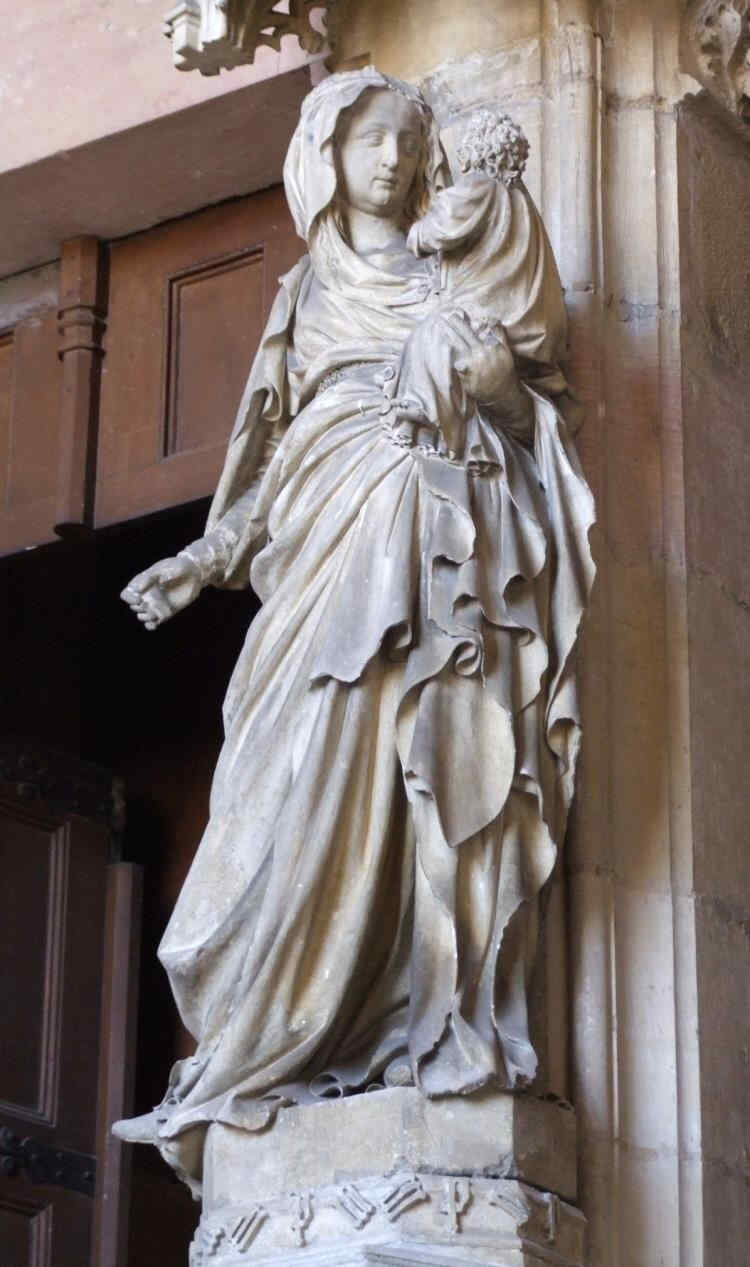 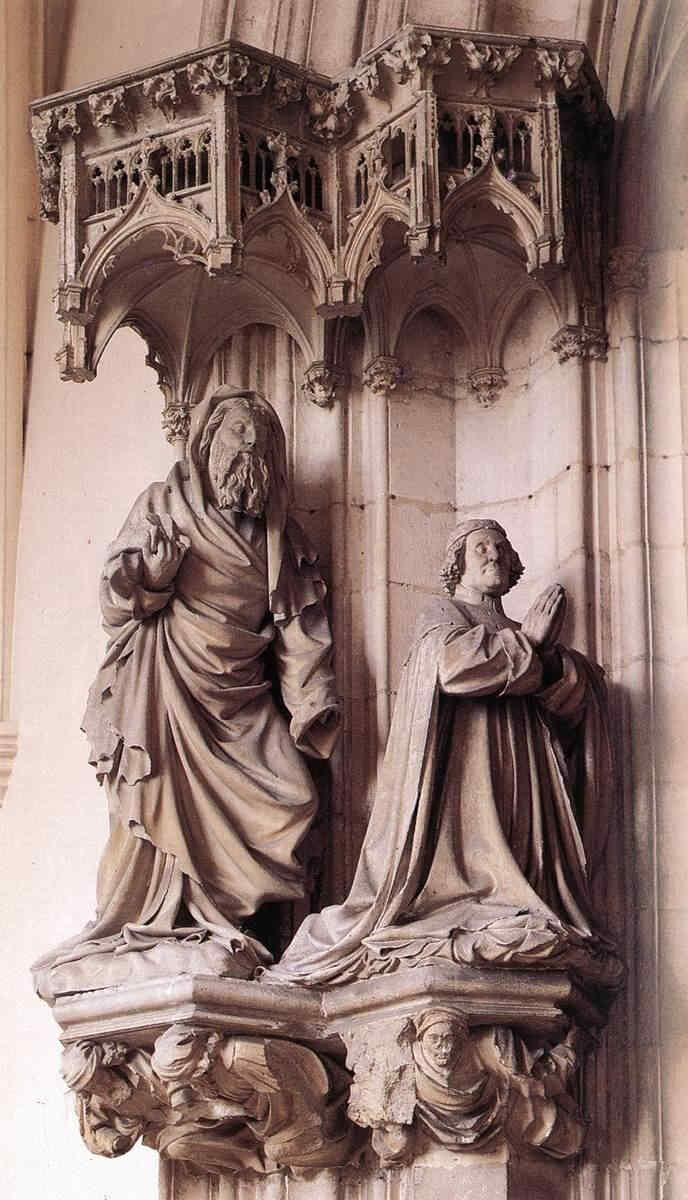 Here especially you see the Art of individual characterisation. Compare this Madonna and Child of Sluter's with the next picture (Moses) and realise the power of one and the same man to characterise these two. 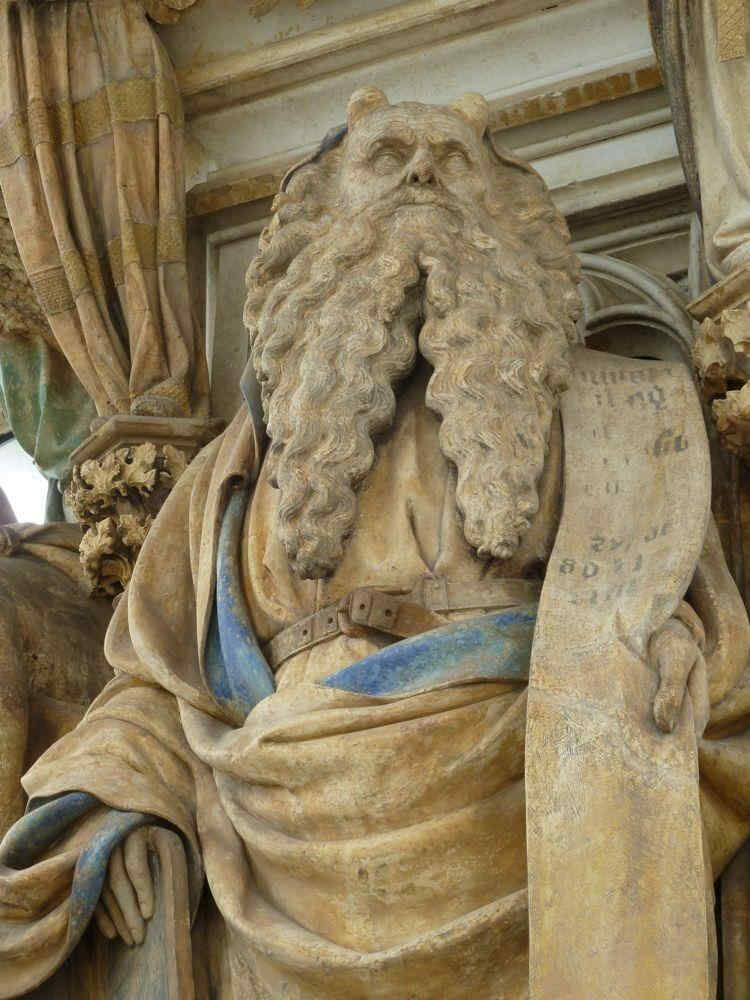 Remember that this Chartreuse at Dijon was built in 1306 to 1334; it was therefore the beginning of the 14th century. Compare this with Michelangelo's Moses—for why should these things not be placed together—they are, indeed, comparable. 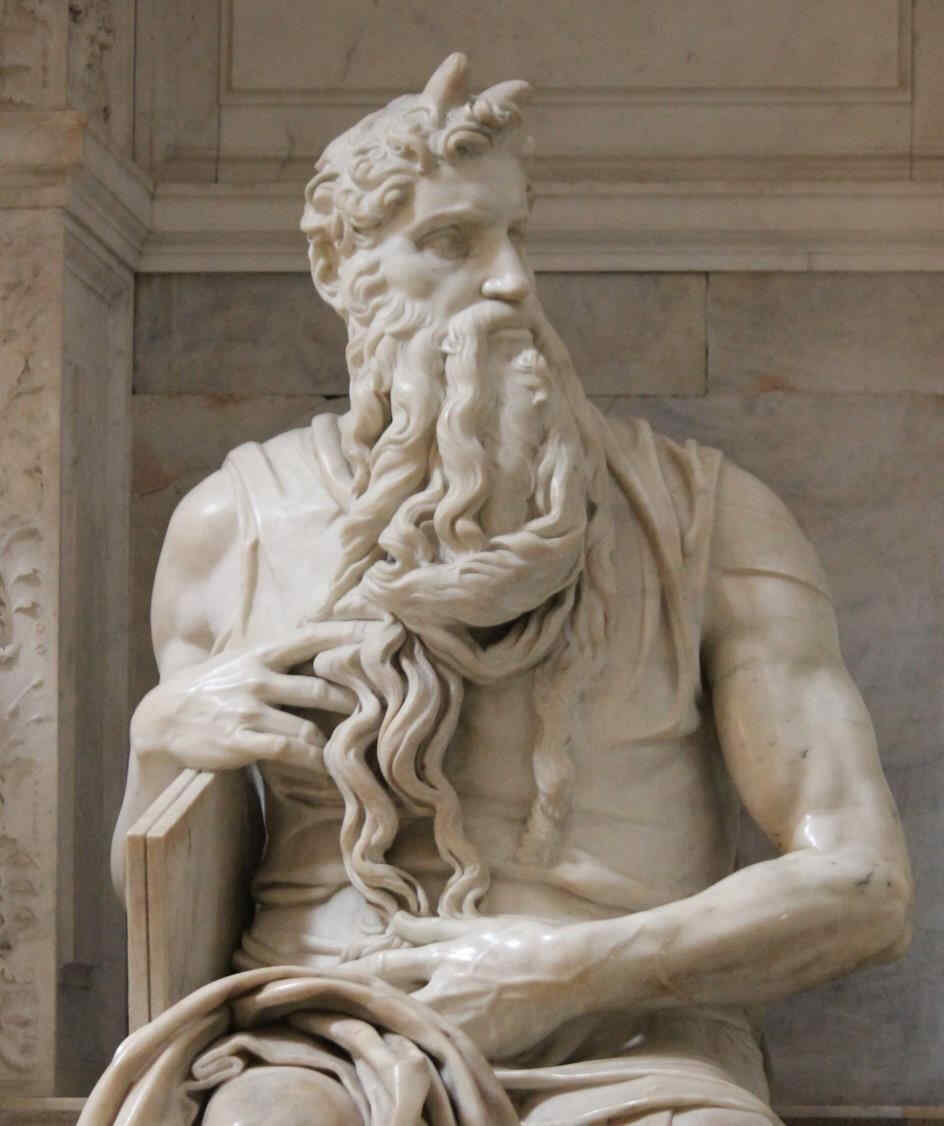 And now by the same artist as before—Sluter. 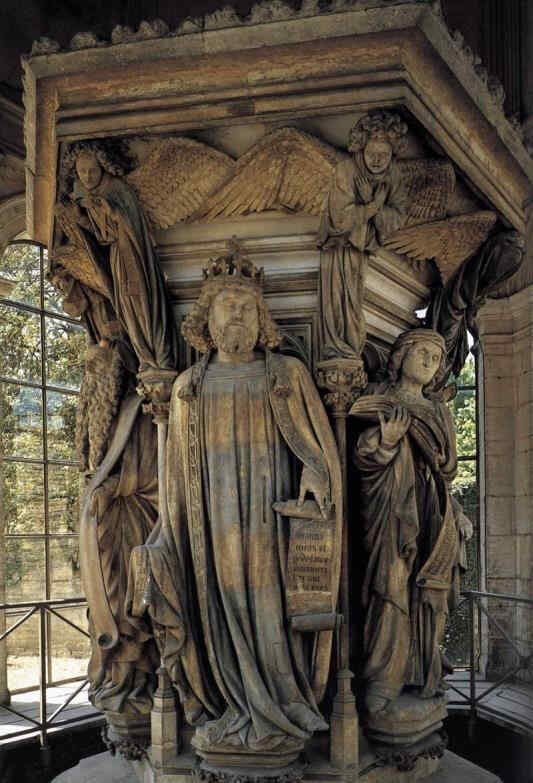  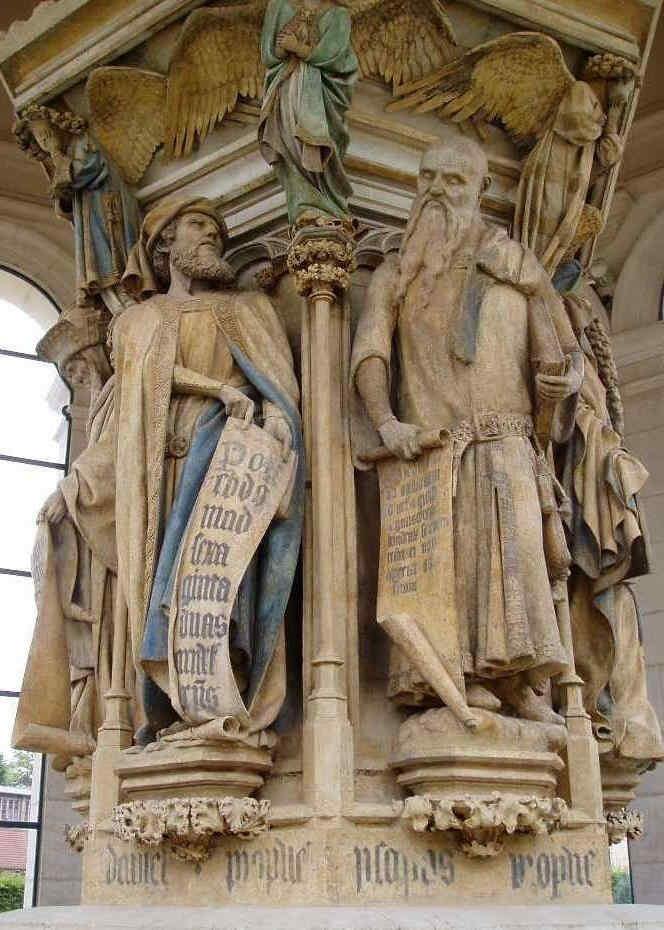 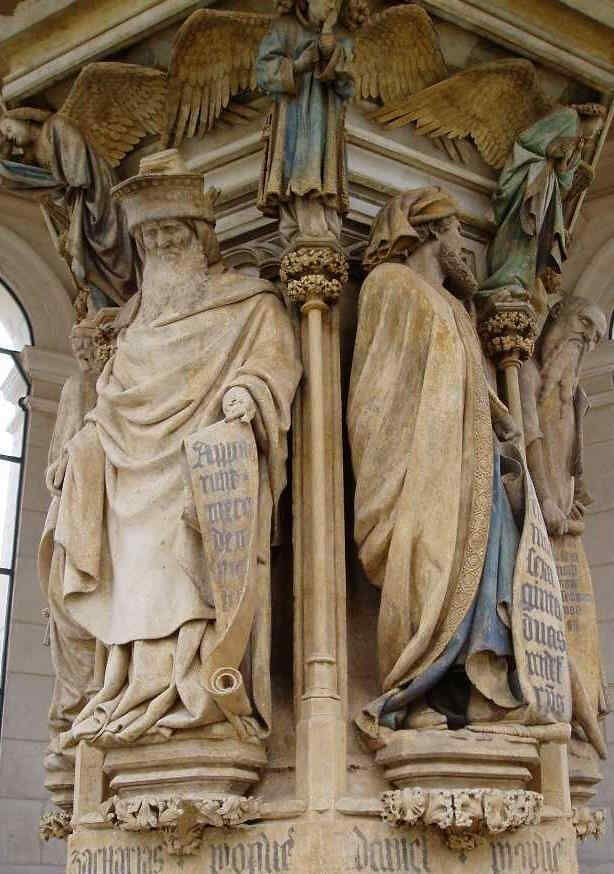 To live with the prophetic figures so as to achieve this degree of individualisation, was, indeed, most wonderful. We will now show one of the figures in detail: 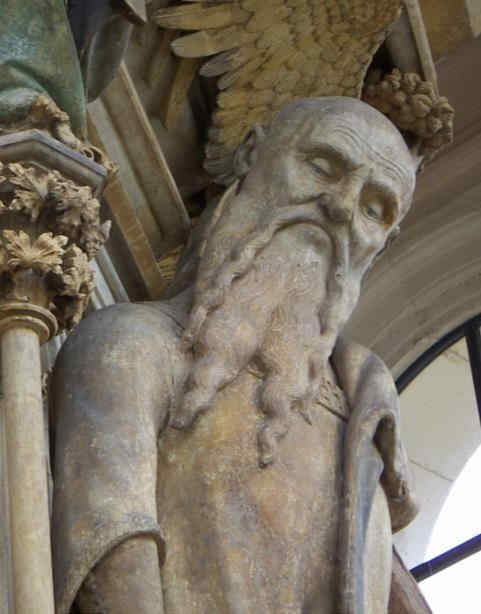 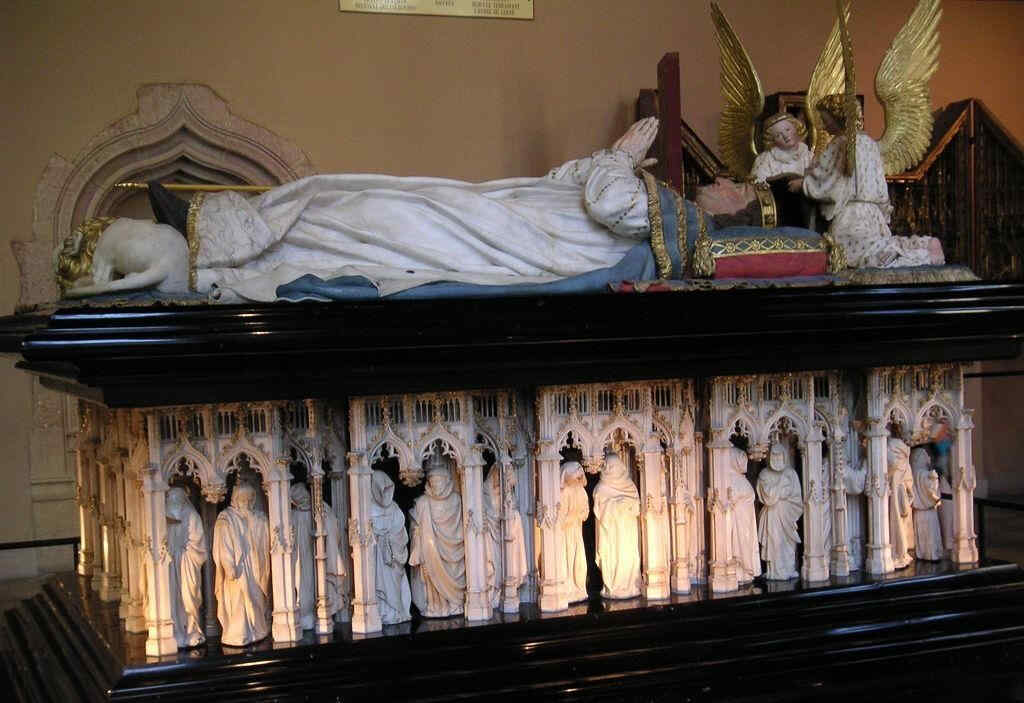 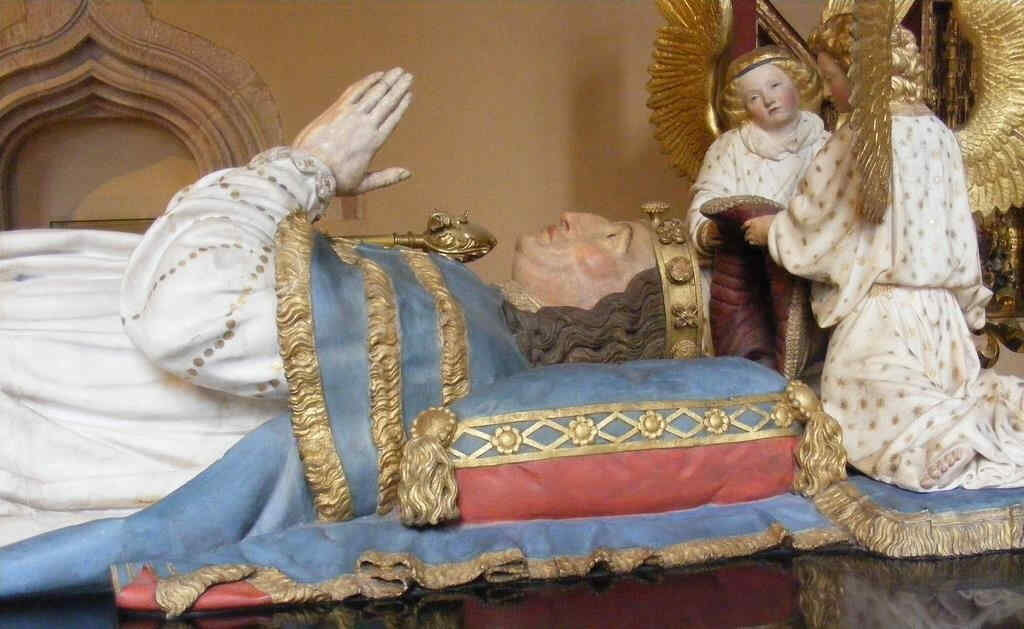 These are by the same artist. The age was especially great in the creation of tomb monuments. We will show the detail of the upper part:  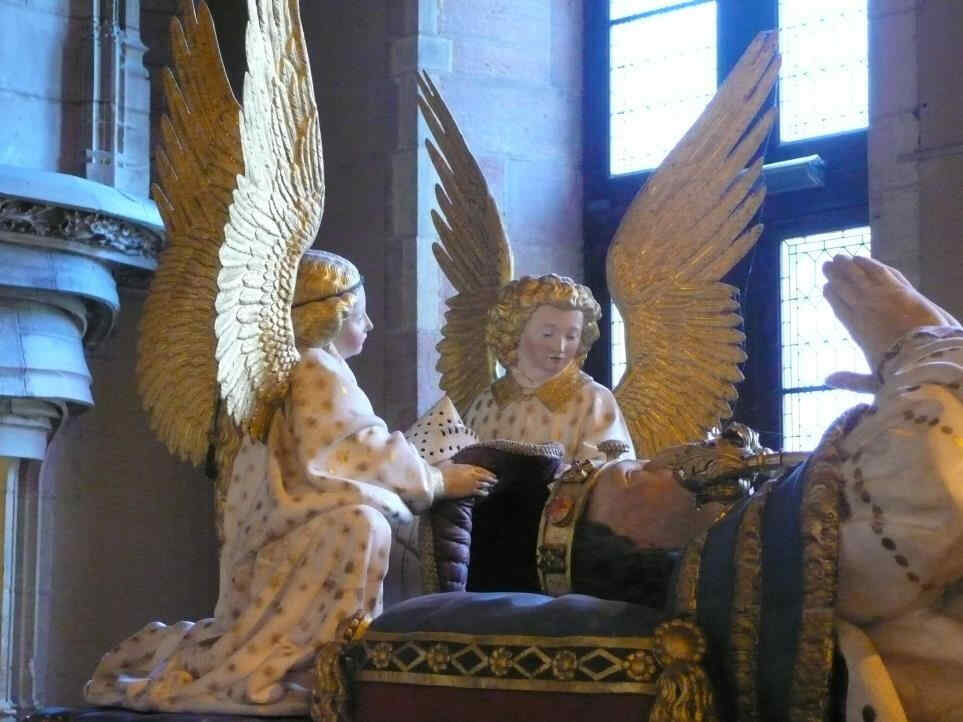 The figures round the base of the tomb which were formerly so small, are wonderfully executed when you come to see them in detail. 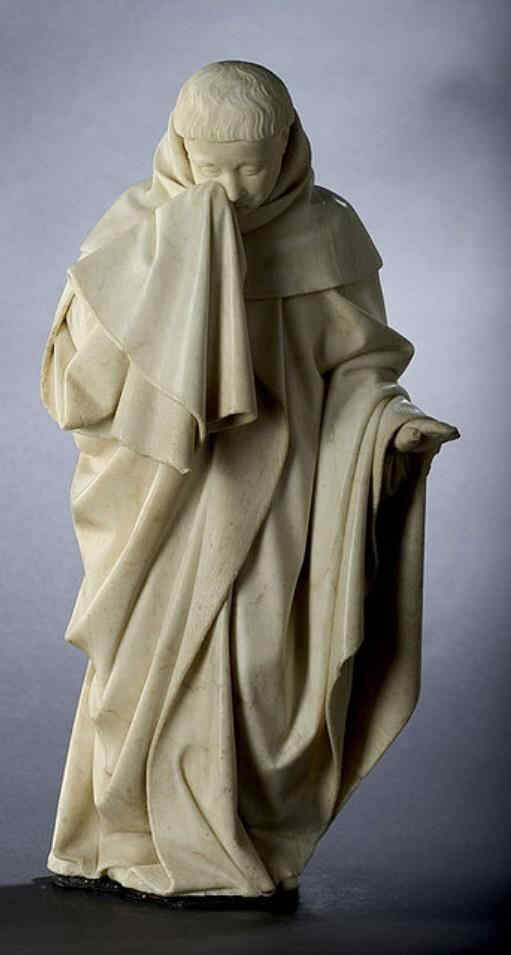 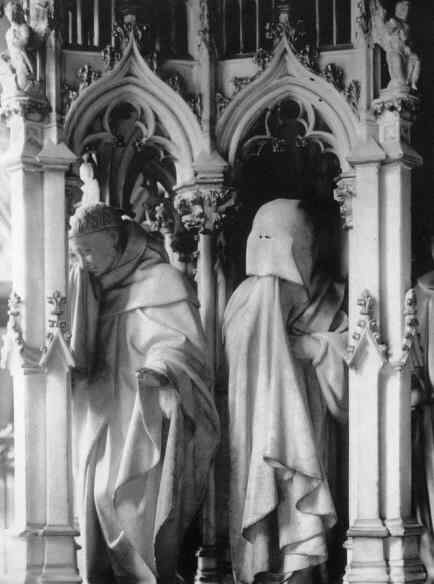 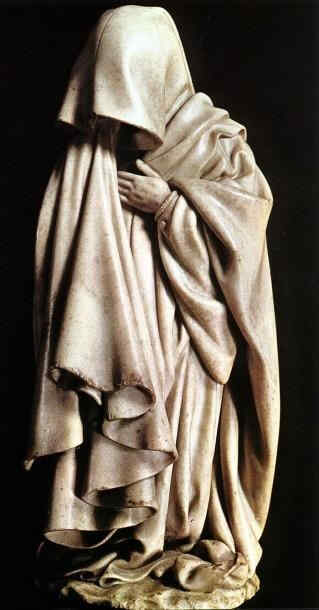 Such is the individual characterisation of all the single figures round the base of the tomb. Here is another group. 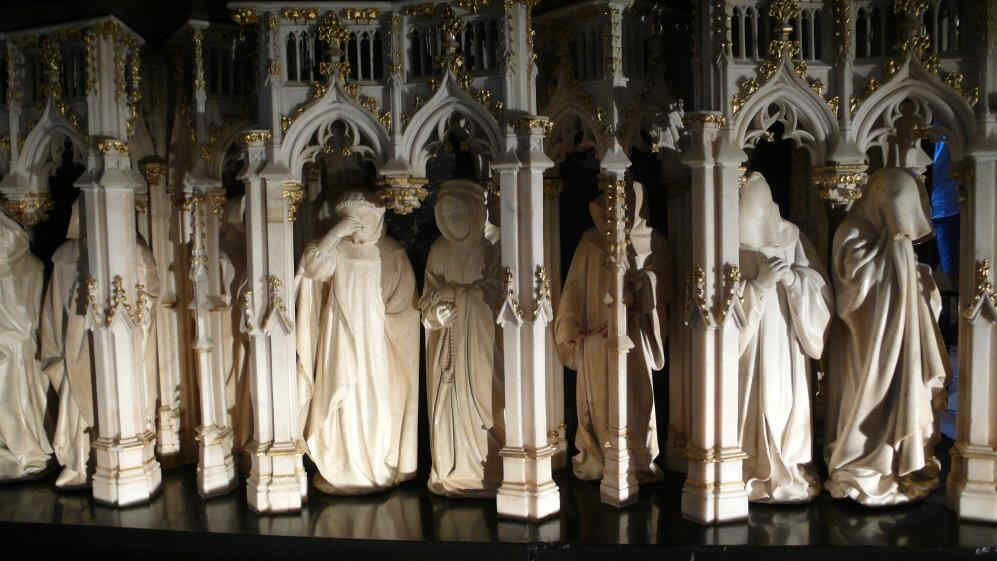  We now go on to an artist of the 15th century. (We must go according to the pictures we possess at the moment.) The last pictures, you remember, were by an artist of the early 14th century. With the Cologne Master, and the Master of the Clay Figures who made the group we saw before, we came to the 14th century. We now pass on into the 15th. Here, then, we have two figures by Hans Multscher: 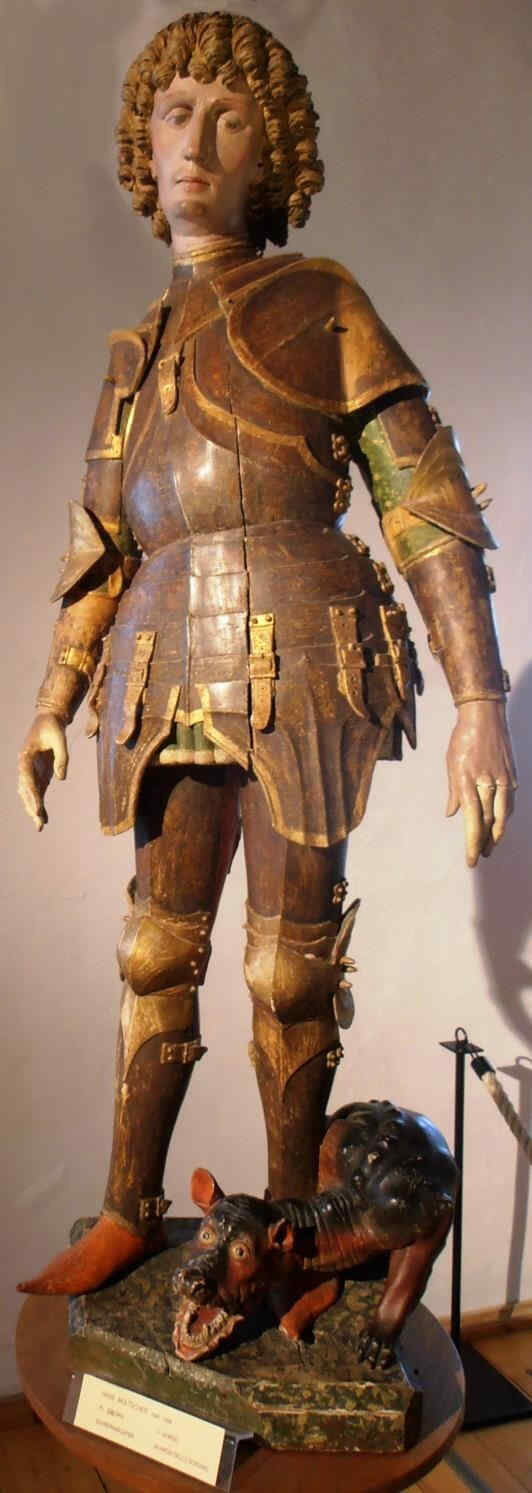 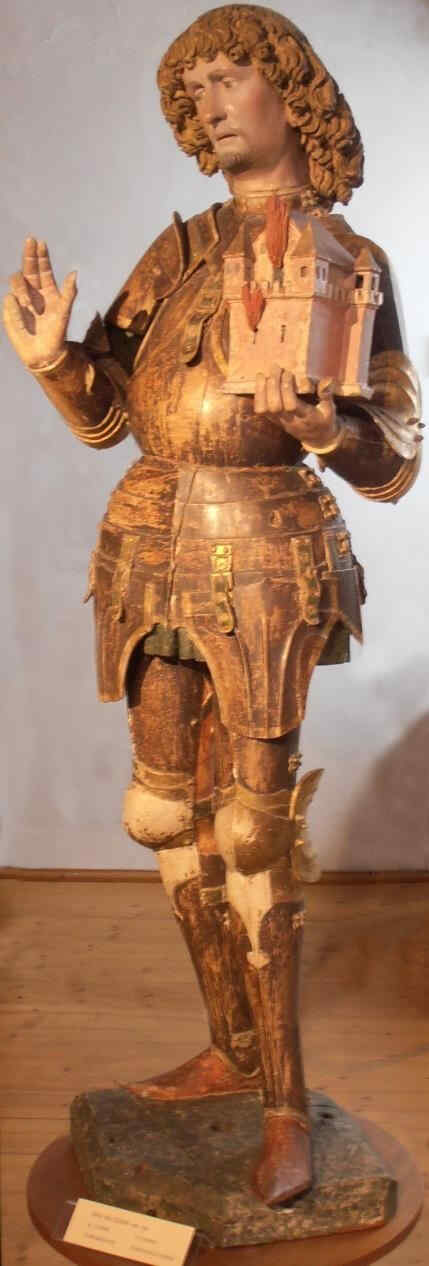 This is about the middle of the 15th century. The next is a Madonna, by the same artist (Multscher). 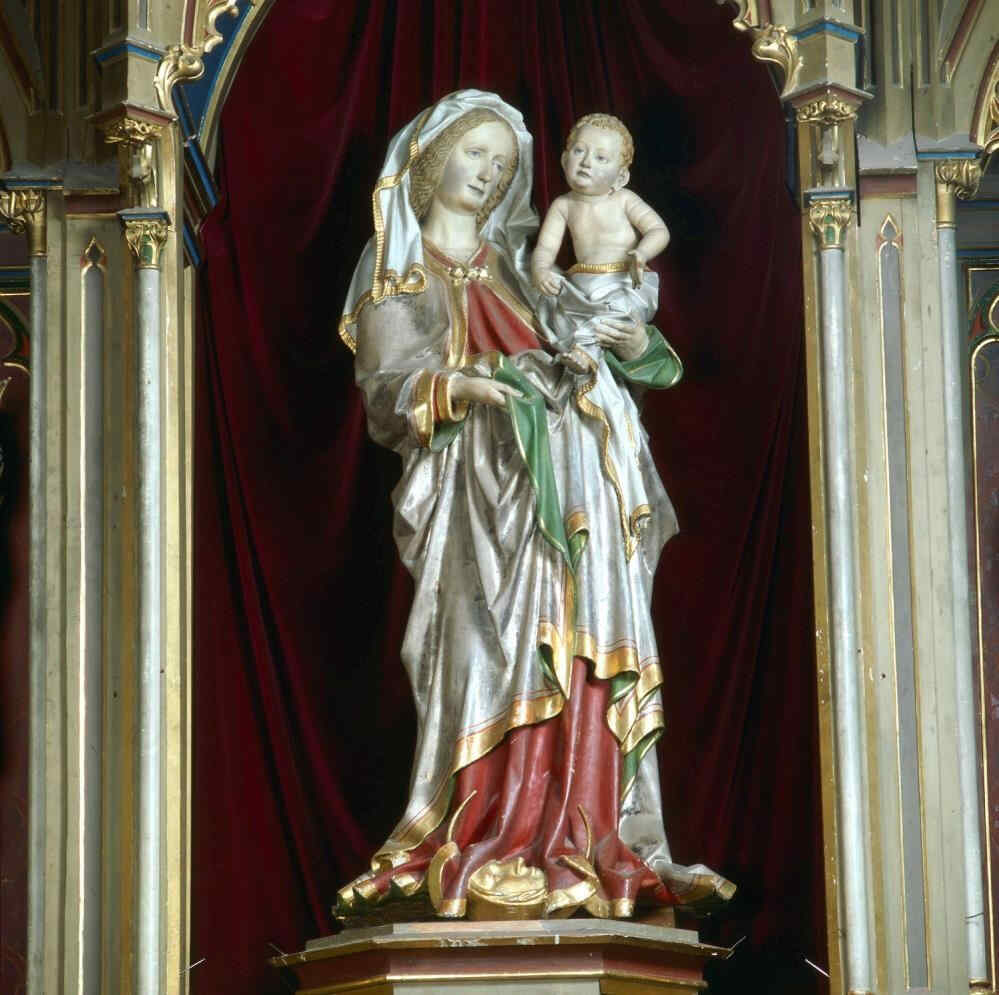 And now we go further and further in what I described just now as the elaboration of the Christian subjects with deep inwardness of soul. The following are figures carved in wood, at Blutenburg (end of the 15th century). The art of characterisation has, indeed, attained its ideal to a marvellous extent. The figure of Mary, carved in wood—end of the 13th century:   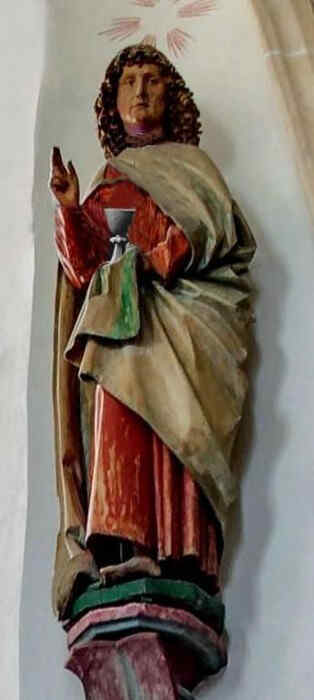 This, then, is the time when Michelangelo and Raphael were born. The next picture, too, is from Blutenburg. 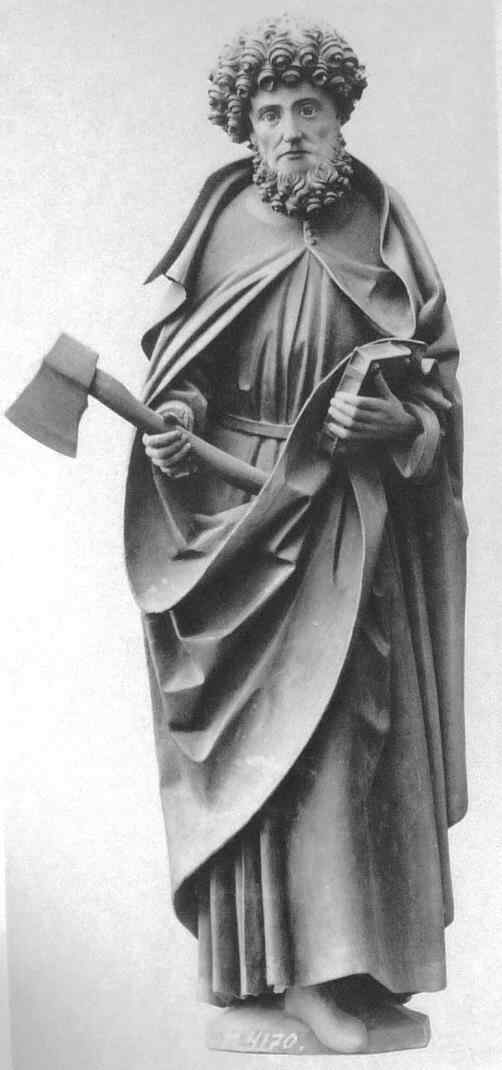 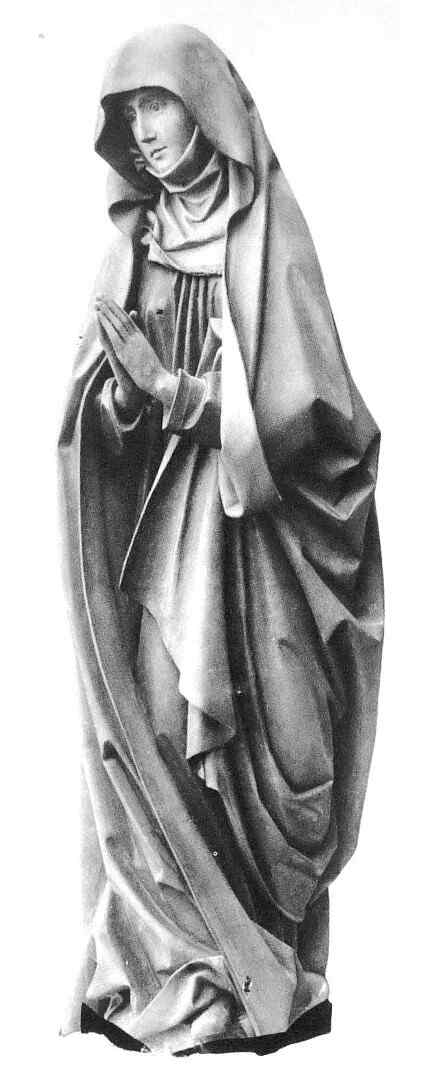  The time when these highly individual figures were created was also especially great in wood-carving, with which they decorated the Choristers' seats in their churches. We will give two examples from the Frauenkirche in Munich, end of the 15th century. 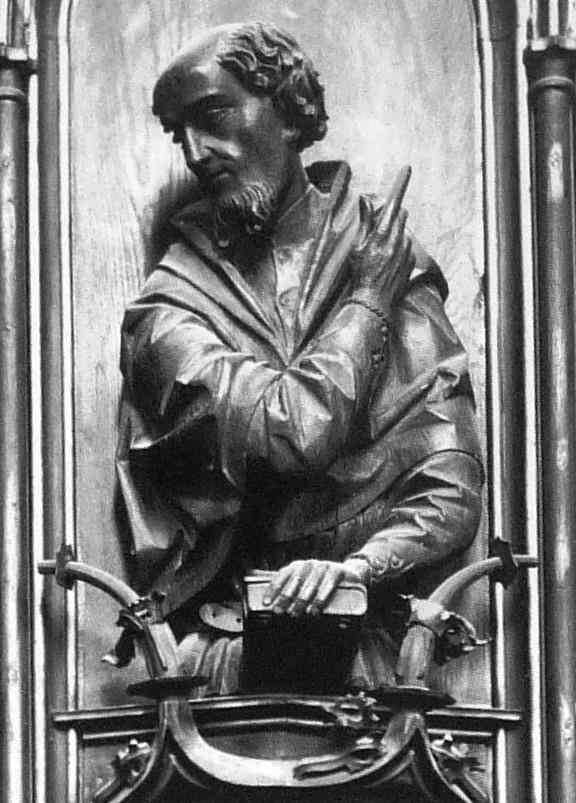 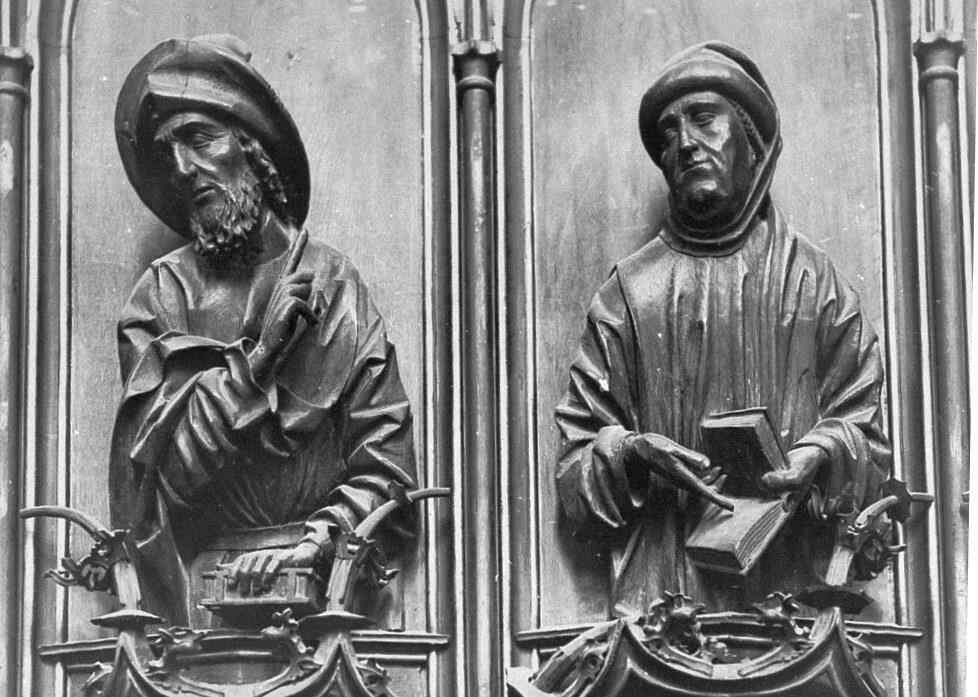 We now come to the sculptor who worked at the end of the 15th century. 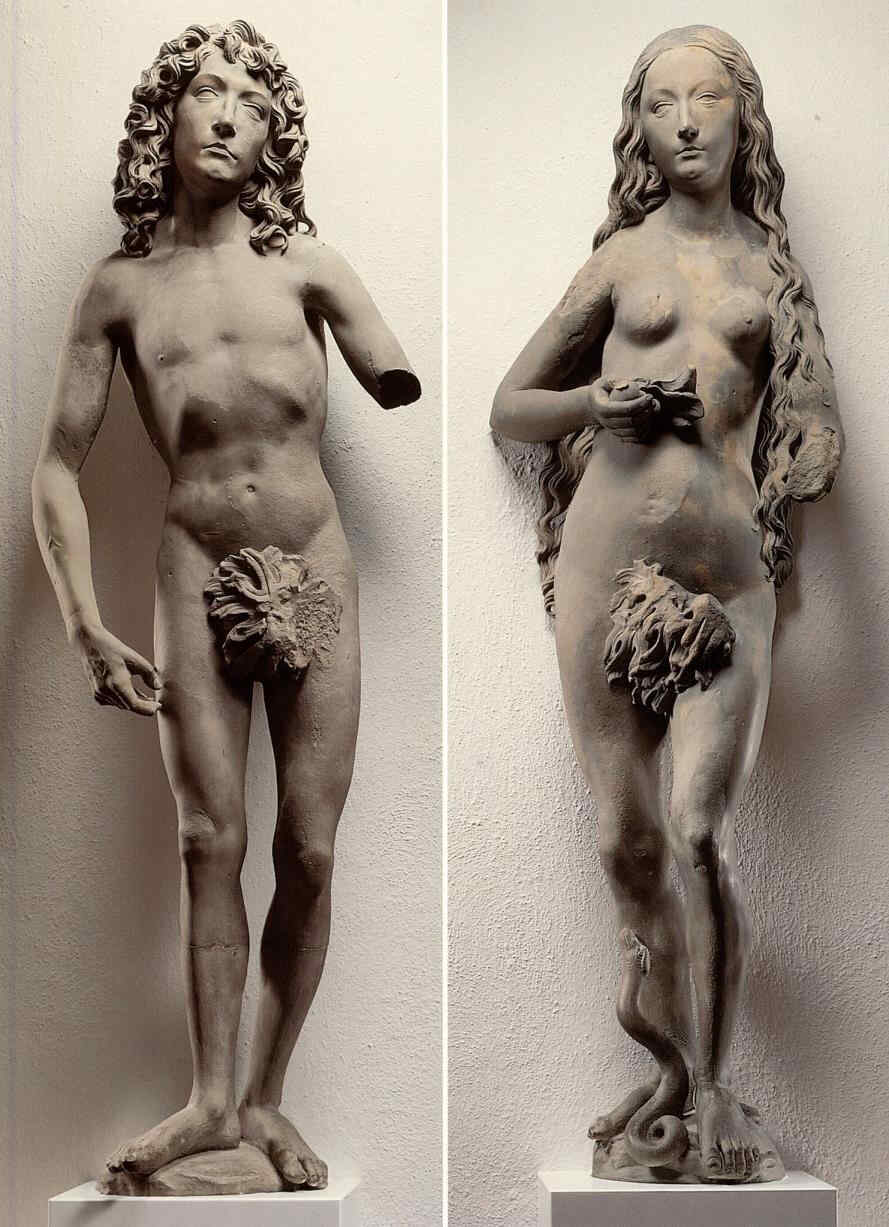 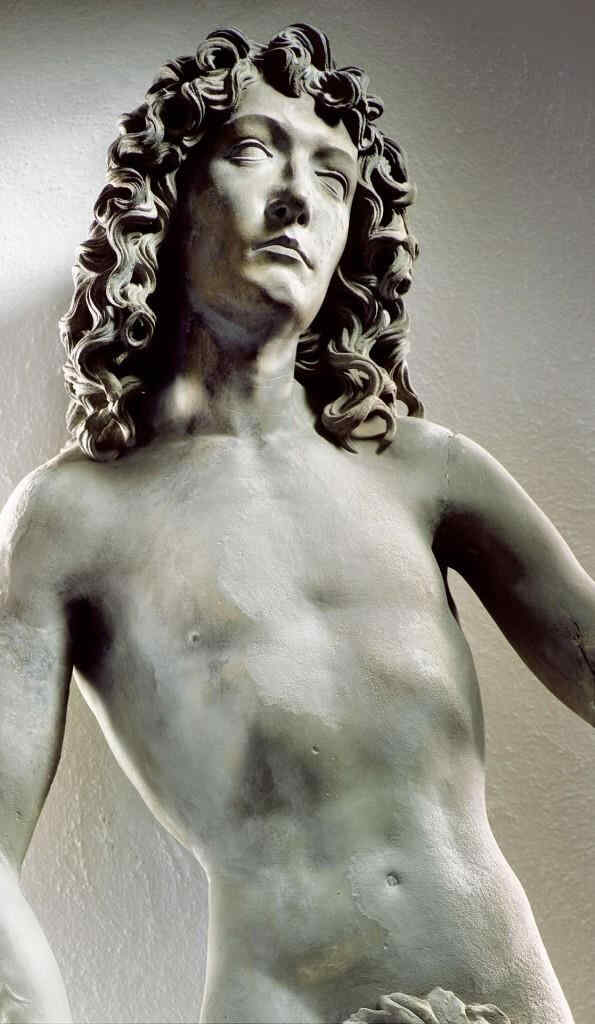 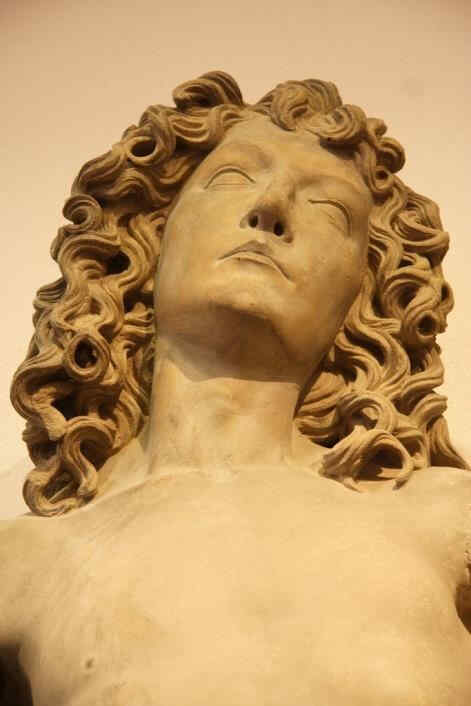 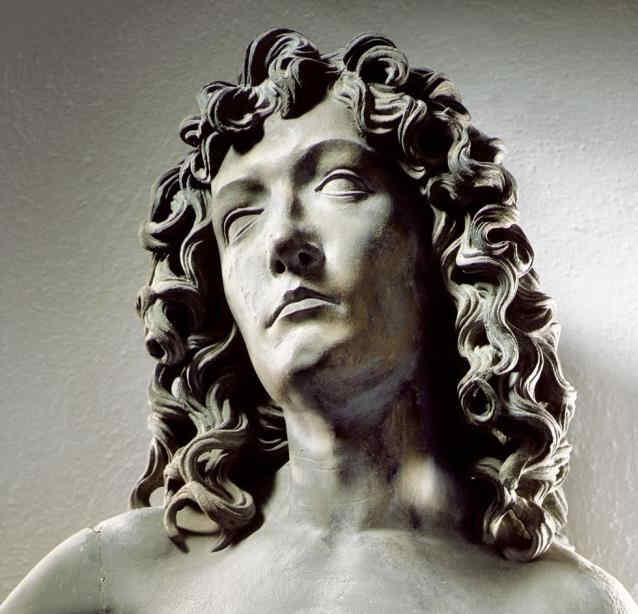  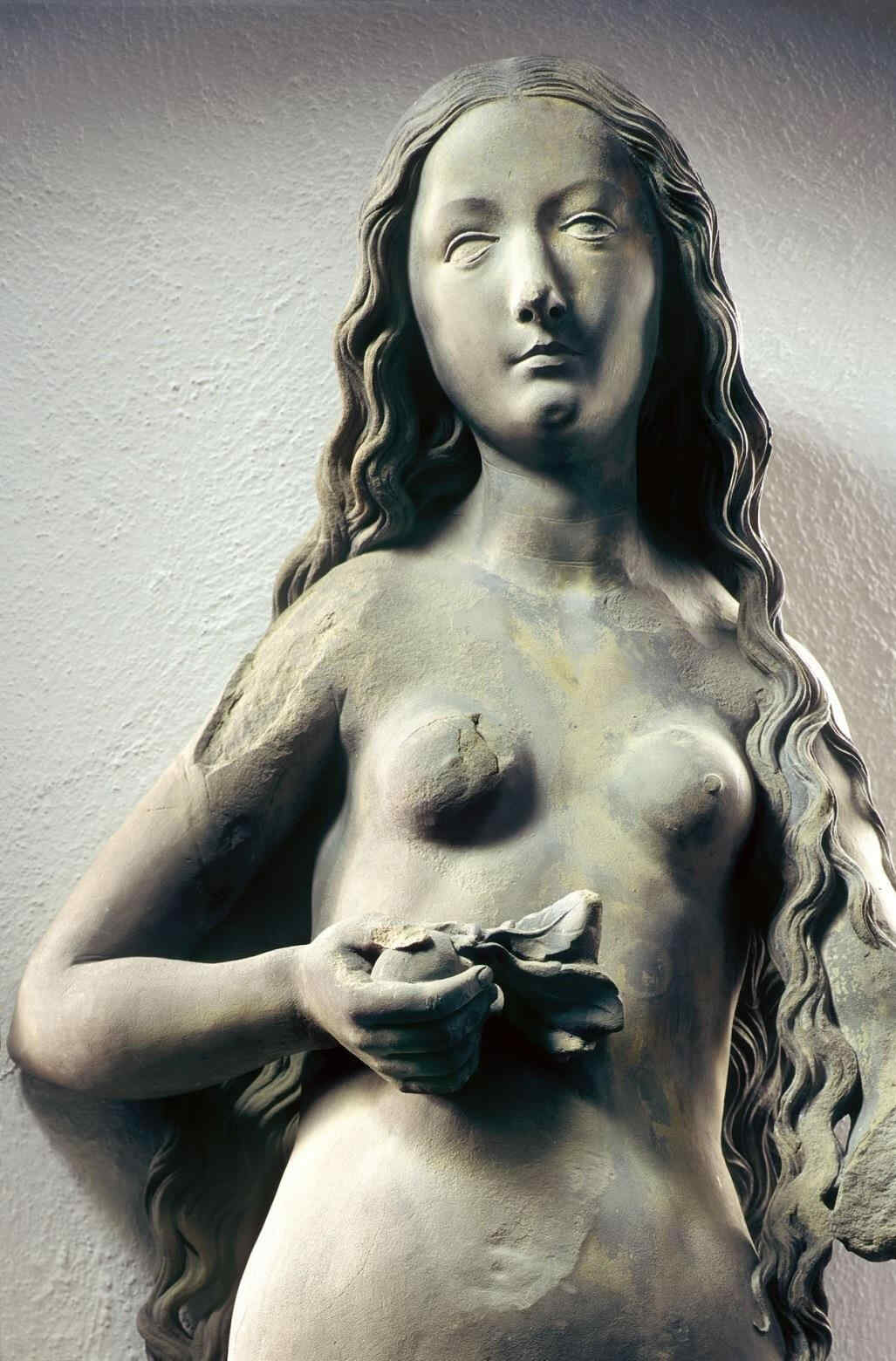 And this was the time when the High Renaissance in Italy had not as yet begun. These works were created about 1490–1495. 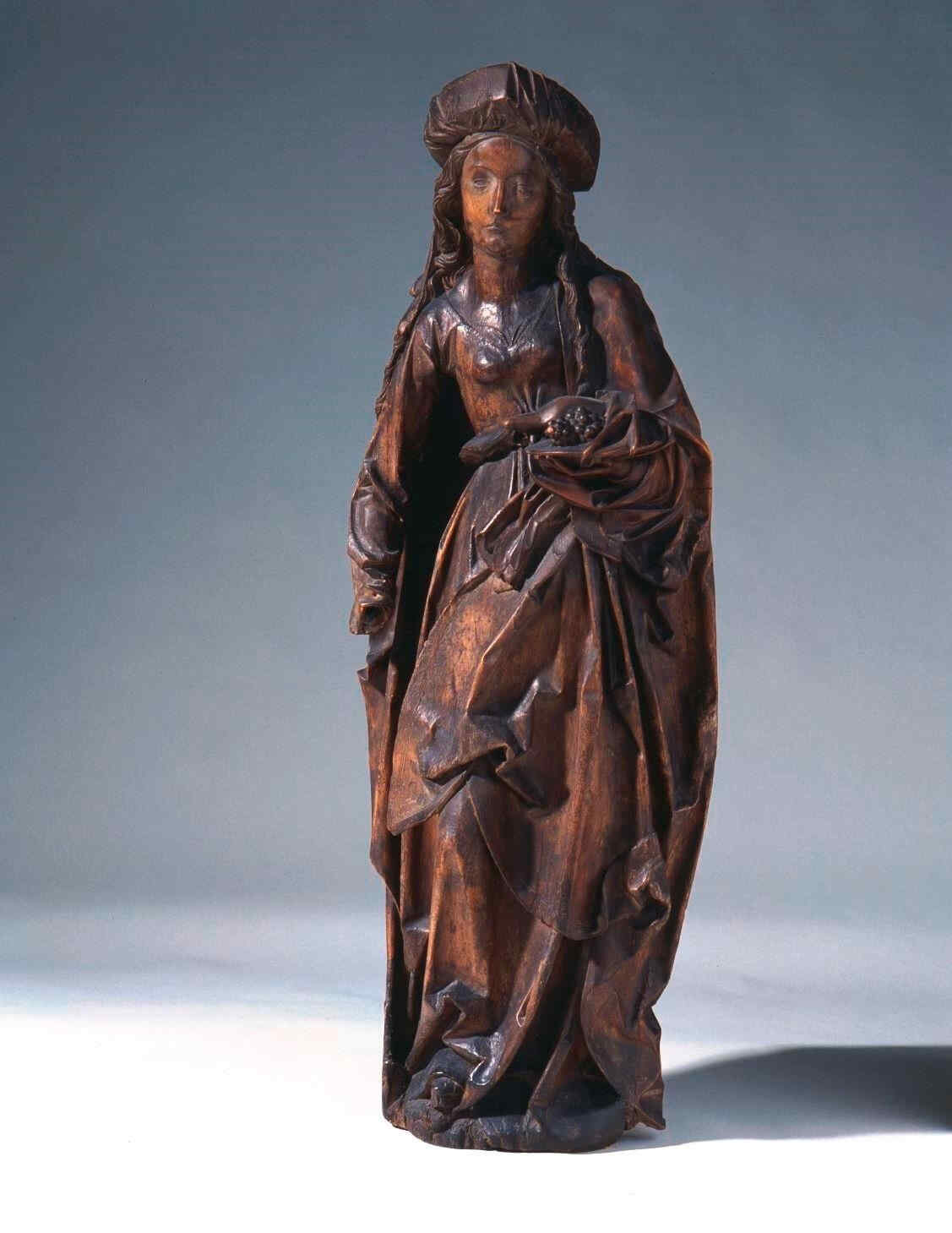 This St. Elizabeth—created in the early 16th century—is now in the (Germanisches Museum, at Nuremberg.) 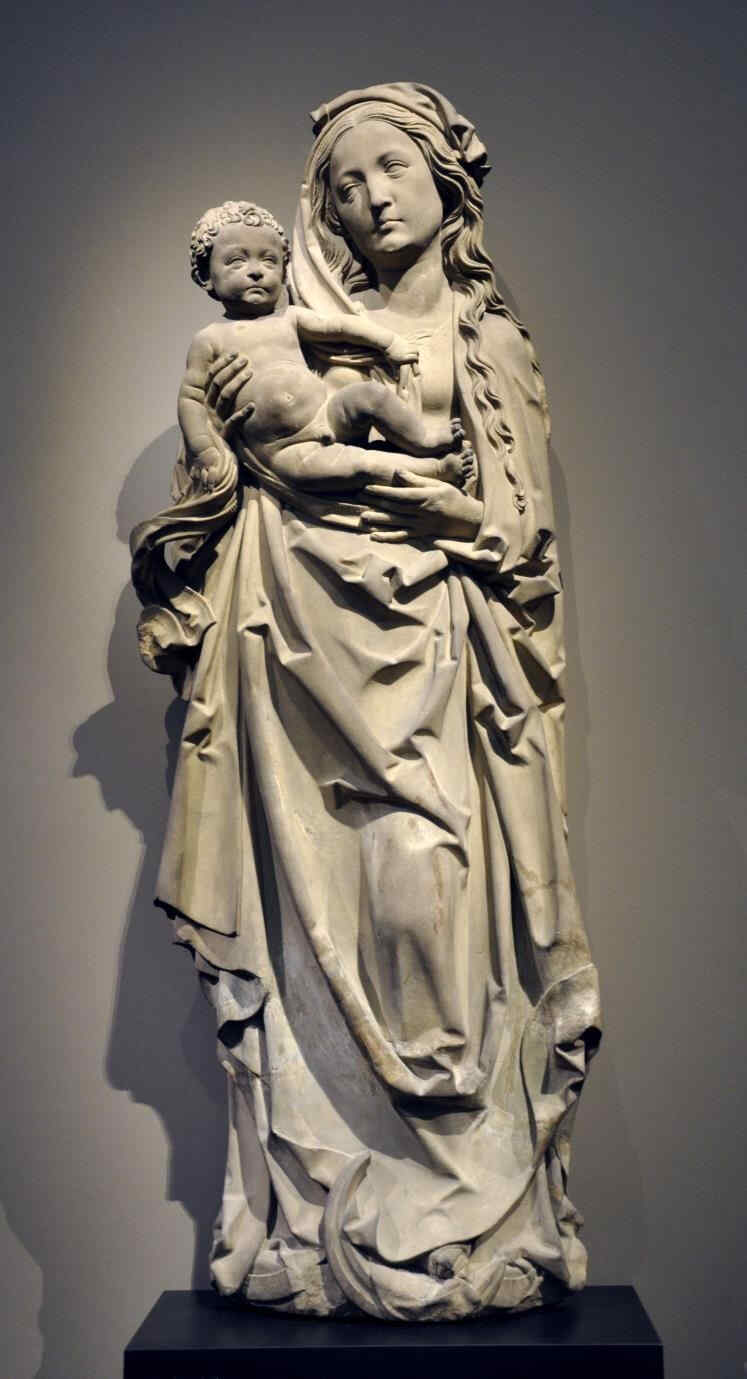 This, too, dates from the beginning of the 16th century. 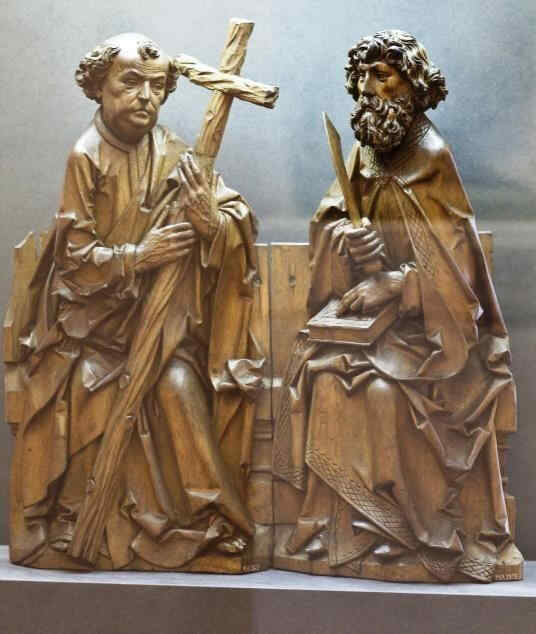 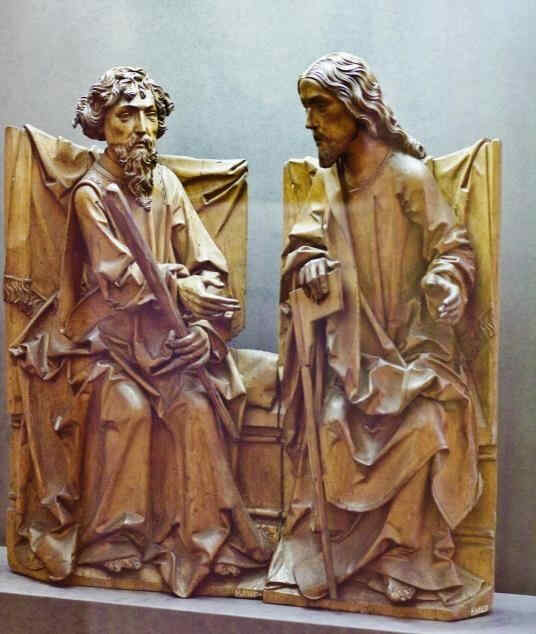 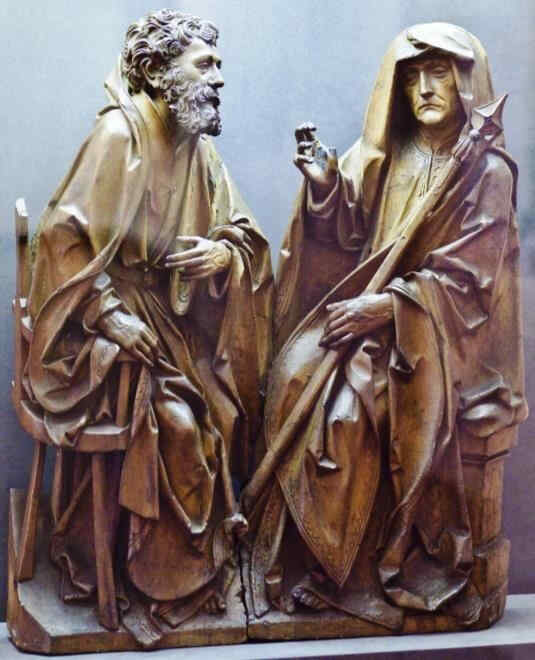 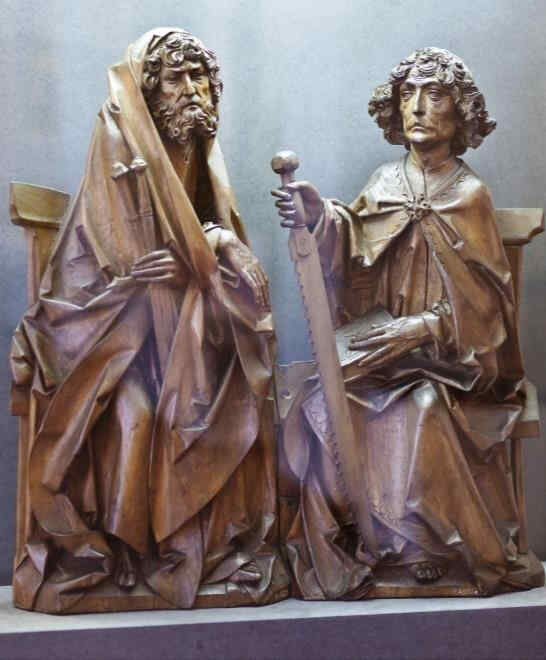 There are wonderful types among these twelve Apostles; one would like to study every single head alone: 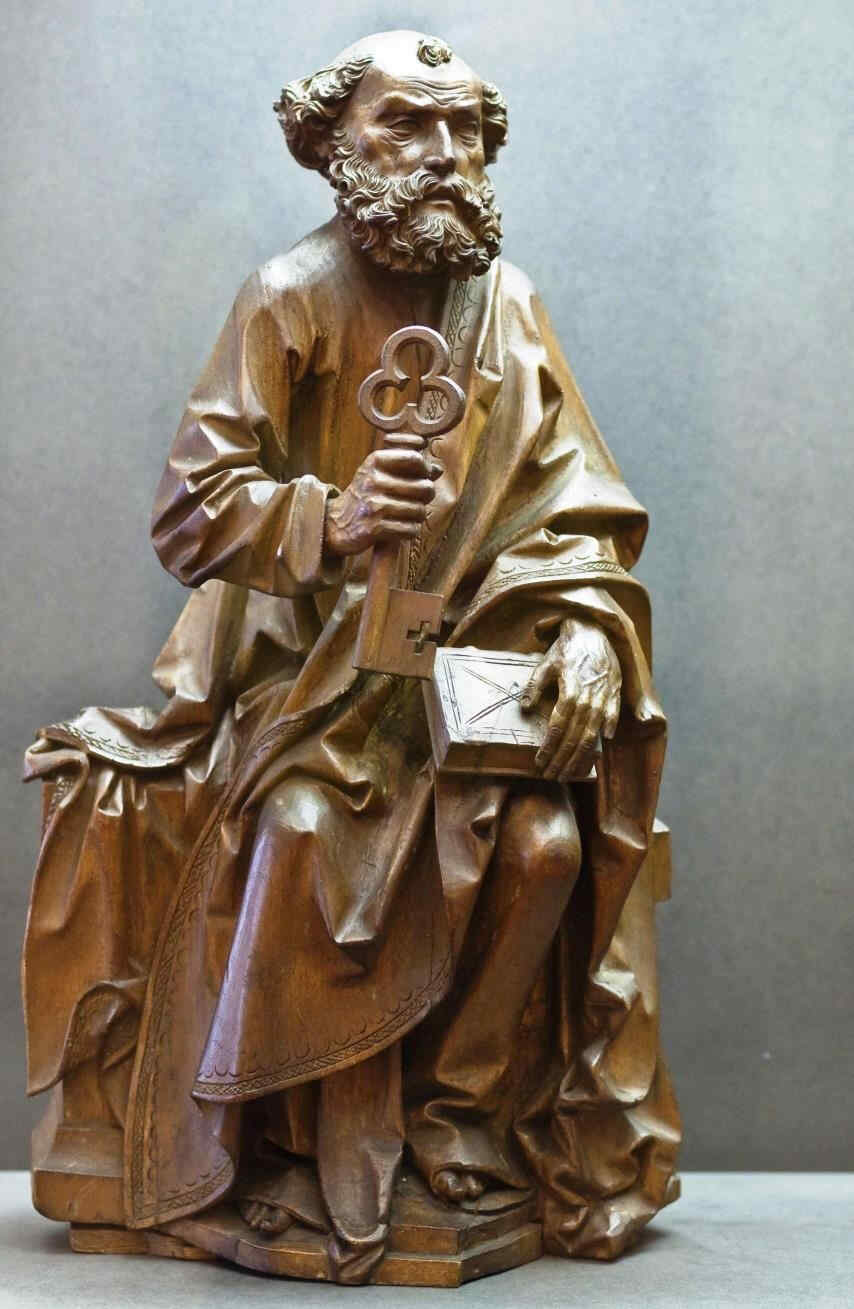 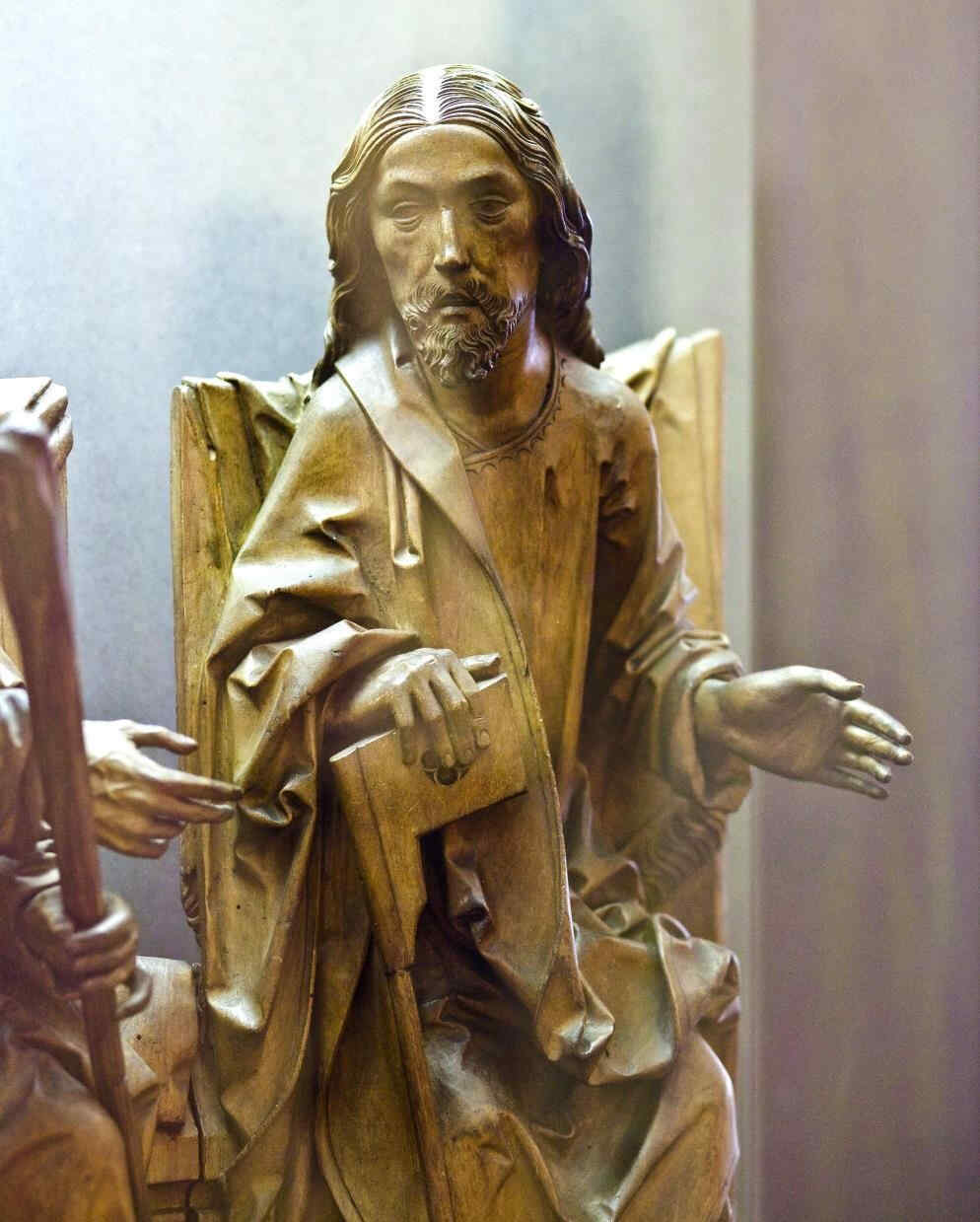 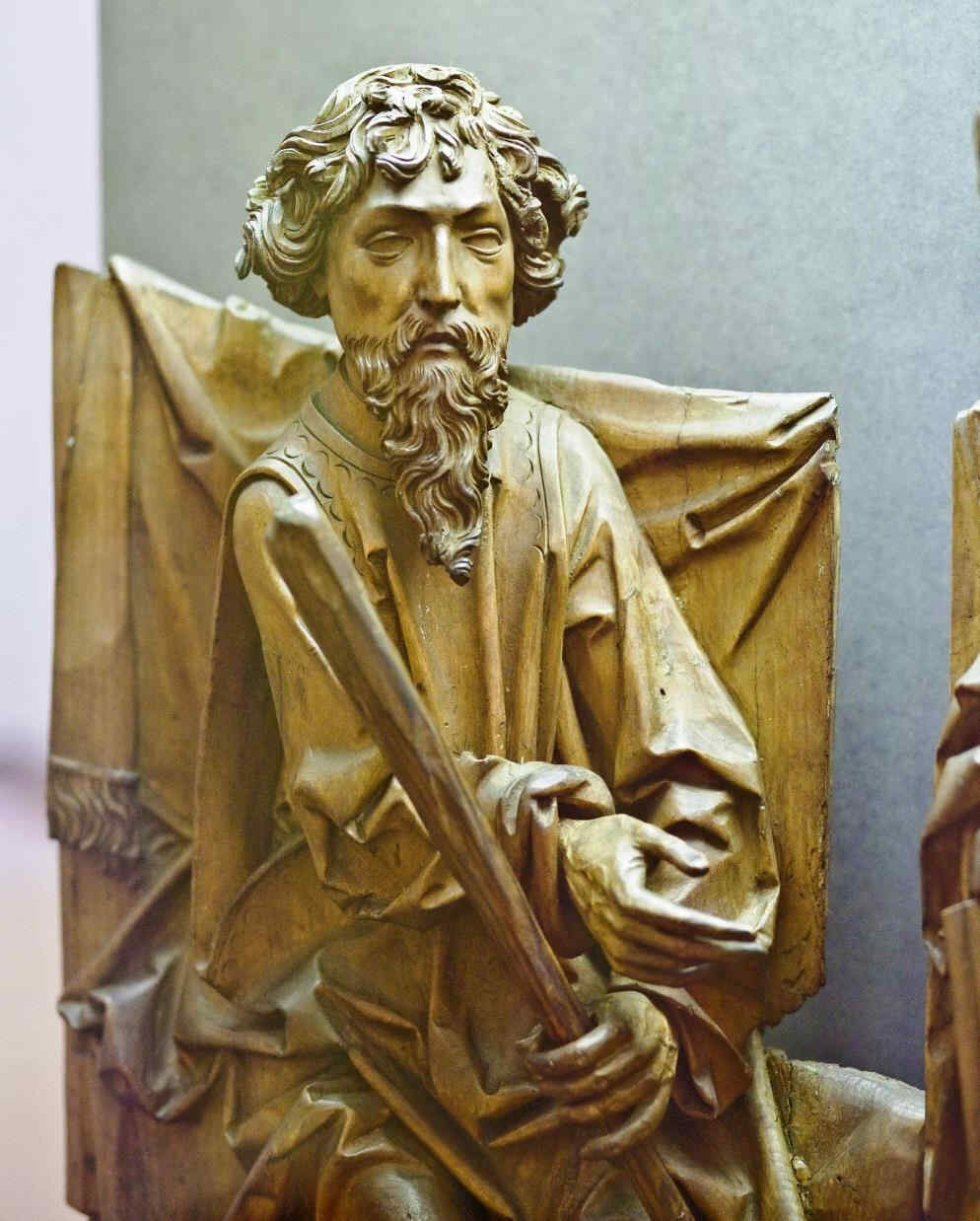  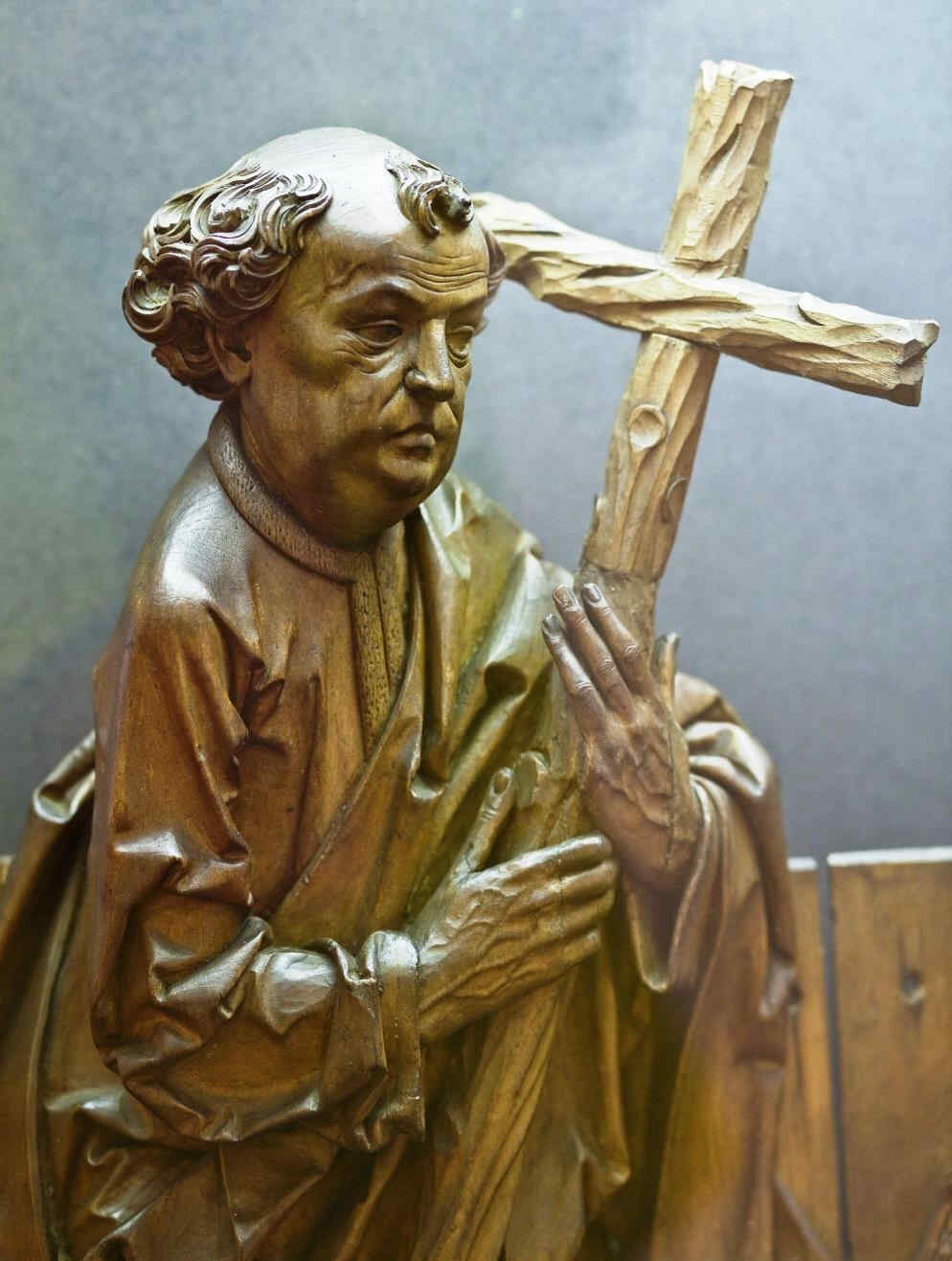    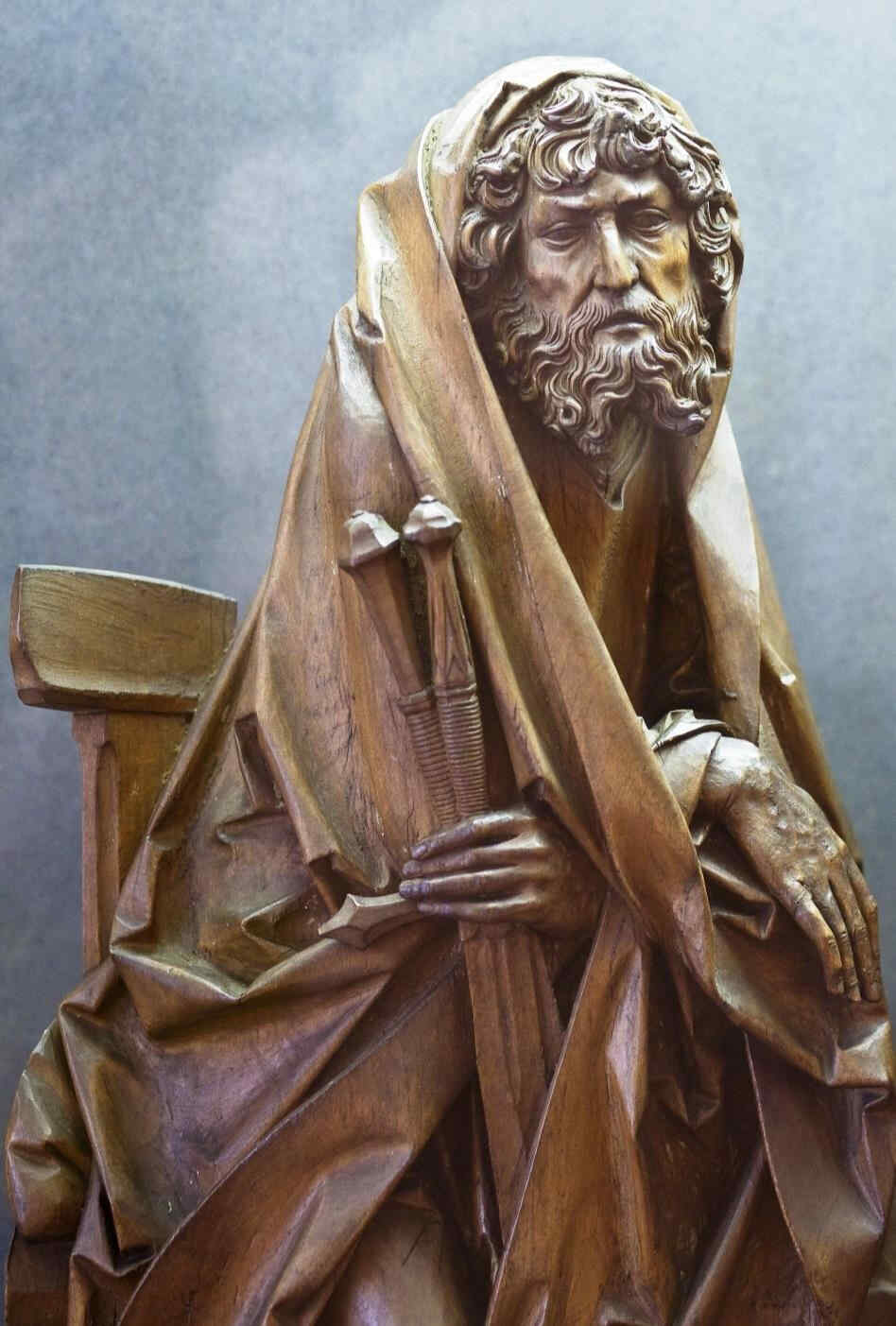 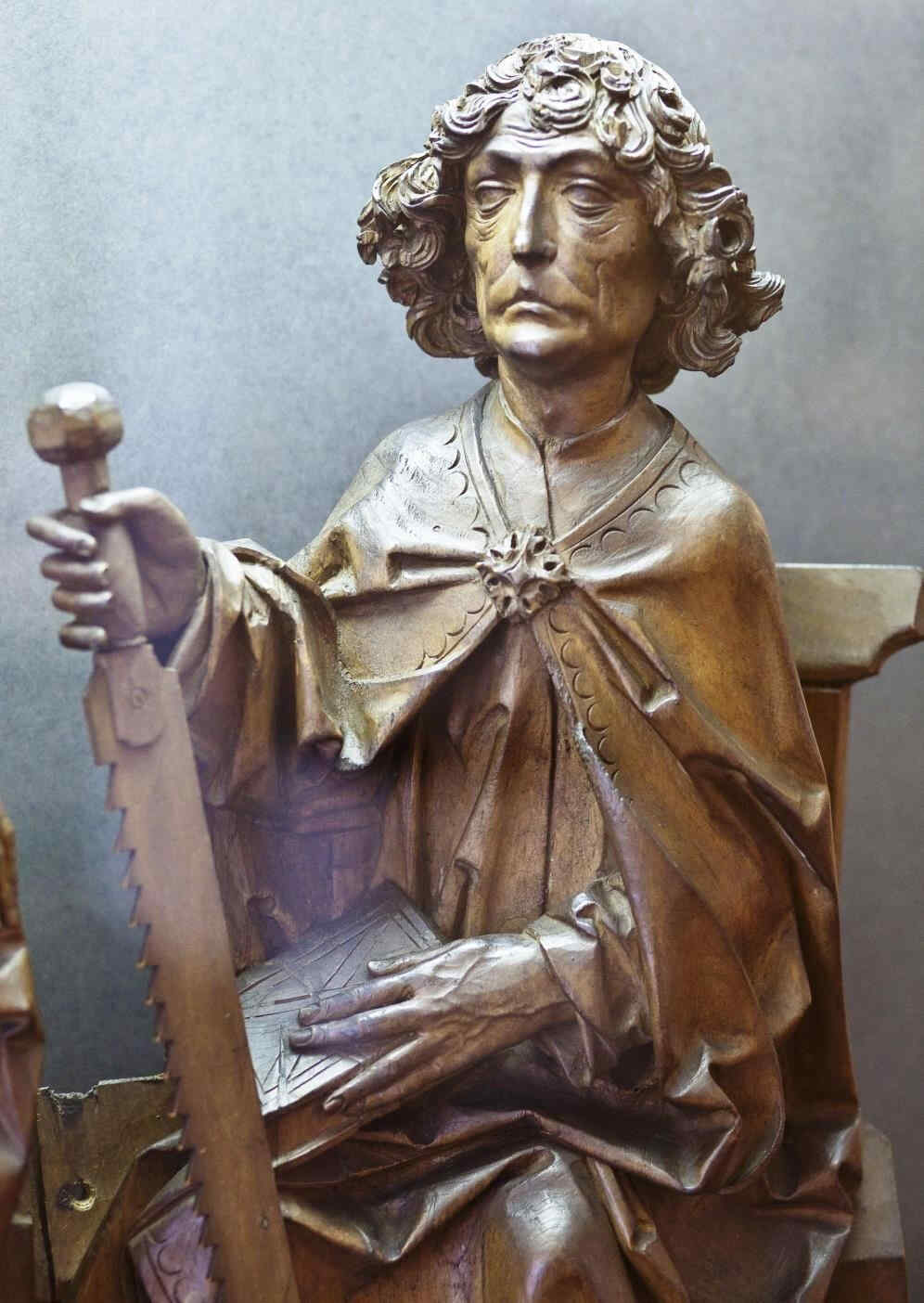 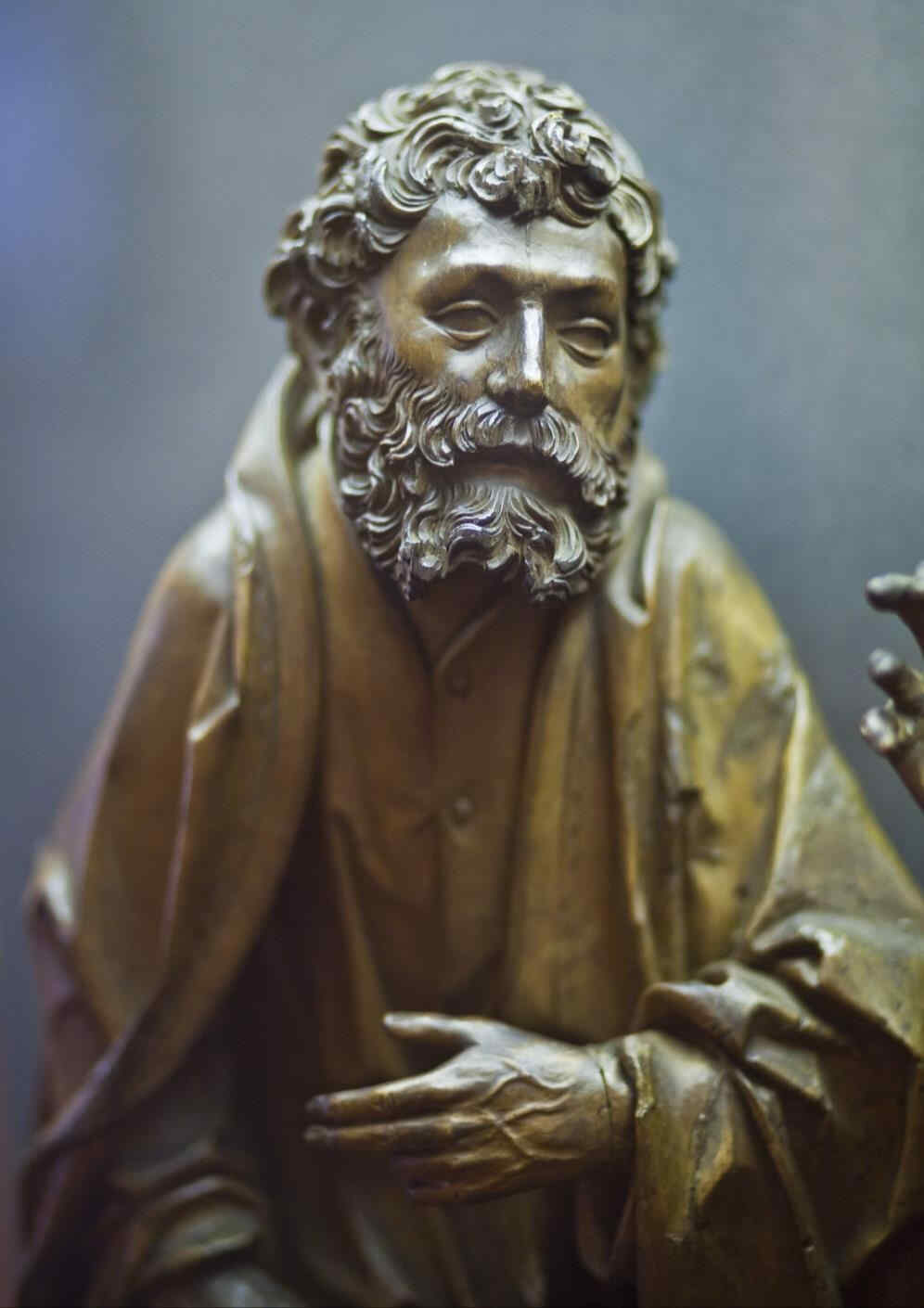 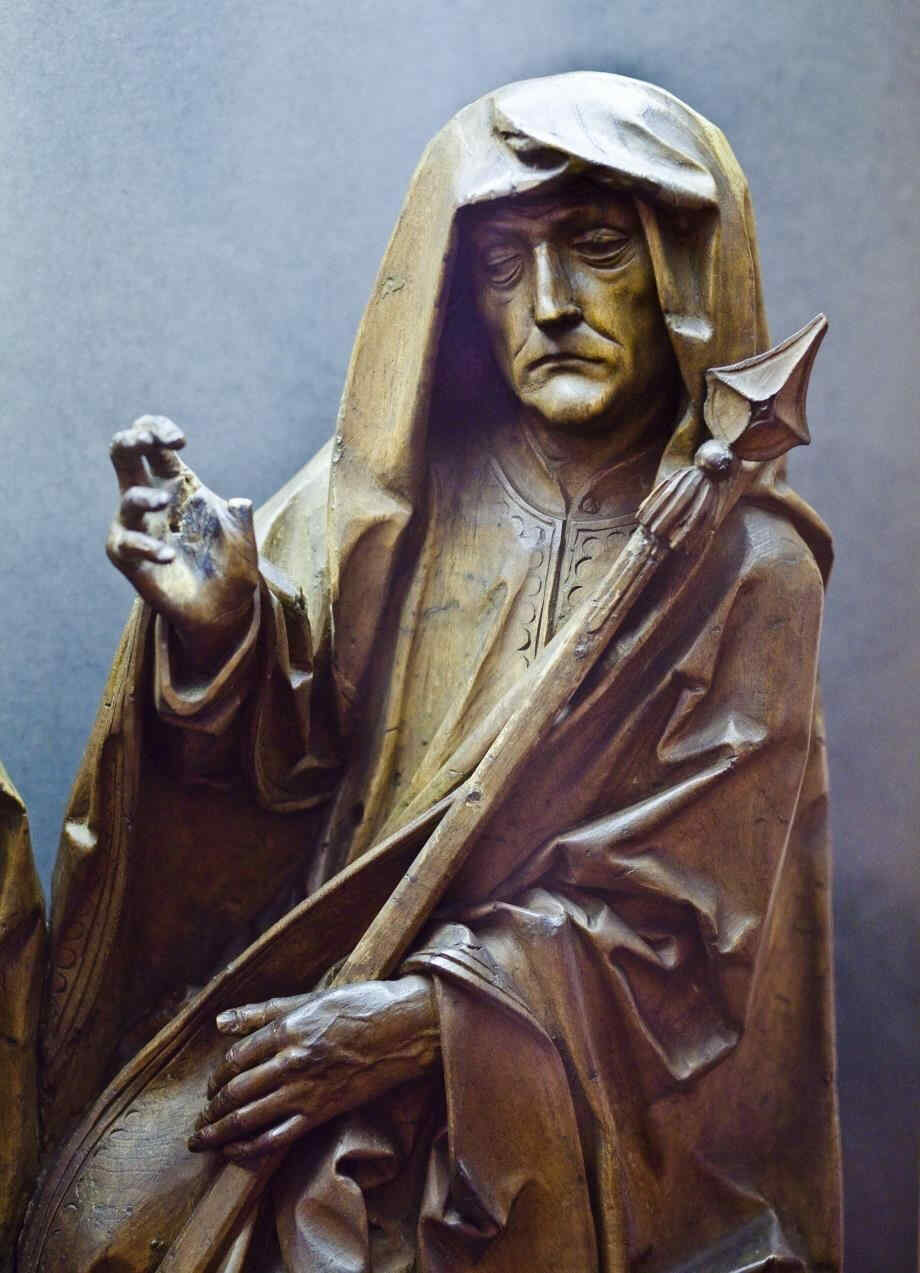 Finally, we give two examples of the sculptor—Veit Stoss—early 16th century, who worked in Cracow and also in Southern Germany, creating his plastic works in many different materials.  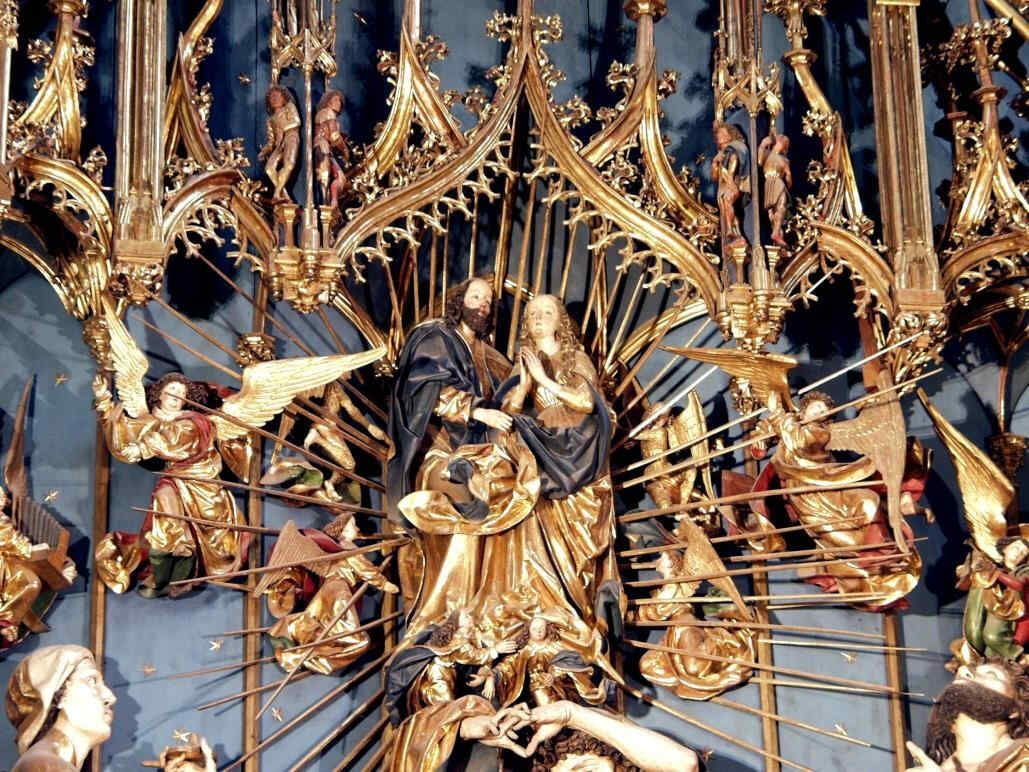  The next picture is in Nuremberg,. “The Angel's Greeting,” it is called. 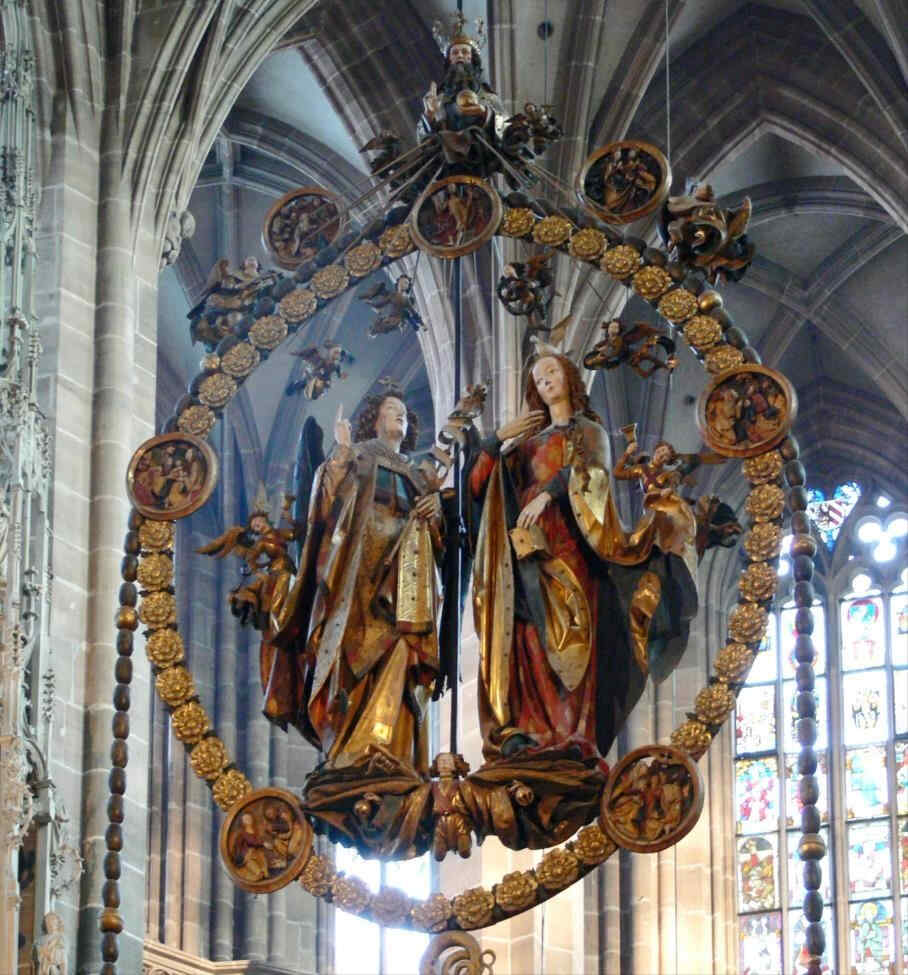 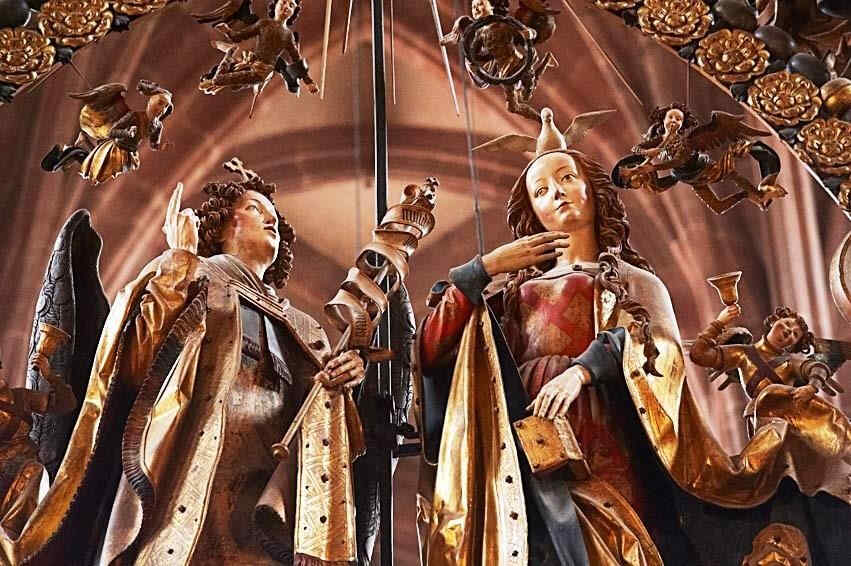 I will also show three paintings by Hans Baldung, also known as Hans Grun, who worked in Dürer's workshop at the beginning of the 16th century—about 1507–1509. 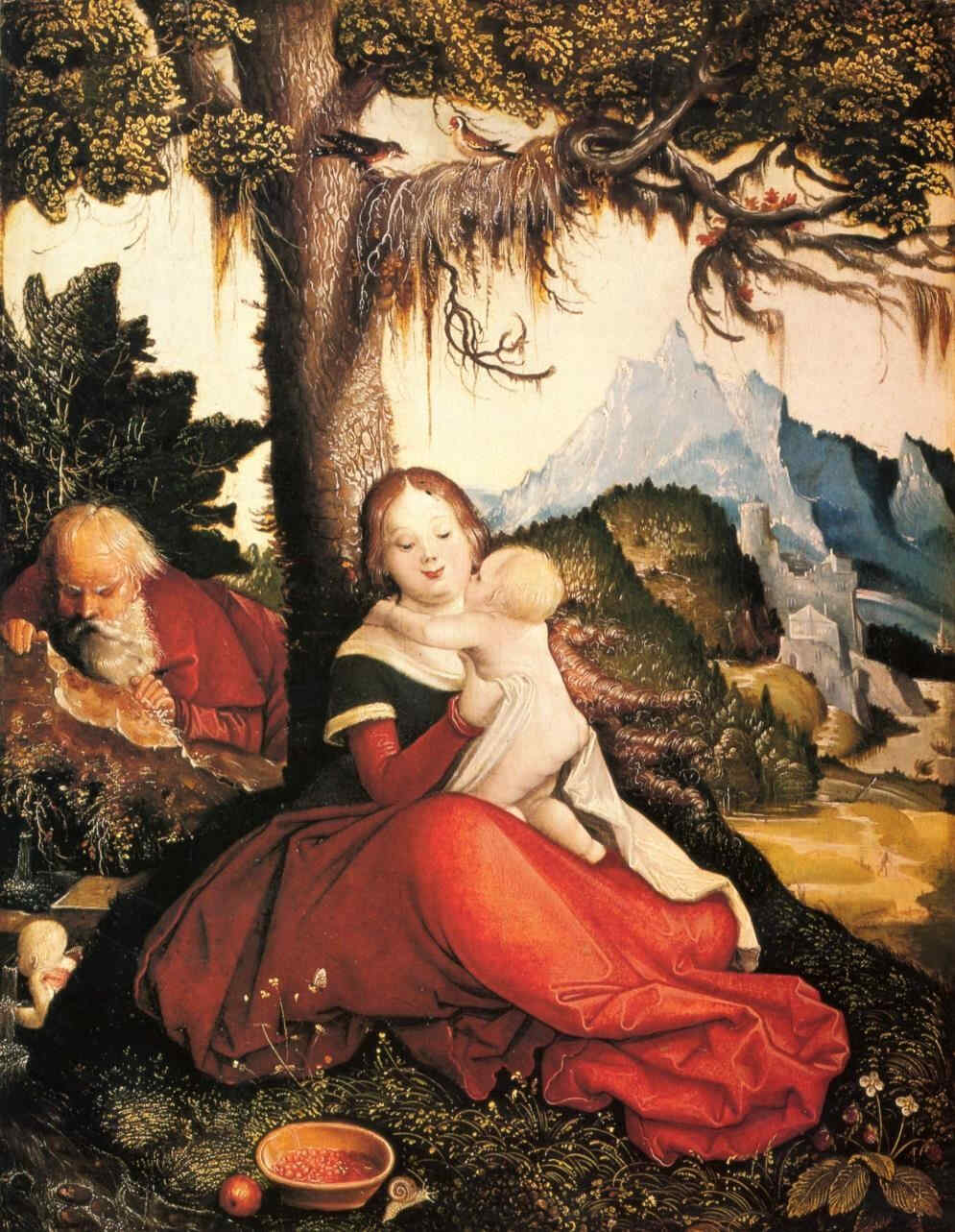 His pictures reveal once more, in the sphere of painting, how everything is turned towards the life of the soul. 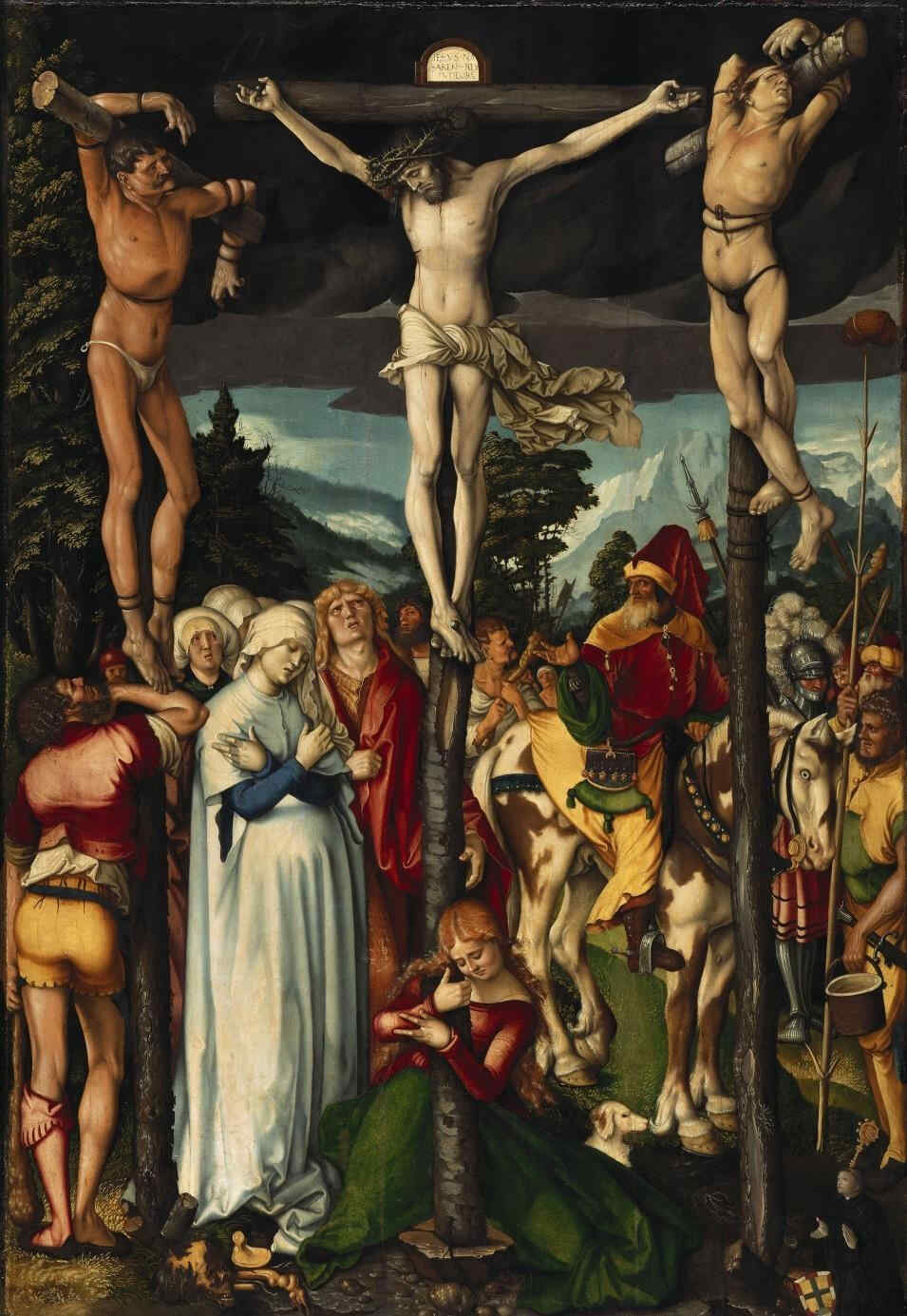 Hans Baldung was also a portrait painter of no mean order. Here you have an example. 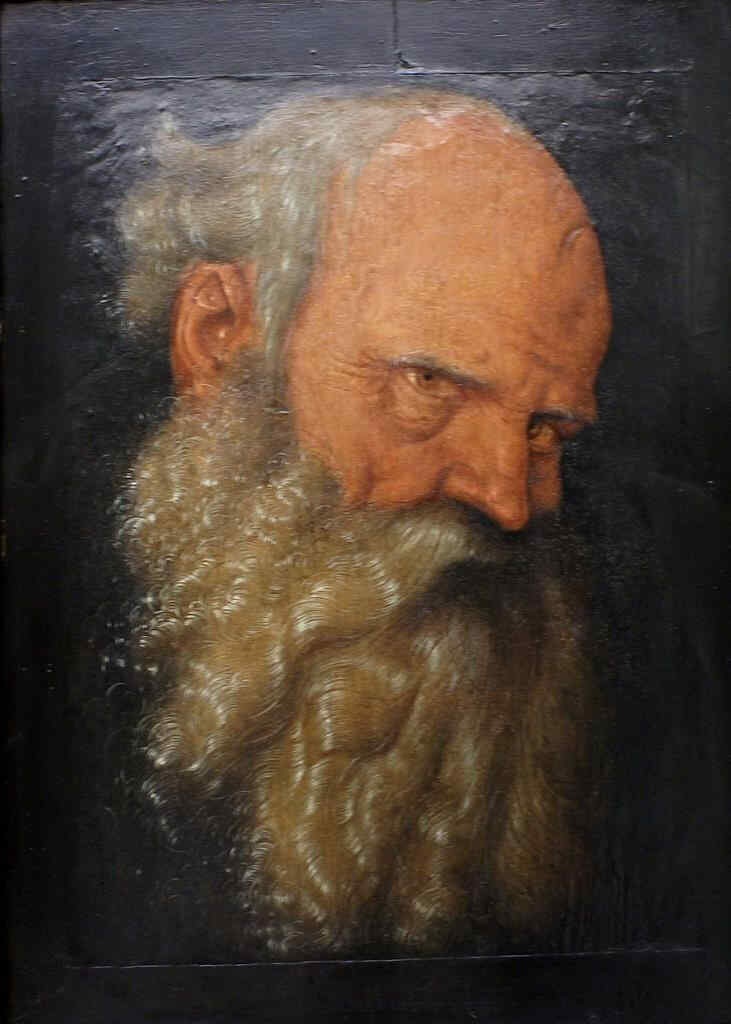 Here you see how the same master cultivated the art of portraiture. He was a pupil of Dürer's, who subsequently lived at Strasburg, and at Freiburg in Breisgau. He did some wonderful paintings of the Life of Christ, and of the Mother of Christ. You will find a picture by him at Basel—“Christ on the Cross.” 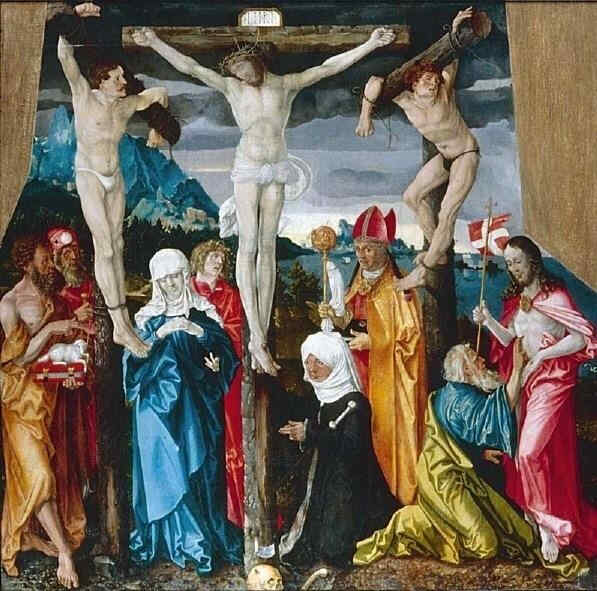 This picture, then, is of the early 16th century—the time of Raphael and Michelangelo in Rome. My dear Friends, the more we multiply these pictures, the more should we see, from this juxtaposition of the Northern and Southern Art, what an immense revolution took place at the turn of the fourth and fifth Post-Atlantean Epochs. And the more should we realise how infinitely rich in content is the simple statement that at that historic moment Civilisation passed from the development of the Intellectual, or Feeling Soul into that of the Spiritual Soul. Infinitely much is contained in such a simple statement. But we only learn to understand these things of Spiritual Science rightly when we follow them into the several and detailed domains of human life. In conclusion, my dear Friends, I still wish to speak a word of solemn remembrance to you on this day. The day after tomorrow is the anniversary of the death of our dear friend, Fraulein Stinde, and in our hearts we will not forget to think on that day of all that came into our Movement through the work of this dear and valued member. And we will also turn our thoughts to her soul as she works on in the Spiritual Worlds—deeply and lovingly connected as she is with our Movement. On this day especially we will deepen the thoughts and feelings of our hearts which are directed to her. I only wished to add this word of remembrance to remind you of the day after tomorrow. In memory of all that unites us with our dear friend—with the soul of our dear Sophie Stinde—let us now rise from our seats. |
| 108. The Christmas Mystery. Novalis, the Seer
22 Dec 1908, Berlin Translated by Dorothy S. Osmond Rudolf Steiner |
|---|
| Just as Nature herself is rejuvenated every year and her eternal forces bud forth in forms that are forever new, so it is with the symbols of Christmas piety; in their constant rejuvenation they betoken the eternal reality of this festival. And so in the solemnity of this Christmas hour we will bring a picture before our souls of what men on Earth have experienced at the time when we now celebrate Christmas. |
| And the birth of this blossom is commemorated in our Christmas Festival. In our Christmas Festival we celebrate the birth of the blossom which was to receive the Christ-Seed. |
| This should be regarded as an approximate translation of the rather unusual rendering of the Christmas message. |
| 108. The Christmas Mystery. Novalis, the Seer
22 Dec 1908, Berlin Translated by Dorothy S. Osmond Rudolf Steiner |
|---|
Individuals appear in the world from time to time who are able to see in direct vision what has been realised through Feeling by thousands upon thousands of souls and hearts in the course of the centuries. But in the modern age only those who are familiar with the findings of spiritual ‘clear-seeing’ know that the effects of the event of Mystery of Golgotha on evolution are always perceptible to the true seer. The entire spiritual sphere of the Earth was changed through what took place at Golgotha. And ever since then, if the eye of the soul has been opened through contemplation of this Event, the seer beholds the presence of the everlasting power of the Christ in the spiritual sphere of the Earth. Other men are impressed by the power of the impulse proceeding from the Mystery of Golgotha and the great truths connected with that Event; they realise, too, that since then the human heart has been able to experience something that could never previously have been experienced or felt on the Earth. But to a seer this is perceptible reality. The young German poet Novalis became a seer—we might almost say ‘miraculously’—by the grace of divine-spiritual Powers. Through a deeply shattering event which made him aware, as if by a stroke of magic, of the connection between life and death, his eyes of spirit were opened and as well as a great vista of past ages of the Earth and Cosmos, the Christ Being Himself appeared before him. He was able to say of himself that he was one who with the eyes of spirit has actually seen what is revealed when ‘the stone is lifted’ and the Being who has furnished earthly existence with the proof that life in the spirit will forever overcome death, becomes visible. In the case of Novalis we cannot really speak of a self-contained life in the ordinary sense, for his was like a remembrance of an earlier incarnation. The Initiation conferred upon him as it were through Grace, brought to life within him his achievements and experiences in earlier incarnations; there was a kind of consolidation of intuitions and insights that had been his in a previous life. And because he looked back through the ages with his own awakened eyes of spirit, he was able to affirm that nothing in his life was comparable in importance with the experience of having discovered Christ as a living reality. Such an experience is like a repetition of the happening at Damascus, when Paul, who had hitherto persecuted the followers of Christ Jesus and rejected their proclamation, received in higher vision the direct proof that Christ lives, that He is present, and that the Event of Golgotha is unique in the whole process of the evolution of humanity. Those whose eyes of spirit are open can themselves behold this Event, for in truth Christ was not only present in the Body that was once His dwelling-place. He has remained with the Earth; through Him the Sun-Power has united with the Earth. Novalis speaks of the revelation that came to him as ‘unique’ and he maintains that only those who with their whole soul are willing to relate themselves with this Event are men in the true sense. He rightly says that the ancient Indian, with his sublime spirituality, would have allied himself with Christ had he but known Him. Not out of any dim inkling or blind faith, but out of actual knowledge, Novalis says that the Christ whom he has seen with eyes of spirit is a Power pervading all beings. This Power can be recognised by the eye in which it is working. The eye that beholds the Christ has itself been formed by the Christ-Power. The Christ-Power within the eye beholds the Christ outside the eye. These are truly wonderful words! Novalis is also aware of the stupendous truth that since the Event of Golgotha the Being we call Christ has been the planetary Spirit of the Earth, the Spirit by whom the Earth's body will gradually be transformed. A wonderful vista of the future opens out before Novalis. He sees the Earth transfigured; he sees the present Earth in which the residue of ancient times is still contained, transformed into the Body of Christ; he sees the waters of the Earth permeated with Christ's Blood, and he sees the solid rocks as Christ's Flesh. He sees the body of the Earth gradually becoming the Body of Christ; he sees the Earth and Christ miraculously made one; he sees the Earth in future time as a great organism enshrining man, an organism whose soul is Christ. In this sense, and out of his deep insight into occult truths, Novalis speaks of Christ as the Son of Man. Just as in a certain sense men are the ‘Sons of the Gods’, that is to say of the ancient Gods who through untold millions of years have moulded and shaped our planet, who have built the bodies in which we live and the ground upon which we move, so, by overcoming earthly things, man's task is to build, through his own powers, an Earth that will be the body of the new God, the God of the future. And whereas the men of old looked back to the primeval Gods, yearning to be united with them in death, Novalis recognises the God who in time to come will have as his body all that is best in us and that we can offer to Him. In Christ he sees the Being to whom humanity offers itself in order that this Being may have a body. He recognises Christ as the ‘Son of Man’ in this higher, cosmological sense. He speaks of Christ as the ‘God of the future’. All these experiences and perceptions are so pregnant with meaning that they are well able to kindle the true mood of Christmas in our souls. And so we will let one who lived a brief life at the end of the eighteenth century, dying at the age of 29, describe the experiences associated with the greatest event in his life—the sublime vision of the Christ Being. (Marie von Sivers (Marie Steiner) here recited a poem from the Spiritual Songs of Novalis.) The Christmas Tree has not been the symbol of the Christmas Festival for any length of time. We shall find no poem on the Christmas Tree among, let us say, the works of a poet such as Schiller, although had such a custom existed in his day he would certainly have recognised its poetic possibilities and would not have found it difficult to write a poem on the subject. But in Schiller's time the Christmas Tree in its now familiar form was unknown. It is a young and quite recent institution. In earlier times men celebrated this festival in a different way. However far we look back into past ages, as long as one can speak of human beings in their present form or having the rudiments of that form, we shall everywhere find an institution that is akin to our Christmas Festival; we shall find it in constantly new forms among the widespread masses of the peoples and as an enactment in the highest Mysteries. The very fact that the festival itself is so ancient and our present symbol of it so recent, is indicative of an element of eternity, of an eternal reality from which new forms ever and again spring forth. This Christ-Festival and all the feelings and experiences it symbolises, are as ancient as humanity on Earth. But man will always be able to find new symbols, symbols that are in keeping with the times, as outward forms of expression for this festival. Just as Nature herself is rejuvenated every year and her eternal forces bud forth in forms that are forever new, so it is with the symbols of Christmas piety; in their constant rejuvenation they betoken the eternal reality of this festival. And so in the solemnity of this Christmas hour we will bring a picture before our souls of what men on Earth have experienced at the time when we now celebrate Christmas. As pupils of Spiritual Science we can send our thoughts back to ages in the far, far past, to begin with to the times when our souls were incarnated in Atlantean bodies, bodies very unlike those of today. In that epoch there were great Teachers who were also the Leaders of humanity. Men looked out upon a different world, where there was no bright sunlight to reveal to them in clear outlines the forms of objects in the kingdoms of Nature. Everything around them was as though swathed in mist—not only because much of Atlantis was actually covered with mist and fog through which the sunlight could not penetrate to the same extent as later on, but also because man's faculty of perception had not yet developed to the stage where external objects appeared in clear outline. When men woke in the morning they saw everything around them in divine Nature swathed in mist and surrounded by auric colours, and when they went to sleep at night they passed into a spiritual world without falling into the oblivion and unconsciousness of sleep today. When men went to sleep in the days of Atlantis, they beheld the divine-spiritual Beings who were their companions; they beheld those divine Beings who were once experienced as realities and who in later times were preserved as memories in different regions of the Earth, bearing different names: Wotan, Thor, Baldur, in Middle Europe; the names of Zeus, Pallas Athene, Ares, and so forth, were given to those divine figures who had once been visible to man's eyes of soul in old Atlantis. But in Atlantean times the divine worlds were no longer the highest, creative worlds whence man had come forth in the age of Lemuria. Our souls were once born from the womb of divine Beings of whose sublimity and majesty there can be only a dim inkling today. These same divine Beings sent forth the cosmic orbs and all the forces surrounding us. Man was within the womb of divine Beings whose outward expressions we behold in the celestial bodies; they were the Beings who flash through the air in lightning and thunder, whose expressions are the plants and animals and whose sense-organs are the crystals. All the warmth that streams to us, all the forces in play around us—all this constitutes the body of divine-spiritual Beings from whom man has come forth. The more deeply man descended to the Earth, the more closely he united with material substances, the more he membered into himself the substances of the Earth, the less capable he became of beholding the great Gods. In primeval times man had as yet no faculty for cognising the material world; he could neither see with eyes nor hear with ears; pictures that were not pictures of minerals, animals or plants but of divine-spiritual Beings above him, surged through his soul. In later ages he lived more and more on the physical plane, learning through the outer sense-organs to know the physical world. In the days of Atlantis, sight on the physical plane alternated with a form of clairvoyance that had remained as a relic of the ancient state of sublime spirituality in which man once had lived. But the Gods he was still able to behold on the astral plane when by night he enjoyed the bliss of living as a spiritual being among other spiritual beings, were lower in rank than the highest Gods. As the physical plane grew clearer, man's vision on the spiritual planes grew dim. But in ancient Atlantis there were Initiates who as well as imparting the deeper teachings concerning the Gods of old whence men had come forth, proclaimed a truth which they presented in somewhat the following way. ‘Look at the seed of a plant; see how this seed develops into a plant. It grows, sends forth leaves, sepals, blossom and fruit. One who observes the plant in this way can say to himself: I look back to the seed; the seed is the creator of the leaves and the blossom I see before me, and this blossom holds within it the seed of a new plant; the blossom forms itself into a new seed. And one can also look into the future.’—Thus did the great Atlantean Initiates speak to their pupils and through their pupils to the whole people. They said: ‘You can look back to the seeds of the Gods whence men have come forth. The spiritual and physical realities you see around you are all leaves that have sprung from the seeds of the primeval Gods. See in them the forces of those divine seeds even as the forces of the seed from which the plant has come forth can be seen in its leaves. But we are able to point to something more: in future times there will spread around man something that will be akin to the blossom of a plant, something that has, it is true, issued from the ancient Gods but—as the blossom ripens a seed—contains a seed in which the new God unfolds!’ The world is born of Gods—such was the ancient teaching. That the world will give birth to a God, to the great God of the future—such was the prophecy made by the Initiates of Atlantis to their pupils and through them to the people. For like all Initiates, those of Atlantis saw into the future, foresaw the great events of the future. Their vision reached beyond the time of the great Atlantean flood, beyond that stupendous happening whereby the face of the Earth was changed. They foresaw the civilisations that would arise in the future, in the land of the holy Rishis, in the land of Zarathustra; they foresaw the ancient Egyptian culture founded by Hermes, the conditions heralded and inaugurated by Moses, the happiness prevailing in Greece, the might and strength of Rome. All this the Atlantean Initiates saw in advance, and their vision extended to our own time and even beyond it. And to their intimate pupils they imparted hope, saying to them: ‘True, you must leave the spirit-lands where now you dwell, you must be ensnared in matter, you must clothe yourselves in sheaths woven from physical substances. There will come a time when you must labour on the physical plane, when it will seem as though the ancient Gods have vanished from your ken. But your eyes will be able to turn to where the new star can appear to you, to where the new seed comes to life, where there will spring forth the new God of the future, the God who has waited through the ages in order to appear in humanity at the right and proper time!’ When the Atlantean Initiates wanted to explain to their pupils and to all the people why man was destined to descend into the vale of Earth, they said to them that all souls would at some future time see and experience the One who was to come, who was still hidden from their sight, dwelling in a realm invisible to physical eyes as well as to the eyes of spirit which while man was still resting in the womb of the Gods, had gazed upon Him. Then came the Atlantean flood. In a comparatively short time the face of the Earth was changed, and after the migrations of the peoples from West to East, the great post-Atlantean civilisations arose, beginning with that of ancient India. The great Teachers in that epoch, the seven holy Rishis, taught their pupils, and indeed all the Indian people, of the reality of a spiritual world, for their life was now lived on the physical plane and they needed so to be taught. Their eyes could now see only the outer form of the physical world as the expression of the Spiritual, but the Spiritual itself they could not see. Yet there lived in the soul of every Indian something that can be called a dim remembrance of what the soul had once experienced among Gods in the age of old Atlantis. This remembrance aroused a yearning of such intensity for what had been lost, that the soul could establish no close relationship with the physical plane, could only regard it as maya, illusion, unreality. Nor could souls have endured such conditions on the physical plane had not the Rishis, filled with the fire of spiritual inspiration, been able to teach them of the glories of the ancient world that had departed from them. The teachings given by the Rishis concerning the Cosmos are still very little understood today; they were teachings based on a primeval wisdom, because the Rishis were initiated into what man had experienced when he was still within the womb of the Gods. For man was present when the Gods separated the Sun from the Earth and ordained the paths of the celestial orbs—but during his later earthly pilgrimage he had forgotten it! This wisdom was taught by the Rishis. And something else too was taught to those who were the most advanced and able to feel its significance. To them it was said: ‘From the world in which man is now placed, the world he now sees as maya, there will spring the Being who cannot yet be visible in this world because the human soul has not reached the stage where it can unfold the power to know this Being. But He who is still beyond your world will appear!’ Vicva karman was the name of the Being proclaimed by the ancient Teachers of India as the great Spirit of the future. To the Indian people it was said: ‘You cannot see Him yet, any more than you can see in the blossom the seed of the new plant. But as truly as the blossom contains the seed, as truly does maya unfold the germinating power that will make life in the physical world a worthy existence. The Being known in later times as the Christ was proclaimed in advance by the Teachers of ancient India; they, in true humility, were his prophets. Their spiritual gaze could turn in two directions—back to that primeval wisdom according to which the world was fashioned, and forward into the future. And to men engaged in the daily tasks of life they proclaimed the coming of One whose power would penetrate into the depths of human hearts and stir human hands to activity. There was no age when He was not proclaimed, whenever one can speak of human culture and human understanding. If in later times men have forgotten the proclamations, this is not the fault of the great Teachers of an earlier humanity. Then came the ancient Persian civilisation of which Zarathustra was the Leader. To his intimate pupils, and again to all the people, Zarathustra proclaimed that in everything by which man is surrounded, in the forces streaming from the Sun and from the other celestial bodies to the Earth, in all that fills the airy expanse, lives a Being now revealed to man in veiled form only.—And to his Initiates, Zarathustra was able to speak of the great Sun-Aura, of Ahura Mazdao, of the God of Good. What he said to his pupils may be rendered in somewhat the following way.—‘Look at the plant. It grows from the seed, develops leaves and blossom. But the plant is pervaded by a mysterious force which arises in the heart of the blossom as the new seed. What surrounds the seed will fall away; but the innermost force that can be perceived in the heart of the blossom enables you to feel that a new plant will arise from the old. If you ponder on the power and the force of the Sun's light, Feeling that in it you are beholding merely the physical expression of a spiritual reality and letting yourselves be inspired by the spiritual power of the Sun, then you will begin to understand the prophetic announcement of the Divine Fruit that is to be born from the Earth!’ When these intimate pupils had reached a very advanced stage, they were permitted, at certain times, to listen to teachings even more secret. And in consecrated hours Zarathustra spoke to them of One who would come when men were ready to receive Him into their midst with understanding. Mighty pictures of the One who would come were presented by Zarathustra to his pupils. To one pupil he could reveal the picture itself, to a second a kind of reflection only; to the others it was only possible to give a general picture of what would come to pass in the future.—Thus He who was called Christ was also proclaimed in the civilisation of Zarathustra in ancient Persia. So also it was in Egyptian civilisation. Hermes too had his Egyptian Initiates and through them had proclaimed the Christ in a certain way to all the people of ancient Egypt. In the legend of Osiris may be seen a reflection of the proclamation of Christ. What was it that the legend of Osiris conveyed to men? The legend is that in olden times the people were blessed in that Osiris ruled in the Land of Egypt in true union with Isis, his spouse. His evil brother, Set, or Typhon, resolved to destroy Osiris. To this end he built a chest in which Osiris was imprisoned, and cast it into the sea. Isis eventually found the chest but could not bring Osiris to life again on the Earth. He had been transported into higher realms and since then could be seen by men only after they had passed through the gate of death. To every Egyptian it was said: After death you can be united with Osiris as truly as your hand is united with you here on Earth. After death you can be part of Osiris and call him your own higher Self, but only provided you have merited this on the physical plane. After death you can be united with the God known to you as the Most High. To one who was an Initiate, something more could be revealed. When he had undergone all the ordeals and testings, when he had received all the teachings that must precede vision of the higher worlds, then even during physical life between birth and death the picture of Osiris was revealed to him—the picture that came before other men only after death. The Being with whom the pupil of the Egyptian Initiates must feel himself united came before him when he was outside his body, when his ether-body, astral body and ego had been raised out of the physical body; and then, one who even in his lifetime had gazed upon Osiris could proclaim to the others:- Osiris lives! But never could it have been proclaimed in ancient Egypt: Osiris dwells among us! This was expressed in the legend by saying: Osiris is a king who has never been seen on the Earth! The ‘chest’ is nothing else than the physical body. The moment Osiris is laid in the physical body, the inimical forces of the physical world, forces that are not yet ready to receive the God, assert themselves with such strength that they bring the God to destruction. The physical world is not ready yet to receive the God with whom man must be united. ‘But’—so spake those who could bear personal witness that Osiris lives—‘although we say to you that the God lives in very truth, it is only the Initiate who can behold him, when he (the Initiate) is away from the physical world. The God with whom man must become one in his inmost being, lives, but he lives in the spiritual world. He alone who leaves the physical world can be united with the God!’ At the same time men were beginning more and more to love the physical world; for it was their task and mission to work in the physical world, to establish one culture after another in the physical world. To the same extent to which the eyes looked out with clearer vision, and intelligence was better able to fathom the happenings of the physical world, to the same extent to which man's knowledge increased, enabling him to make discoveries and inventions useful for the purposes of physical life—to that same extent it became constantly more difficult for him during life between birth and death to gaze into the spiritual world. He could hear from the Initiates that the God with whom he must be united, lives in very truth; but from the physical world he could bring little that would make definite communion with Osiris possible for him in yonder world. Greater and greater darkness spread over life in the world surmised by man to be the home of the God with whom he must become one. Then came the age of Greece when with all their delight in the physical world, men achieved that marriage between spirit and matter which bore such glorious fruit on the physical plane. In the wonderful masterpieces of ancient Greece we have a picture of how, in the epoch when the Event of Golgotha was to take place, men were related to the spiritual world. It is difficult to conceive but it is true nevertheless, that the supreme achievement of architecture—the Greek temple—corresponds with the lowest point in man's relationship with the spiritual world. Let us picture a Greek temple towering before us. In its forms, in its perfection and wholeness, it is the very purest, noblest expression of the Spiritual—so that it could once be said, and said with truth: the God himself dwells in the Greek temple. The God was present in the temple, for the lines woven by the material were everywhere in harmony with the spiritual order of the Cosmos and with the lines pervading the physical plane as the directions of space. There is no more beautiful, no nobler example of the interpenetration of the spirit of man and physical matter than a Greek temple. It is the unparalleled example of union between the higher worlds and physical matter. Through their works of art and the principles expressed in their creation, the Greeks were able to make the ancient Gods come down among them. And even if the Greeks did not actually behold Zeus or Pallas Athene when they had so descended, nevertheless the Gods were there, drawn and enchanted into these works of art—the Gods who had once been visible to men and among whom they had lived in the times of Atlantis. Men were able to provide a glorious dwelling-place for the ancient Gods. And now let us see what the Greek temple represents in another respect. Suppose clairvoyant consciousness has before it a Greek temple. What will now be said holds good even of the sparse remains still surviving of the Greek temple architecture.—Think of what happens when clairvoyant consciousness has before it a relic such as one of the temples at Paestum. The harmony of the lines presented by the columns and roof coverings can literally fill one with rapture. Such perfection is there that one can picture and feel the very presence of divinity in the physical structure itself. The same feeling can arise when Greek architecture is seen through the eyes of the physical body. And now think of clairvoyant consciousness transported into the spiritual world. There it is as if a black screen were drawn across what is to be seen in the physical world; what is to be seen there is as though obliterated. Nothing of all these splendours of the physical plane can be carried over into the spiritual world. Supreme beauty—when such indeed it is—achieved on the physical plane, is obliterated in the spiritual world. And then we realise that it is no myth when, on meeting an Initiate, one who was a leading figure in Greece uttered the words: Better it is to be a beggar in the upper world than a king in the realm of the Shades! (Homer: Odyssey, Song XI, verse 488-491)—In Greece, where man could find such bliss in the physical world, souls entered a shadowy existence when they passed into the world of the dead. Splendour in the physical world—equivalent barrenness in the spiritual world. Let us now make two other comparisons with the experience aroused by a Greek temple.—Think of Raphael's Sistine Madonna, or Leonardo da Vinci's Last Supper—works created after the Event of Golgotha and influenced by its mysteries. The sight of these pictures can fill the soul with rapture, and this is also true of clairvoyant consciousness. When the eyes of clairvoyant consciousness rest upon these pictures on the physical plane and this consciousness then rises into the spiritual world, a man realises, although the physical is no longer seen: What I take into the spiritual world from the experience aroused by these pictures is not simply an echo of the physical; here there is not only the rapture I experienced at the sight of them, but now for the first time I realise all their glory; in the physical world I merely laid the seed of what I now experience in infinitely greater majesty and splendour!—When a man contemplates such pictures in which the mysteries connected with Golgotha are contained, he is laying the seed—but only the seed—for a greater knowledge in the spiritual world. What has made this possible? It has been made possible because the spiritual Power proclaimed so long in advance, actually appeared on the Earth. Mankind had succeeded in unfolding a blossom in which the seed of the God of the future could ripen. Through the Event of Golgotha something was communicated to Earth existence that man can not only take with him into the spiritual world but that in the spiritual worlds appears in higher glory and sublimity. At the moment when the physical body of Christ Jesus died on Golgotha, Christ appeared among those who were living between death and a new birth. He could proclaim to them what none of the earlier Initiates, when they passed into the spiritual world, could have proclaimed. When the earlier Initiates—let us say of the Eleusinian Mysteries—passed from this physical world into the world of those living between death and a new birth, what would the Eleusinian Initiates have been able to say to those souls? They could have told them of happenings on the physical plane, but this would have caused them nothing but longing and grief. For their life had taken root entirely on the physical plane and in yonder world, where nothing physical could be found and darkness prevailed, souls could not share the Feeling which made a man of importance on the physical plane exclaim: Better it is to be a beggar on the physical plane than a king in the realm of the Shades! The Initiates who could bring such treasures to those living on the physical plane could have brought nothing to the souls then living in yonder world. Then came the Event of Golgotha. Christ appeared among the dead—and for the first time there could be proclaimed in the spiritual world an event of the physical world which forms the beginning of a bridge leading over from the physical into the spiritual world. When Christ appeared in the nether world it was as though light flashed through the spiritual worlds. For in the physical world itself incontrovertible proof had been furnished that the spiritual can forever conquer death! And thus it came to pass that man can also carry over with him into the spiritual world, experiences that come to him in the physical world. This holds good of St. John's Gospel in an even higher degree and also of the other Gospels which tell of the Event of Golgotha. A man who studies the Gospel of St. John on the physical plane, experiences intellectual joy from the reading of this great record; but when he passes into the spiritual world he knows that what he was able to experience in the physical world was but a foretaste of what he can now perceive and behold. The fact of supreme importance is that man can now take his treasures with him from the physical plane into the spiritual world. Since the Event of Golgotha the spiritual world has been illumined with an ever brighter, ever clearer light. Everything existing in the physical world has issued from the spiritual world. When he passed from the physical into the spiritual world, pre-Christian man could say: Here is the wellspring and origin of everything the physical world contains. What has come forth from the spiritual world are but the effects. But since the Event of Golgotha, man can say when he passes from the physical into the spiritual world: In the physical world too there is causality and what is experienced on the physical plane works over into the spiritual world. And so it will continue—in ever-increasing measure. Everything proceeding from the work of the old Gods will die away and what will blossom forth will grow on into the future, as the workings of the God of the future. This is what will pass over into the spiritual world. It is just as when a man, looking at the seed of a new plant, says to himself: True, it has come forth from an old plant, from an earlier seed, but now the old has fallen away, has vanished, and now the new seed is there, the seed that will unfold into the new plant, the new blossom.—We too live in a world where leaves and blossom have issued from the seeds born of the ancient Gods. But more and more the new fruit, the Christ-fruit, is unfolding and everything else will fall away. What is wrought out here in the physical world will be of value for the future in so far as it is carried over into the spiritual world. Before the eyes of Spirit a world arises in the future, a world which has its roots in the physical as our world once had its roots in the spiritual. Just as men are the sons of the Gods, so, out of what men in the physical world experience by rising to an understanding of the Event of Golgotha, the body will be formed for those new Gods of the future, of whom Christ is the Leader. So do the old worlds live on into the new; the old dies utterly away, and the new springs into bud out of the old. But this could come about only because humanity was able to unfold a blossom for that spiritual Being Who was to become the God of the future. This blossom that could unfold within it the seed of the God of the future could only be a threefold human sheath consisting of physical body, ether body and astral body, a sheath cleansed and purified by all that could be attained by man on Earth. And this sheath of Jesus of Nazareth who sacrificed himself in order that the Christ-Seed might be received, this blossom of manhood, represents the very purest essence that the spiritual endeavours of evolving mankind have been able to produce. Not until the earth was ready to bring forth her fairest blossom could the seed for the new God appear. And the birth of this blossom is commemorated in our Christmas Festival. In our Christmas Festival we celebrate the birth of the blossom which was to receive the Christ-Seed. Christmas is a festival wherein men can gaze into the past and also into the future. For from the past has issued the blossom out of which unfolds the seed for the future. The threefold sheath of Christ was a product of the old Earth—woven and born out of the highest that it was in men's power to achieve. And no outer presentation of a mystery can make a more powerful impression upon us than the presentation of the mystery of how the fairest flower of humankind could spring from the purest calyx. That mankind once issued from the womb of the Godhead, that man was once a spiritual being and descended into material existence—how can this be more beautifully presented than by indicating how the Spiritual gradually densifies, how man himself has densified out of the formless haze of the Spiritual? As a prophetic foreshadowing, the ancient Egyptian depicted the lion-headed Goddess, still wholly spiritual, belonging to the age when man was still hardly material, still resting as an etheric-spiritual being in the womb of the Godhead. Then, anticipating the later ‘Sistine Madonna’, we have the Egyptian portrayal of another female form: Isis with the child Horus. There we see how what is born from the clouds, that is to say from the Spirit, has densified into the calyx, into that which represents the human being developing an into the future. This conception, already foreshadowed by men of ancient time, we see in the Christian Madonna with the Child Jesus. With supreme purity and delicacy, Raphael has breathed this mystery into form in his portrayal of the Madonna. A human being crystallises out of angels' heads and in turn brings forth Jesus of Nazareth, the blossom into which the Christ-Seed is to be received. The whole story of the evolution of humanity is contained in a most wonderful way in this picture of the Madonna. No wonder that as he stood before the Madonna, there arose in the one to whose words we have listened today, the glorious remembrance from the incarnation of which his last incarnation was again a remembrance, and who brought to life within himself all the sublime insight which this pictured mystery of mankind could awaken; no wonder that these feelings streamed to the being from whom Christ was born, to the figure who brought forth the calyx from which sprang the blossom that could allow the seed of the new God to ripen! And so we see how in the supremely gifted Novalis, feelings free of all denominational bias quicken to life at the portrayal of this holy Mystery which was enacted at the first Christmas and is repeated at every Christmastide. It is the Mystery of the ancient Initiates, represented by the Magi, bringing their offerings to the new Mystery. The Wise Men, who are bearers of the wisdom of times past, make their offerings to that which is to go forward into the future, that which, in a human being, will one day harbour the power by which all worlds connected with the Earth are pervaded. Novalis experienced the Christ Mystery, the Mary Mystery, in relation to the Cosmic Mystery, the light of which shone before his eyes of soul as it had shone at the first Christmas, when Beings who had not descended to the physical plane proclaimed the union between a cosmic and an earthly Power, which can become a reality in human hearts and in the Cosmos itself when the human heart unites with Christ. The Egyptian proclamation: ‘The God with whom you must be united dwells in the world that can be reached only after death’, holds good no longer. For now the God with whom man must be united lives among us here, between birth and death; and men can find Him when they unite their hearts and souls with Him in this world. Thus in the first Holy Night of Christendom the strain resounded:
Poems by Novalis (‘Marienlieder’) were recited by Marie von Sivers (Marie Steiner) at the end of this lecture.
|
| The Festivals and Their Meaning I: Christmas: Christmas at a Time of Grievous Destiny
21 Dec 1916, Basel Translated by Dorothy S. Osmond Rudolf Steiner |
|---|
| Why was it that they received Christianity with the Jesus-idea? Why was Christmas the festival which above all others spoke to the human heart, awakened in the human heart feelings of holy bliss? |
| And then the indelible record will remain: that at Christmas time, nineteen hundred and sixteen years after the tidings of peace on earth to men of good-will, humanity came to shout down the desire for peace. May it not succeed! May the good Spirits who are at work in the Christmas impulses protect luckless European humanity from such a fate! 1. |
| The Festivals and Their Meaning I: Christmas: Christmas at a Time of Grievous Destiny
21 Dec 1916, Basel Translated by Dorothy S. Osmond Rudolf Steiner |
|---|
The yearly celebration of the physical birth of the Being Who entered earth-evolution in order to give that evolution its meaning, has for many people become a matter of habit. But if, conformably with the task of our spiritual-scientific movement, we are not content with celebrating a festival of mere custom—as is so general nowadays—it will be opportune at this grave time to turn our minds to many things that are connected with the physical birth of Christ Jesus. We have often pictured how in Christ Jesus, so far as human comprehension goes, two Beings merge as it were into one: the Christ Being and the human Jesus Being. In the evolution of Christianity there has been much conflict, much conflict of dogma, about the meaning of the union of Christ with Jesus, in the Being whose physical birth is celebrated at the Christmas Festival. We ourselves, of course, recognise in the Christ a cosmic, super-earthly Being, a Being Who descended from spiritual worlds in order, through His birth in a physical man, to impart meaning to earth-evolution. And in Jesus we recognise the one who, as man, was predestined after thirty years of preparation, to unite the Christ Being with himself, to receive the Christ Being into himself. Not only has there been much strife, much conflict of dogma, about the nature of the union of Christ with Jesus, but the relationship of Christ to Jesus contains a hint of significant secrets of the earthly evolution of mankind. If, in the endeavour to understand something of the union of Christ with Jesus, we follow events up to the present day and reflect upon what has still to take place in the evolution of humanity before this relationship can be rightly understood, then we touch upon one of the deepest secrets of human knowledge and human life. At the time when Christ was about to enter the evolution of humanity, it was possible, through faculties that were a heritage from the days of the old clairvoyant wisdom, to form certain conceptions of the sublimity of the Christ Being. And at that time there existed a wisdom of which people often speak nowadays in a way that is almost blasphemous, but of which they are scarcely able to form any true idea. There existed something which up to this day has been completely exterminated from human evolution, rooted out by certain currents running counter to the deeper Christian revelation: this was the Gnosis, a wisdom into which had flowed much of the ancient knowledge revealed to men in atavistic clairvoyance. Every trace of the Gnosis, whether in script or oral tradition, was exterminated root and branch by the dogmatic Christianity of the West—after this Gnosis had striven to find an answer to the question: Who is the Christ? There can be no question to-day of reverting to the Gnosis—for the Gnosis belongs to an age that is past and over. True, its extermination was caused by malice, ignorance, enmity towards knowledge and wisdom ... but for all that it happened out of an underlying necessity. When anthroposophical spiritual science is accused of wanting to revive the ancient Gnosis, that is only one of the many expressions of ill-will directed towards it to-day. The accusation is, of course, made by people whose ignorance of the Gnosis is on a par with their ignorance of Anthroposophy. There is no question of reviving the Gnosis, but of recognising it as something great and mighty, something that endeavoured, in the time now lying nineteen hundred years behind us, to give an answer to the question: Who is the Christ? Before the inner eye of the Gnostic lay a glorious vista of spiritual worlds, with the Hierarchies ranged in their order, one above the other. How the Christ had descended through the worlds of the spiritual Hierarchies to enter into the sheaths of a mortal man—all this stood before the soul of the Gnostic. And he tried to envisage how the Christ had come from heights of spirit, how He had been conceived on earth. The best way to get some idea of the knowledge then existing is to reflect that everything produced by the world after the extermination of the Gnosis was paltry in comparison with the grandeur of the Gnostic idea of the Christ. The Mystery-wisdom behind the Gospels is infinitely great—greater by far than anything which later theology has been able to discover from them. To realise how paltry and insignificant compared with the Gnosis is the current conception of the Christ Being, we have but to steep ourselves in the ancient Gnostic idea of Him. Picturing this, one is filled with humility by the grandeur of the conception of the Christ Being entering into a human body from cosmic heights, from far distant cosmic worlds. This majestic, sublime concept of Christ has fallen into the background, but all the dogmatic definitions handed down to us as Arian or Athanasian principles of faith are meagre in comparison with the Gnostic conception, in which vision of the Christ Being was combined with wisdom relating to the universe.1 Only the merest fragments of this great Gnostic conception of Christ have survived. This, then, is one aspect of the relationship of Christ to Jesus: that Christ came into the world at a time when the wisdom capable of understanding Him, yearning to understand Him, had already been rooted out. People who speak of the ancient Gnosis as oriental phantasy that had to be exterminated for the good of Western humanity, have always believed themselves to be good Christians, but the real cause was that the mind of the age lacked the strength to unite earthly with heavenly concepts. One must have a feeling for the tragic if human evolution is to be understood. How long after the Mystery of Golgotha was the Temple at Jerusalem, the sanctuary of peace, destroyed? The Temple of Solomon was within the precincts of the city of Jerusalem. What the Gnosis contained in the form of wisdom, Solomon's Temple contained in the form of symbolism. Cosmic secrets were presented in symbols and pictures. And it was intended that those who entered the Temple, where the pictures all around them were reflected in their souls, should receive something through which alone they became truly man. The purpose of the Temple of Solomon was to inculcate the meaning of worlds into the souls of those who were permitted to enter it. What the Temple revealed was something that the earth as such did not reveal, namely, all the cosmic secrets that ray into the earth from the cosmic expanse. If one of the old Initiates possessing real knowledge of the Temple of Solomon had been asked: Why was the Temple of Solomon built?—the answer would have been somewhat as follows: ‘In order that here on the earth there shall be a beacon light for those Powers who accompany the souls seeking their way into earthly bodies.’ Let us try to grasp what this means, realising that these old Initiates of the Temple of Solomon knew that when men were being accompanied into earthly bodies in conformity with all the signs of the stars, then particular souls must be guided to bodies in which the great symbols of Solomon's Temple could be mirrored. This, in the nature of things, might give rise to arrogance. If the knowledge was not received with humility, with the humility of the Essenes, it led men into Pharisaism! But at all events, this was the situation: The eye of earth looked up to the heavens, beholding the stars; the spiritual eyes of those who were guiding souls from cosmic worlds to the earth gazed downwards and beheld the Temple of Solomon with its symbols. The Temple was like a star whose light enabled them to guide the souls into bodies which would be capable of understanding its meaning. It was the central star of the earth, shining out with special brightness into the spiritual heights. When Christ Jesus had come to the earth, when the Mystery of Golgotha had taken place, the great secret that was intended to be mirrored in every single human soul was this: "My kingdom is not of this world!" It was then that the external, physical Temple of Solomon lost its significance and its destiny was tragically fulfilled. Moreover at that time there was no living person who would have been capable of apprehending the full compass of the Christ Being from the reflections of the symbols in Solomon's Temple. But the Christ Himself had now entered earth-evolution, had become part of it. That is the all-important fact. The Gnostics were the last survivors of the bearers of that ancient, atavistic earth-wisdom which was comprehensive and powerful enough to make some understanding of the Christ possible. That, then, is one aspect of the relation of Christ to Jesus. In those days the Christ Being could have been understood through the Gnosis. But according to the world-plan it was not to be—although the Gnosis teemed with wisdom concerning the Christ. And it may truly be said that the path now taken by Christianity through the countries of the South, through Greece, Italy, Spain and so on, led more and more to the obliteration of insight into the essential nature of Christ. And Rome, sinking into decline, was destined to bring about the final extinction of understanding. In regard to this relation of the Christ to Jesus it is strange that on the one hand we find lighting up in the Gnosis a sublime conception of the Christ which died away as Christianity passed through the Roman system, while on the other hand, when Christianity encountered the peoples from the North, the concept of Jesus came to the fore. In the South, the concept of Christ flickered out. The form in which the concept of Jesus emerged was by no means very sublime, but it gripped men's hearts and feelings in such a way that something wonderfully absorbing stirred in their souls at the thought of how the Child who receives the Christ is born in the Holy Night. Just as in the South the concept of Christ was inadequate, so in the North was man's feeling for Jesus. But for all that it was a feeling that stirred the very depths of the human heart. Yet in itself it is not quite comprehensible. For if we contrast the immeasurable significance of Christ Jesus for the evolution of humanity with all the sentimental trivialities about the ‘dear little Jesus’ contained in many poems and hymns commonly used to move the human heart—for in their egoism men believe that these trivialities kindle emotions capable of storming the heavens—then we have a direct impression that something is striving to make its home but is not fully able to do so, that one element is mingling with another in such a way that the deeper meaning, the far deeper significance, remains in the subconsciousness. What actually is it that remains in the subconsciousness while the Jesus-thought, the Jesus-feeling, the Jesus-experience, is coming to the surface? The process takes a strange and remarkable course. The understanding for Christ sank into the subconsciousness and there, in the subconsciousness, the understanding for Jesus began to glow. In the subconsciousness—not in the consciousness, which was dim—the consciousness of Christ that was flickering out and the consciousness of Jesus that was beginning to stir were destined to meet and counter-balance each other. Why was it, then, that the peoples who came down from Scandinavia, from the North of present-day Russia, received Christianity without the Christ-idea which, to begin with, was wholly foreign to them? Why was it that they received Christianity with the Jesus-idea? Why was Christmas the festival which above all others spoke to the human heart, awakened in the human heart feelings of holy bliss? Why was it? What was present in this Europe which in truth received from the South a completely distorted Christianity? What was it that kindled in men's hearts the idea which then, in the Christmas Festival, created such a deep, deep fount of experience? Men had been prepared—but had largely forgotten by what they had been prepared. They had been prepared by the old Northern Mysteries. But they had forgotten the import and meaning of these ancient Mysteries. And we have to go very far back into the past to discover from the source and content of the Northern Mysteries the deep secret of the penetration of the Jesus-feeling into the soul-life of the European peoples. The principles underlying the Northern Mysteries were quite different from those underlying the Mysteries of Asia Minor and of the South. The experiences underlying the Northern Mysteries were more intimately and directly connected with the existence of the stars, with nature, with earthly fertility, than with the wisdom represented in symbols within a Temple. The Mystery-truths are not the childish trifles presented by certain mystic sects to-day; the Mystery-truths are great and potent impulses in the evolution of mankind. Present-day Anthroposophy can no more revert to the Gnosis than mankind can revert to what the ancient Mysteries of the North, for example, signified for human evolution. And to believe that such Mystery-truths are now being revealed because of some kind of hankering to go back to what was once alive in them, would be a foolish misunderstanding. It is for the sake of deepening self-recollection, self-knowledge, that mankind to-day must be made aware of the content of such Mysteries. For what linked the Northern Mysteries with the whole evolution of the universe, arose from the earth, just as the Gnostic wisdom, inspired from the cosmos, was connected with happenings in the far distances of the universe. How the secret of man, linked as it is with all the secrets of the cosmos, comes into operation when a human being enters physical existence on the earth—it was this that, with greater depth than anywhere else at a certain period of earth-evolution, lay at the root of these ancient Northern Mysteries. But we have to go very far back—to about three thousand years before Christ, perhaps even earlier—to understand what was alive in the hearts of those in whom, later on, the feeling for Jesus arose. Somewhere in the region of the peninsula of Jutland, in present-day Denmark, was the centre from which, in those ancient times, important impulses went out from the Mysteries. And—let the modern intellect judge of this as it will—these impulses were connected with the fact that in the third millennium before Christ, in certain Northern tribes, he alone was regarded as a worthy citizen of the earth who was born in certain weeks of the winter season. The reason for this was that from those places of the Mysteries on the peninsula of Jutland, among the tribes which at that time called themselves the Ingaevones, or were so called by the Romans—by Tacitus2—the Temple Priest gave the sign for sexual union to take place at a definite time during the first quarter of the year. Any sexual union outside the period ordained by this Mystery-centre was taboo; and in this tribe of the Ingaevones a man who was not born in the period of the darkest nights, at the time of greatest cold, towards our New Year, was regarded as an inferior being. For the impulse went out from that Mystery-centre at the time of the first full moon after the vernal equinox. Only then, among those who might believe themselves united with the spiritual world as became the dignity of man, was sexual union permissible. The characteristic virility—even in its aftermath—marvelled at by Tacitus, writing a century after the Mystery of Golgotha, was due to the fact that the forces which enter into such sexual union were preserved through the whole of the rest of the year. And so those who belonged to the tribe of the Ingaevones (and in a lesser degree this was also true of the other Germanic tribes) experienced the process of conception with particular intensity at the time of the first full moon after the vernal equinox. They experienced it, not in wide-awake consciousness, but as it were heralded in dream. Yet they were aware of its significance in regard to the connection between the secret of man and the secrets of the heavens. A spiritual being appeared to the woman who was to conceive and in a kind of vision announced to her the human being who, through her, was to come to the earth. There was no clear consciousness, but only semi-consciousness, in the sphere experienced by souls when the entry of a human being into the physical world is taking place; subconsciously men knew that they were under the direction of the Gods, who then received the name of the Wanen, connected with wähnen, that is to say with what takes its course, not in clear, intellectual, waking consciousness, but in cognitive dream-consciousness. What was once in existence and fitting for its own epoch, is often preserved in later times in symbols. Thus the fact that in those ancient times the holy mystery of the generation of a human being was wrapped in subconsciousness, and led to all births being concentrated in a particular period of the winter season, so that it was regarded as sinful for a man to be born at another time—this was preserved in fragments which passed over to a later consciousness as the Hertha or Erda or Nertus Saga. No erudition, as scholars themselves openly admit, has hitherto been able to interpret these fragments, for actually all that is known externally of the Nertus Saga, with the exception of a few brief notes, comes from Tacitus, who writes as follows about the Nertus or Hertha cult:
In the ancient cult of the Wanen it became known in dream-consciousness to every woman who was to give a citizen to the earth that the Goddess worshipped later on as Nertus would appear to her. The Divinity was, however, represented not exactly as female, but as male-female. It was not until later, through a corruption, that Nertus became an entirely feminine principle. Just as the Archangel Gabriel drew near to Mary, Nertus on her chariot drew near to the woman who was about to give a citizen to the earth. The woman concerned saw this in the spirit. Later, when the Mystery-impulse in this form had long since died out, echoes of the happening were celebrated in symbolic rites which Tacitus was still able to witness and of which he says the following:—
"Then there are joyous days and wedding feasts." In such ancient records the descriptions are accurate and exact, only men do not understand them. "Then there are joyous days and wedding feasts. At those times no war is waged, no weapons are handled, the sword is sheathed." And so it was in very truth at the time which is now our Easter, when human beings believed in their inmost soul that the time of earthly fruitfulness had come for them too; it was then that the souls who were born at the time that is now our Christmas, were conceived. Easter was the time of conception. The experience was regarded as a holy, cosmic mystery, and it was this that was symbolised later on by the Nertus cult. The whole experience was veiled in the subconscious region of the soul, might not rise up into consciousness. This is hinted at in the description of the cult given by Tacitus: "Only peace and quiet are at those times known or desired—until the Goddess, tired of her sojourn among mortals, is led back into her shrine by the same priest. Then the chariot and the veil and even the Goddess herself are bathed in a hidden lake. Slaves perform the cult, slaves who are at once swallowed up as forfeit by the lake, so that all knowledge of these things sinks into the night of unconsciousness. A secret horror and a sacred darkness hold sway over a being who is able to behold only the sacrifice of death." Everything that comes into the world calls forth a Luciferic and an Ahrimanic counterpart. The event which—as experienced by the Ingaevones—was part of the regular, ordained evolution of mankind was connected with the time of the first full moon after the vernal equinox. But owing to the precession of the equinox, what had remained from olden days as a dream-experience was transferred to a later date and therefore became Ahrimanic. When the experience that had arisen in ancient times in the true Hertha cult was advanced about four weeks, it became Ahrimanic. This meant that the union of the woman with the spiritual world was sought in an irregular way—at the wrong time. Here lies the explanation of the institution of the Walpurgis Night—between the 30th April and the 1st May. It is nothing but an Ahrimanic transposition of time. Luciferic transposition of time goes backward; Ahrimanic transposition of time runs in the opposite direction, being connected with the precession of the equinox. Thus the Ahrimanic, Mephistophelean form of the Hertha cult, the perversion into the diabolic, later became the Walpurgis Night; it is connected with the most ancient Mysteries of which only faint echoes remained. Much of the content of the ancient Northern Mysteries lived on—if the matter is rightly understood—in the Scandinavian Mysteries. There, instead of Nertus, we find Friggo, a god who, according to the symbolism associated with him—but this can become intelligible only through spiritual science—turns into the very betrayer of what lies at the root of this Mystery. One more thing must be mentioned in regard to these Mystery-practices. You can see that if the human seed was ripening from the time of the vernal full moon to winter time, one such human being would be the first to be born in the ‘Holy Night.’ Among the Ingaevones the first to be born in the Holy Night—the Holy Night of every third year in the most ancient times—was chosen as their leader when he reached the age of thirty, and he remained leader for three years, for three years only. What happened to him then I may perhaps be able to tell you on another occasion. Careful investigation reveals that not only are Frigg, Frei, Freiga, merely additional designations for Nertus, as is the Scandinavian ‘Nört,’ but the name ‘Ing’ itself, whence Ingaevones, is another name for Nertus. Those who were connected with the Mystery called themselves "Men belonging to the God or the Goddess Ing"—Ingaevones. Only fragments of what really lived in this Mystery survived in the external world. One such fragment consists of the words of Tacitus already quoted. Another fragment is the well-known Anglo-Saxon rune of a few lines only. These famous lines are known to every philologist of the Germanic languages, but no one understands their meaning. They are approximately as follows:
In this Anglo-Saxon rune there is an echo of what lay behind the old Mystery-customs of the Easter conception with a view to the Christmas birth. What happened then in the spiritual world was known best on the Danish peninsula. Hence the rune correctly says: "Ing was first seen among the East Danes." Then came the time when this ancient knowledge fell more and more into corruption, when it was to be found only in echoes, in symbolism. This was the time in the evolution of humanity when what originated in the warm countries spread abroad. And what comes from the warm countries is something that is not connected—as is the case in the cold countries—with the intimate relation between the seasons and man's own inner experiences. From the warm countries came the impulse which resulted in the distribution of conceptions and births over the whole year; this of course had already happened in the South even in the days of the old, atavistic clairvoyance, although it was still to some extent pervaded by the old principles, the principles which prevailed in the times when in the cold regions the Women held sway and in the South the Temple Mysteries had long since superseded the old Nature-Mysteries. The Southern practice spread towards the North, although an intermixture of the old still remained at the time when the Wanen gods were superseded by the Asen gods. Just as the Wanen are connected with wähnen, so are the Asen connected with the German sein (being)—that is to say, being or existence in the material world which the mind tries to grasp externally. And when the men of the North had entered into an age when individual intelligence began to assert itself, when the Asen had supplanted the Wanen, the old Mystery-customs fell into decay. They passed over into isolated, scattered Mystery-communities of the East. And one Being only—he in whom the whole meaning of the earth was to be made new, he in whom the Christ was to dwell—he alone was destined to unite within himself what had once been the essence and content of the Northern Mysteries. Hence the origin of the account in St. Luke's Gospel of the appearance of the Archangel Gabriel to Mary, is to be sought in the visions of spiritual realities once reflected in the Nertus-symbol of the ancient Northern Mysteries. The symbol had moved eastward. Spiritual science discloses this to-day and this alone explains the meaning of the Anglo-Saxon rune. For Nertus and Ing are the same. Of Ing it is said: "Ing was first seen among the East Danes. Later he went towards the East. He walked over the waves, followed by his chariot,"—over the waves of the clouds, that is, just as Nertus moved over the waves of the clouds. What had once been general in the colder regions, here became singular, individual. It occurred as a single, unique event, and we find it again in the descriptions given in the Gospel of St. Luke. But whatever has once existed in the world and has taken root, whatever is anchored in the heart's understanding, remains a possession of the soul. And when knowledge of Christianity was received in the North from the Roman South, men felt—not in clear consciousness but in the subconsciousness—it had some connection with an ancient Mystery-custom. Hence in the North, men were able to develop a particularly intense feeling for Jesus. The reality that had lived in the old Nertus Mystery had already sunk into the subconsciousness, yet in the subconsciousness it was present, it was sensed and dimly experienced. When in those long past times in the far North, when the earth was still covered with forests that were the home of the bison and the elk, families came together in their snowcovered huts and under their lantern-lights gathered around the new-born child, they spoke of how with this new life there had been brought to them the new light announced by the heavens in the previous spring. Such was the ancient Christmas. To these people, who were one day to receive the tidings of Christendom, it was said: In the hour that is especially holy, one destined for greatness is born. It is the child who is the first to be born after midnight in the night designated as holy. And although men no longer possessed the ancient knowledge, when the tidings came that such a one had been born in far-off Asia, one in whom lived the Christ Who had come down from the world of the stars to the earth, something of the old feeling came alive in them. It is incumbent upon the present age to understand such things more and more deeply and thereby grasp in concrete reality the meaning of the evolution of earthly humanity. Truths of mighty, awe-inspiring significance are contained in the Holy Scriptures, not just the trivialities of which we so often hear in religious teachings to-day, but sacred truths which thrill through the very fibres of our being, stirring our hearts to the depths. These are truths which flow through the whole evolution of humanity and resound in the Gospels. And as spiritual science reveals their deep, deep source, the Gospels will one day become a precious treasure, prized at their true worth. Men will know, then, why it is recounted in the Gospel of St. Luke:
It was for Him, the first-born among men in whose souls true ego-hood was to awaken, that the holy Mystery-power of ancient days had passed over from the Danish peninsula to the distant East.
Nerta too, moving across the land, had announced to the old Wanen-consciousness, that is to say, in the subconsciousness of atavistic clairvoyance, the arrival of human beings on the earth.
And now the heavenly Powers proclaimed what the Nerta-Priest in the old Northern Mystery-cult had proclaimed to the woman about to conceive.
As Tacitus narrates: "Then there are joyous days and wedding feasts. At those times no war is waged, no weapons are handled, the sword is sheathed." The great goal for which man must strive is the attainment of the power to gaze into the course of the evolution of humanity. For the Mystery of Golgotha, too, through which earth-evolution received its deeper meaning, will become fully comprehensible when its place in the whole evolution of humanity is understood. In future times, when, with the disappearance of materialism, man will know, not in abstract theory but as a concretely real experience, that he is of divine origin, the ancient, holy Mystery-truths will again be understood; then the intervening time will be over, a time in which the Christ, it is true, lives on earth, but can be understood only by the awakened consciousness. For the Gnostic conception of Christ faded away; understanding for Jesus developed in connection with the old Nertus cult, but in unconsciousness. In the future, however, humanity will have to bring both the unconscious streams to consciousness, and unite them. And then an ever greater understanding of the Christ will take foothold on earth, an understanding that will unite the Mystery-knowledge with a great and renewed Gnosis. Those who take the anthroposophical view of the world seriously, and the movement associated with it, will see in what it has to say to mankind no child's play but great and earnest, soul-shaking truths. And our souls must submit to this because it is right that we should be shaken by greatness. Not only is the earth a mighty living being; the earth is an exalted spirit-being. And just as the greatest human genius could not stand at the height he reaches in later life if he had not first developed through childhood and adolescence, so the Mystery of Golgotha could not have taken place, the Divine would not have been able to unite with earth-evolution, if at the beginning of earthly days the Divine—in a different manner but in a manner still divine—had not descended to the earth. The form taken by the revelation of the Divine from the heavenly heights was not the same in the ancient Nertus cult as it was at a later time, but for all that it was a true revelation. The knowledge contained in this ancient wisdom was, it is true, atavistic in character, but for all that it was infinitely more exalted than the materialistic view of the world which, in the sphere of knowledge, so brutally reduces humanity to the level of the animal. In Christianity we have to do with a Fact, not with a theory. The theory is a necessary consequence and of importance for the consciousness that has had to develop in the further course of human evolution. But the essence of Christianity as such, the Mystery of Golgotha, is an accomplished Fact. The impulse entered, to begin with, into subconscious currents, as was still possible in Asia Minor at the time when the union of Christ with the earth took place. Shepherds, men bearing a similarity with those among whom the Nertus cult flourished, are also described in the Gospel of St. Luke. I can give only very brief indications of these things. If we were able to speak of them at greater length you would find that there are deep foundations for what I have told you to-day. The human being has descended from spiritual heights ... hence the revelation of the Divine from the heavenly heights ... The revelation had to be expressed in this form to those who out of the ancient wisdom knew the destiny of man to be united with the secrets of the stars of heaven. But what must live on earth as the result of Christ's union with a man of earth—that can be understood only very gradually. The message is twofold: ‘Revelation of the Divine from the heights’—‘Peace in the souls on earth who are of good-will.’ Without this second part, Christmas, the Festival of the birth of Christ, has no meaning! Not only was Christ born for men; men have also crucified Him. Even behind this lies necessity. But it is none the less true that men have crucified the Christ! And it may dawn upon us that the crucifixion on the wooden Cross on Golgotha was not the only crucifixion. A time must come when the second part of the Christmas proclamation becomes reality: ‘Peace to the men on earth who are of good-will.’ For the negative side too is discernible. Men are very far indeed from a true understanding of Christ and of the Mystery of Golgotha. Does it not cut to the very heart that we ourselves should be living at a time when men's longing for peace is shouted down?3 It seems almost a mockery to celebrate Christmas in days when voices are raised in outcry against the desire for peace. To-day, when the worst has not actually befallen, we can but fervently hope that a change will take place in the souls of men, and a Christian feeling, a will for peace supersede these demonstrations against the desire for it. Otherwise it may not be those who are struggling in Europe to-day, but those coming over from Asia, who will one day wreak vengeance on this rejection of the desire for peace; it may be they who will have to preach Christianity and the Mystery of Golgotha to humanity on the ruins of European spiritual life. And then the indelible record will remain: that at Christmas time, nineteen hundred and sixteen years after the tidings of peace on earth to men of good-will, humanity came to shout down the desire for peace. May it not succeed! May the good Spirits who are at work in the Christmas impulses protect luckless European humanity from such a fate!
|
| 143. Birth of the Light — Thoughts on Christmas Eve
24 Dec 1912, Berlin Translated by Harry Collison Rudolf Steiner |
|---|
| Thus, for example, we grasp him in his deepest being, when at Christmas Eve the child awaits the coming of the Christmas child or the Christmas angel. How does the child wait at Christmas Eve? |
| And just as the child feels towards the angel of Christmas who brings it its Christmas presents—it feels itself, in its childlike way, connected with the spiritual—so may we feel ourselves connected with the spiritual gift that we long for on Christmas night as the impulse which can bring us the high ideal for which we strive. |
| Though they may not be sitting here or there under the Christmas-tree in the way that is customary in this cycle of time, our dear friends are yet sitting under the Christmas-tree. |
| 143. Birth of the Light — Thoughts on Christmas Eve
24 Dec 1912, Berlin Translated by Harry Collison Rudolf Steiner |
|---|
It is beautiful that circumstances permit of our uniting here this evening at this festival. For though the vast majority of our friends are able to celebrate the festival of love and peace outside in the circle of those with whom they are united by the ties of ordinary life, there are many among our anthroposophical friends who to-day are alone in a certain sense. It also goes without saying that those of us who are not thus drawn into this or that circle are, considering the spiritual current in which we stand, least of all excluded from taking part in the festival of love and peace. What should be more beautifully suited to unite us here this evening in the atmosphere, in the spiritual air of mutual love and peace that radiates through our hearts than an anthroposophical movement? And we may also regard it as a happy chance of fate that it is just in this year that we are able to be together on this Christmas Eve, and to follow out a little train of thought which can bring this festival near to our hearts. For in this year we ourselves stand before the birth of that which, if we rightly understand it, must lie very close to our hearts: I mean the Birth of our Anthroposophical Society. If we have lived the great ideal which we want to express through the Anthroposophical Society, and if we are accordingly inclined to dedicate our forces to this great ideal of mankind, then we can naturally let our thoughts sweep on from this our spiritual light or means of light to the dawn of the great light of human evolution which is celebrated on this night of love and peace. On this night—spiritually, or in our souls—we really have before us that which may be called the Birth of the Earthly Light, of the light which is to be born out of the darkness of the Night of Initiation, and which is to be radiant for human hearts and human souls, for all that they need in order to find their way upwards to those spiritual heights which are to be attained through the earth's mission. What is it really that we should write in our hearts—the feeling that we may have on this Christmas night? In this Christmas night there should pour into our hearts the fundamental human feeling of love—the fundamental feeling that says: compared with all other forces and powers and treasures of the world, the treasures and the power and the force of love are the greatest, the most intense, the most powerful. There should pour into our hearts, into our souls, the feeling that wisdom is a great thing—that love is still greater; that might is a great thing—that love is yet greater. And this feeling of the power and force and strength of love should pour into our hearts so strongly that from this Christmas night something may overflow into all our feelings during the rest of the year, so that we may truthfully say at all times: we must really be ashamed, if in any hour of the year we do anything that cannot hold good when the spirit gazes into that night in which we would pour the all-power of love into our hearts. May it be possible for the days and the hours of the year to pass in such a way that we need not be ashamed of them in the light of the feeling that we would pour into our souls on Christmas night! If such can be our feeling, then we are feeling together with all those beings who wanted to bring the significance of Christmas, of the ‘Night of Initiation,’ near to mankind: the significance and the relation of Christmas night to the whole Christ-Impulse within earthly evolution. For this Christ Impulse stands before us, we may say, in a threefold figure; and to-day at the Christ-festival this threefold figure of the Christ-Impulse can have great significance for us. The first figure meets us when we turn our gaze to the Gospel according to St. Matthew. The Being who is born—or whose birth we celebrate—on this Christmas Eve, enters human evolution in such a way that three heads of mankind, three representatives of high magic come to pay homage to the kingly Being who is entering man's evolution. ‘Kings’ in the spiritual sense of the word: magic kings come to pay homage to the great spiritual King Who appears in the high form that He has attained. For as high a being as Zarathustra once was, passed through his stages of development in order to reach the height of the spiritual King whom the magic kings came to welcome. And so does the Spirit-King of St. Matthew's Gospel confront our spiritual gaze: He brings into human evolution an infinite fount of goodness and an infinite fount of mighty love, of that goodness and that love before which human wickedness feels itself challenged to battle. Thus again do we see the Spirit-King enter human evolution: that which must be enmity against the Spirit-King feels itself challenged in the figure of Herod; and the spiritual King must flee before that which is the enemy of spiritual kingship. So do we see Him in the spirit, in His majestic and magic glory. And before our soul there arises the marvellous image of the Spirit-King, of Zarathustra reincarnate, the flower of human evolution, as He has passed from incarnation to incarnation on the physical plane, and as wisdom has reached perfection, surrounded by the three magic spirit-kings themselves, by flowers and heads of human evolution. In yet another figure the Christ-Impulse can come before our souls, as it appears in the Gospel according to St. Mark, and in St. John's Gospel. There we seem to be led towards the cosmic Christ-Impulse, which expresses how man is eternally related to the great cosmic forces. We have this connection with the great cosmic forces when, through an understanding of the cosmic Christ, we become aware how through the Mystery of Golgotha there entered into earthly evolution itself a cosmic impulse. As something yet infinitely more great and mighty than the Spirit-King Whom we see in the spirit surrounded by the magicians, there appears before us the mighty cosmic Being who will take hold of the vehicle of that man who is himself the Spirit-King, the flower and summit of earthly evolution. It is really only the short-sightedness of present day mankind which prevents men from feeling the full greatness and power of this incision into human evolution, wherein Zarathustra became the bearer of the cosmic Christ-Spirit. It is only this short-sightedness which does not feel the whole significance of that which was being prepared in the moment of human evolution which we celebrate in our ‘night of initiation,’ in our Christmas. Everywhere, if we enter but a little more deeply into human evolution, we are shown how deeply the Christ-Event penetrated into the whole earthly evolution. Let us feel this as we follow this evening a relevant line of thought, whence something may stream out into the rest of our anthroposophical thought, deepening and penetrating into the meaning of things. Many things might be brought forward for this purpose. It could be shown how, in times which were still nearer to the spiritual, an entirely new spirit appeared before mankind: new in comparison with the spirit that held sway and was active in earthly evolution in pre-Christian times. For instance, there was created a figure, a figure, however, which lived, which expresses to us how a soul of the early Christian centuries was affected when such a soul, having first felt itself quite immersed in the old Pagan spiritual knowledge, then approached the Christ-Impulse simply and without prejudice, and felt a great change in itself. To-day we more and more have a feeling for such a figure as Faust. We feel this figure, which a more modern poet—Goethe—has, so to speak, reawakened. We feel how this figure is meant to express the highest human striving, yet at the same time the possibility of deepest guilt. It may be said, apart from all the artistic value given to this figure by the power of a modern poet, we can feel deep and significant things of what lived in those early Christian souls, when for example we sink into the poem of the Greek Empress Eudocia. She created a revival of the old legend of Cyprian, which pictures a man who lived wholly in the world of the old heathen gods and could become entwined in it—a man who after the Mystery of Golgotha was still completely given up to the old heathen mysteries and forces and powers. Beautiful is the scene in which Cyprian makes the acquaintance of Justina, who is already touched by the Christ-Impulse, and who is given up to those powers which are revealed through Christianity. Cyprian is tempted to draw her from the path, and for this purpose to make use of the old heathen magical methods. All this is played out between Faust and Gretchen, in the atmosphere of this battle of old Pagan impulses with the Christ-Impulse. Apart from the spiritual side of it, it works out magnificently in the old story of the Cyprian and of the temptation to which he was exposed over against the Christian Justina. And even though Eudocia's poetry may not be very good, still we must say: there we see the awful collision of the old pre-Christian world with the Christian world. In Cyprian we see a man who feels himself still far from the Christian faith, quite given up to the old Pagan divine forces. There is a certain power in this description. To-day we only bring forward a few extracts, showing how Cyprian feels towards the magic forces of pre-Christian spiritual powers. Thus in Eudocia's poem we hear him speak: (‘Confession of Cyprian.’)
And then it goes on to describe how the temptation approaches him, and how all this works on him before he comes to know the Christ-Impulse.
And from this confusion into which the old world brought him, Cyprian is healed through the Christ-Impulse, in that he cast aside the old magic to understand the Christ-Impulse in its full greatness. We have later in the Faust poem a kind of shadow of this legend, but filled with greater poetic power. In such a figure as this, it is brought home to us very strongly how the Christ-Impulse, which, with some recapitulations we have just brought before our souls in a twofold figure, was felt in the early Christian centuries. A third figure, as it were a third aspect of the Christ-Impulse, is one which can especially bring home to us how, through that which in the full sense of the word we may call Anthroposophy, we can feel ourselves united with all that is human. This is the aspect which is most uniquely set forth in St. Luke's Gospel, and which then worked on in that representation of the Christ-Impulse which shows us its preparation in the ‘Child.’ In that love and simplicity and at the same time powerlessness, with which the Christ Jesus of St. Luke's Gospel meets us, thus it was suited to be placed before all hearts. There all can feel themselves near to that which so simply, like a child—and yet so greatly and mightily—spake to mankind through the Child of St. Luke's Gospel, which is not shown to the magic kings, but to the poor shepherds from the hills. That other Being of St. Matthew's Gospel stands at the summit of human evolution and paying homage to him there come spiritual kings, magic kings. The Child of St. Luke's Gospel stands there in simplicity, excluded from human evolution, as a child received by no great ones—received by the shepherds from the hills. Nor does he stand within human evolution, this Child of St. Luke's Gospel, in such a way that we were told in this Gospel, for example, how the wickedness of the world felt itself challenged by his kingly spiritual power. No! but—albeit we are not at once brought face to face with Herod's power and wickedness—it is clearly shown to us how that which is given in this Child is so great, so noble, so full of significance, that humanity itself cannot receive it into its ranks. It appears poor and rejected, as though cast into a corner by human evolution and there in a peculiar manner it shows us its extra-human, its divine, that is to say, its cosmic origin. And what an inspiration flowed from this Gospel of St. Luke for all those who, again and again, gave us scenes, in pictures and in other artistic works—scenes which were especially called forth by St. Luke's Gospel. If we compare the various artistic productions, do we not feel how those, which throughout the centuries were inspired by St. Luke's Gospel, show us Jesus as a Being with whom every man, even the simplest, can feel akin? Through that which worked on through the Luke-Jesus-Child, the simplest man comes to feel the whole event in Palestine as a family happening, which concerns himself as something which happened among his own near relations. No Gospel worked on in the same way as this Gospel of St. Luke, with its sublime and happy flowing mood, making the Jesus-Being intimate to the human souls. And yet—all is contained in this childlike picture—all that should be contained in a certain aspect of the Christ-Impulse: namely, that the highest thing in the world, in the whole world, is love: that wisdom is something great, worthy to be striven after—for without wisdom beings cannot exist—but that love is something yet greater; that the might and the power with which the world is architected is something great without which the world cannot exist—but that love is something yet greater. And he has a right feeling for the Christ-Impulse, who can feel this higher nature of Love over against Power and Strength and Wisdom. As human spiritual individualities, above all things we must strive after wisdom, for wisdom is one of the divine impulses of the world. And that we must strive after wisdom, that wisdom must be the sacred treasure that brings us forward—it is this that was intended to be shown in the first scene of The Soul's Probation, that we must not let wisdom fall away, that we must cherish it, in order to ascend through wisdom on the ladder of human evolution. But everywhere where wisdom is, there is a twofold thing: wisdom of the Gods and wisdom of the Luciferic powers. The being who strives after wisdom must inevitably come near to the antagonists of the Gods, to the throng of the Light-Bearer, the army of Lucifer. Therefore there is no divine all-wisdom, for wisdom is always confronted with an opponent—with Lucifer. And power and might! Through wisdom the world is conceived, through wisdom it is seen, it is illumined; through power and might the world is fashioned and built. Everything that comes about, comes about through the power and the might that is in the beings and we should be shutting ourselves out from the world if we did not seek our share in the power and might of the world. We see this mighty power in the world when the lightning flashes through the clouds; we perceive it when the thunder rolls or when the rain pours down from heavenly spaces into the earth to fertilise it, or when the rays of the sun stream down to conjure forth the seedlings of plants slumbering in the earth. In the forces of nature that work down on to the earth we see this power working blessing as sunshine, as forces in rain and clouds; but, on the other hand, we must see this power and might in volcanoes, for instance, which seem to rise up and rebel against the earth itself—heavenly force pitted against heavenly force. And we look into the world, and we know: if we would ourselves be beings of the world-all, then something of them must work in us; we must have our share in power and in might. Through them we stand within the world: Divine and Ahrimanic powers live and pulsate through us. The all-power is not ‘all-powerful,’ for always it has its antagonist Ahriman against itself. Between them—between Power and Wisdom—stands Love; and if it is the true love we feel that alone is ‘Divine.’ We can speak of the ‘all-power,’ of ‘all-strength,’ as of an ideal; but over against them stand Ahriman. We can speak of ‘all-wisdom’ as of an ideal; but over against it stands the force of Lucifer. But to say ‘all-love’ seems absurd; for if we love rightly it is capable of no increase. Wisdom can be small—it can be augmented. Power can be small; it can be augmented. Therefore all-wisdom and all-power can stand as ideals. But cosmic love—we feel that it does not allow of the conception of all-love; for love is something unique. As the Jesus-Child is placed before us in St. Luke's Gospel, so do we feel it as the personification of love; the personification of love between wisdom or all-wisdom and all-power. And we really feel it like this, just because it is a child. Only it is intensified because in addition to all that a child has at any time, this Child has the quality of forlornness: it is cast out into a lonely corner. The magic building of man—we see it already laid out in the organism of the child. Wherever in the wide world-all we turn our gaze, there is nothing that comes into being through so much wisdom as this magic building, which appears before our eyes—even unspoiled as yet—in the childlike organism. And just as it appears in the child—that which is all-wisdom in the physical body, the same thing also appears in the etheric body, where the wisdom of cosmic powers is expressed; and so in the astral body and in the ego. Like wisdom that has made an extract of itself—so does the child lie there. And if it is thrown out into a corner of mankind, like the Child Jesus, then we feel that separated there lies a picture of perfection, concentrated world-wisdom. But all-power too appears personified to us, when we look on the child as it is described in St. John's Gospel. How shall we feel how the all-power is expressed in relation to the body of the child, the being of the child? We must make present in our souls the whole force of that which divine powers and forces of nature can achieve. Think of the might of the forces and powers of nature near to the earth when the elements are storming; transplant yourself into the powers of nature that hold sway, surging and welling up and down in the earth; think of all the brewing of world-powers and world-forces, of the clash of the good forces with the Ahrimanic forces; the whirling and raging of it all. And now imagine all this storming and raging of the elements to be held away from a tiny spot in the world, in order that at that tiny spot the magic building of the child's body may lie—in order to set apart a tiny body; for the child's body must be protected. Were it exposed for a moment to the violence of the powers of nature, it would be swept away! Then you may feel how it is immersed in the all-power. And now you may realise the feeling that can pass through the human soul when it gazes with simple heart on that which is expressed by St. Luke's Gospel. If one approached this ‘concentrated wisdom’ of the child with the greatest human wisdom—mockery and foolishness this wisdom! For it can never be so great as was the wisdom that was used in order that the child-body might lie before us. The highest wisdom remains foolishness and must stand abashed before the childlike body and pay homage to heavenly wisdom; but it knows that it cannot reach it. Mockery is this wisdom; it must feel itself rejected in its own foolishness. No, with wisdom we cannot approach that which is placed before us as the Jesus-Being in St. Luke's Gospel. Can we approach it with power? We cannot approach it with power. For the use of ‘power’ can only have a meaning where a contrary power comes into play. But the child meets us—whether we would use much or little power—with its powerlessness and mocks our power in its powerlessness! For it would be meaningless to approach the child with power, since it meets us with nothing but its powerlessness. That is the wonderful thing—that the Christ-Impulse, being placed before us in its preparation in the Child Jesus, meets us in St. Luke's Gospel just in this way, that—be we ever so wise—we cannot approach it with our wisdom; no more can we approach it with our power. Of all that at other times connects us with the world—nothing can approach the Child Jesus, as St. Luke's Gospel describes it—neither wisdom, nor power—but love. To bring love towards the child-being, unlimited love—that is the one thing possible. The power of love, and the justification and signification of love and love alone—that it is that we can feel so deeply when we let the contents of St. Luke's Gospel work on our soul. We live in the world, and we may not scorn any of the impulses of the world. It would be a denial of our humanity and a betrayal of the Gods for us not to strive after wisdom; every day and every hour of the year is well applied, in which we realise it as our human duty to strive after wisdom. And so does every day and every hour of the year compel us to become aware that we are placed in the world and that we are a play of the forces and powers of the world—of the all-power that pulsates through the world. But there is one moment in which we may forget this, in which we may remember what St. Luke's Gospel places before us, when we think of the Child that is yet more filled with wisdom and yet more powerless than other people's children and before whom the highest love appears in its full justification, before whom wisdom must stand still and power must stand still. So we can feel the significance of the fact that it is just this Christ-Child, received by the simple shepherds, which is placed before us as the third aspect of the Christ-Impulse; beside the Spirit-Kingly aspect and the great Cosmic aspect, the Childlike aspect. The Spirit-Kingly aspect meets us in such a way that we are reminded of the highest wisdom, and that the ideal of highest wisdom is placed before us. The cosmic aspect meets us, and we know that through it the whole direction of earthly evolution is re-formed. Highest power through the cosmic Impulse is revealed to us—highest power so great that it conquers even death. And that which must be added to wisdom and power as a third thing, and must sink into our souls as something transcending the other two, is set before us as that from which man's evolution on earth, on the physical plane, proceeds. And it has sufficed to bring home to humanity, through the ever-returning picture of Jesus' birth at Christmas, the whole significance of love in the world and in human evolution. Thus, as it is in the Christmas ‘night of initiation’ that the birth of the Jesus-Child is put before us, it is in the same night as it comes round again and again that there can be born in our souls, contemplating the birth of the Jesus-Child, the understanding of genuine, true love that resounds above all. And if at Christmas an understanding of the feeling of love is rightly awakened in us, if we celebrate this birth of Christ—the awakening of love—then from the moment in which we experience it there can radiate that which we need for the remaining hours and days of the year, that it may flow through and bless the wisdom that it is ours to strive after in every hour and in every day of the year. It was especially through the emphasising of this love-impulse that, already in Roman times, Christianity brought into human evolution the feeling that something can be found in human souls, through which they can come near each other—not by touching what the world gives to men, but that which human souls have through themselves. There was always the need of having such an approaching together of man in love. But what had become of this feeling in Rome, at the time when the Mystery of Golgotha took place? It had become the Saturnalia. In the days of December, beginning from the seventeenth, the Saturnalia took place, in which all differences of rank and standing were suspended. Then man met man; high and low ceased to be; every one said ‘thou’ to the other. That which originated from the outer world was swept away, but for fun and merriment the children were given ‘Saturnalia presents,’ which then developed into our Christmas presents. Thus ancient Rome had been driven to take refuge in fun, in joking, in order to transcend the ordinary social distinctions. Into the midst of all this, there entered about that time the new principle, wherein men do not call forth joking and merriment, but the highest in their souls—the spiritual. Thus did the feeling of equality from man to man enter Christianity in the time when in Rome it had assumed the merrymaking form of the Saturnalia, and this also testifies to us of the aspect of love, of general human love which can exist between man and man if we grasp man in his deepest being. Thus, for example, we grasp him in his deepest being, when at Christmas Eve the child awaits the coming of the Christmas child or the Christmas angel. How does the child wait at Christmas Eve? It awaits the coming of the Christmas child or angel, knowing: He is coming not from human lands, he comes from the spiritual world! It is a kind of understanding of the spiritual world, in which the child shows itself to be like the grown-up people. For they too know the same thing that the child knows—that the Christ-Impulse came into earthly evolution from higher worlds. So it is not only the Child of St. Luke's Gospel that comes before our souls at Christmas, but that which Christmas shall bring near to man's heart comes near to every child's soul in the loveliest way, and unites childlike understanding with grown-up understanding. All that a child can feel, from the moment when it begins to be able to think at all—that is the one pole. And the other pole is that which we can feel in our highest spiritual concerns, if we remain faithful to the impulse which was mentioned at the beginning of this evening's thoughts, the impulse whereby we awaken the will to the spiritual light after which we strive in our now to be founded Anthroposophical Society. For there, too, it is our will that that which is to come into human evolution shall be borne by something which comes into us from spiritual realms as an impulse. And just as the child feels towards the angel of Christmas who brings it its Christmas presents—it feels itself, in its childlike way, connected with the spiritual—so may we feel ourselves connected with the spiritual gift that we long for on Christmas night as the impulse which can bring us the high ideal for which we strive. And if in this circle we feel ourselves united in such love as can stream in from a right understanding of the ‘night of initiation,’ then we shall be able to attain that which is to be attained through the Anthroposophical Society—our anthroposophical ideal. We shall attain that which is to be attained in united work, if a ray of that man-to-man love can take hold of us, of which we can learn when we give ourselves in the right way to the Christmas thought. Thus those of our dear friends who are united with us to-night may have a kind of excellence of feeling. Though they may not be sitting here or there under the Christmas-tree in the way that is customary in this cycle of time, our dear friends are yet sitting under the Christmas-tree. And all of you who are spending this ‘initiation night’ with us under the Christmas-tree: try to awaken in your souls something of the feeling that can come over us when we feel why it is that we are here together—that we may already learn to realise in our souls those impulses of love which must once in distant and yet more distant future come nearer and nearer, when the Christ-Impulse, of which our Christmas has reminded us so well, takes hold on human evolution with ever greater and greater power, greater and greater understanding. For it will only take hold, if souls be found who understand it in its full significance. But in this realm, ‘understanding’ cannot be without love—the fairest thing in human evolution, to which we give birth in our souls just on this evening and night when we transfuse our hearts with that spiritual picture of the Jesus-Child, cast out by the rest of mankind, thrown into a corner, born in a stable. Such is the picture of Him that is given to us—as though he comes into human evolution from outside, and is received by the simplest in spirit, the poor shepherds. If to-day we seek to give birth to the love-impulse that can pour into our souls from this picture, then it will have the force to promote that which we would and should achieve, to assist in the tasks that we have set ourselves in the realm of Anthroposophy, and that karma has pointed out to us as deep and right tasks in the realm of Anthroposophy. Let us take this with us from this evening's thoughts on the Christmas initiation night, saying that we have come together in order to take out with us the impulse of love, not only for a short time, but for all our striving that we have set before us, inasmuch as we can understand it through the spirit of our anthroposophical view of the world. |
| 195. The Cosmic New Year: The Michael Path to Christ: A Christmas Lecture
25 Dec 1919, Stuttgart Translated by Harry Collison Rudolf Steiner |
|---|
| At this very time it is for us to bring forward the question: “Has not the thought of Christmas also suffered the fate of being seized by the forces of general deterioration?” When Christmas is spoken of today are we still conscious of that of which man ought to be conscious when he raises his thoughts and feelings to the contemplation of the festival of Christ? |
| Only through this striving after spiritual truth is the real Christ to be sought and found; otherwise it would be better to extinguish the lights of Christmas, to destroy all Christmas trees, and to acknowledge at least with truth, that we want nothing that will recall what Christ Jesus has brought into human evolution. |
| It is in this earnest mood that I wished to present the lights of the Christmas tree to you today; next time I hope to speak of them in another connection. |
| 195. The Cosmic New Year: The Michael Path to Christ: A Christmas Lecture
25 Dec 1919, Stuttgart Translated by Harry Collison Rudolf Steiner |
|---|
When I have had occasion in recent years to speak on any of the great yearly festivals, Christmas, Easter or Whitsuntide, I have felt bound to say that we have no right, especially under the conditions that obtain today, to commemorate these occasions in the old accustomed manner; we have no right to forget the widespread suffering, the widespread sorrow of the times, and to recall only the greatest Event which took place in earthly evolution. It is our duty, standing as we do on the ground of our Spiritual conception of the World, so fully to realize all that which indicates decline in human civilization today, that this realization permeates our thoughts even round the Christmas tree. It is clearly our duty so to receive the birth of Christ Jesus into our hearts, into our souls, that we do not close our eyes to the fearful deterioration that has overtaken the so-called culture of mankind. At this very time it is for us to bring forward the question: “Has not the thought of Christmas also suffered the fate of being seized by the forces of general deterioration?” When Christmas is spoken of today are we still conscious of that of which man ought to be conscious when he raises his thoughts and feelings to the contemplation of the festival of Christ? Are men in general conscious of the true meaning of what entered human evolution at the Mystery of Golgotha? We light up our Christmas trees, we repeat the customary words and phrases associated with the Christmas festival, but all too often we avoid opening our eyes fully, we avoid awakening our consciousness fully to the need of saying to ourselves: “Here, too, there is decline. Where art Thou, O Christ-Power, Thou who canst actively bring about a new ascent?” For it must have been very clear to you in the lectures which for many years have been given in our circles, that only by the power of Christ will it be possible to permeate declining civilization with that impulse which can give it a new uplift. In these days we must often think of men, in the middle of the nineteenth century, or towards the last third of it, who, from a certain materialistic mentality, spoke quite differently from the way many men speak today. They spoke more honestly than most men do today. I should like to recall to you one personality, a truly materialistic mind—David Friedrich Strauss. You know that his book, The Old Faith and the New, is a kind of Bible of materialism. Among the questions Strauss asks in this book is the following: “Can we still be Christians?” He answers this question, and the unusual thing about his answer is that it comes from a mind fundamentally materialistic, but at the same time honest. David Friedrich Strauss constructed a world-edifice of thoughts, of ideas, formed entirely according to materialistic, physical laws. He placed man within it in a world-order in which human nature contained none but physical laws. From these convictions, Strauss answered the question “can we still be Christians?” with an emphatic “No”. For men who held the views on natural science which Strauss held in accordance with the consciousness of his times, could not be Christians. Thus a fatal, but entirely honest opinion is expressed in this “No” of David Friedrich Strauss, and the feeling often occurs to us today: Would that the official advocates of this or that religious faith were as honest as was David Friedrich Strauss. Could they but see that though they use the name of Christ they are really active opponents of Christianity. My dear friends, we dare not surrender ourselves in these days to a love of ease, nor close our eyes to the essentially important happenings of the present time. It may not seem to you to be associated with Christmas, though it does indeed seem so to me, when I refer to an experience which came to me through a kind of spiritual investigation of an actual fact of the present day. You all know those persons who to a great extent are responsible, especially in Central Europe, for the dreadful conditions into which we have drifted, so far as any human being can be called responsible for these things. What did these men do when misfortune broke over Europe? They wrote books! We had books written by all kinds of people. Now, the following experiment can be made with the help of Spiritual Science. The question can be asked, but strictly in accordance with Spiritual Science: “What forms of thought speak to us from the greater part of these self-vindicating books?” I have tried from every side to answer this question conscientiously. I have asked myself: “Of what kind are the thought-forms of these men on whom so much of the fate of Central Europe depends?” If we do not proceed in the abstract, but enter into things in the concrete, we compare one thing with another. In this way a comparison came to me when I asked myself the question: “About what period in the normal course of evolution in Europe were such thought-forms cultivated as those which we find in the leading personalities during the world war?” After conscientious scrutiny of the facts it was made plain to me that men thought in this manner about the time of the Roman, Julius Caesar. There is no difference between the soul- and thought-life of Julius Caesar at the time, let us say, of his Gallic wars, and the way in which such modern personalities form their thoughts. This means that these men have remained in a life of thought entirely unaffected by Christianity, for Caesar lived before the Mystery of Golgotha had broken into evolution. Even if the name of Christ Jesus is sometimes on their lips, the soul-life of these men has developed in such a way that it has nothing to do with concrete Christianity. As the result of our many-sided studies we know that if anything develops in its own period, it is fundamentally good for humanity, but that it is otherwise when this thing remains stationary and comes to the front later. When this happens, when for instance that which was suited to the time of the Caesars continues to play a part in the twentieth century, that which was suitable to Caesar's day is transformed into something Luciferic. For that which ought to have worked properly in another period becomes, if it remains stationary, Luciferic. It is indeed essentially Luciferic. We may now ask: “How is it that people whose fate has placed them in a leading position, have in their lives remained behind in this way?” If this question is to be answered we must turn our attention to those who claim to fill their spiritual life with the Christ-impulse, but who really work in an anti-Christian direction. Let us turn our attention to many official representatives of religious creeds, men who pretend to speak according to the Gospels, but who are opposed to everything that really tells of the living Christ in our day. The most anti-Christian persons are frequently found today among the clergy, among the preachers of the so-called Christian creeds. If among other writings people would investigate a book—regarded by many as setting the fashion—a book entitled Das Wesen des Christentums (The Nature of Christianity), by Adolf Harnack, they would find an answer to this question. If the name of Christ were struck out of this book and replaced by the name of a God generally little known, a God who permeates and controls human life just as he permeates and controls Nature; if the name of Christ were struck out and replaced by the name of Jahve of the Old Testament, this book would be nearer the truth than it is, and would then have some meaning. The fact is that Adolf Harnack knows nothing of the real Being of Christ, that he has not the vaguest idea of the real Being of Christ, that he worships a universal, indefinite God and then labels this universal, indefinite God with the name of Christ. And who is Adolf Harnack? Adolf Harnack has become the fashionable theologian of the circles which have provided the ground for the spiritual tendencies of those persons of whom I have been speaking. It is because no true revelation regarding the Christ comes any longer from the representatives of the creeds, that we no longer find in the events of the present day, among the men bound up with these events, any understanding for the true revelation of the Christ. It hardly means anything to thousands, to millions of people at the present day, when they speak of the festival of Christmas; for they know nothing of the Being of Christ in the sense that is so necessary for our time. We must look into these things if in a deeper sense we will to understand the original causes of the downfall in contemporary events, and in the life of mankind within these events. I have frequently spoken to you here of that important event which came to pass in the last third of the nineteenth century, the event through which a special relationship was established between the Archangelic Power, that Being whom we call the Archangel Michael, and the destiny of mankind. I have reminded you that since November, 1879, Michael has become the Regent, as it were, of all those who seek to bring to men the beneficial forces necessary to their healthy progress. My dear friends, in our day we know that when such a matter is indicated, the indication refers to two different things: first, to the objective fact, and second, to the way this objective fact is connected with what men are willing to receive into their consciousness, into their Will. The objective fact is simply this, that in November, 1879, beyond the sphere of the Sense World, in the Supersensible World, that event took place which may be described as follows: Michael has gained for himself the power, when men come to meet him with all the living content of their souls, so to permeate them with his power, that they are able to transform their old materialistic intellectual power—which by that time had become strong in humanity—into spiritual intellectual power, into spiritual power of understanding. That is objective fact; it has taken place. We may say concerning it that since November, 1879, Michael has entered into another relationship with man than that in which he formerly stood. But it is required of men that they shall become the servants of Michael. What I mean by this will become quite clear to you through the following explanation. You are aware that before the Mystery of Golgotha was accomplished upon earth, the Jews of the Old Testament looked up to their Jahve (or Jehovah). Those who, among the Jewish priests, looked up in full consciousness to Jahve, were well aware that they could not reach him directly with human perception. The very name, Jahve, was held to be unspeakable, and if it had to be uttered, a sign only was made, a sign which resembles certain combinations of signs which we attempt in the art of Eurhythmy. The Jewish priesthood, however, was well aware that men could approach Jahve through Michael. They called Michael the countenance of Jahve. Just as we learn to know a man when we look into his face, just as we draw conclusions about the gentleness of his soul from the gentleness of his countenance, and about his character from the way he looks at us, so the priesthood of the Old Testament, through the atavistic clairvoyance which flowed into their souls in dreams, desired to gain from the countenance of Jahve, from Michael's connection with Jahve, that which it was not yet possible for mankind to gain. The position of this priesthood towards Michael and Jahve was the right one. Their position towards Michael was right because they knew that if a man of that time turned to Michael, he could find through Michael the Jahve-power, which it was proper for the humanity of that time to seek. Other Soul-Regents of humanity have appeared since then in the place of Michael; but in November, 1879, Michael once more took the lead, and can become active in the soul-life of those who seek the paths to him. These paths today are the paths of Spiritual Scientific Knowledge. We may speak of “the paths of Michael”, just as well as of the “paths of Spiritual Scientific Knowledge”. But just at the time when Michael entered in this way into relationship with the souls of men, in order again to become their inspirer for three centuries, at this very time the demonic opposing force, having previously prepared itself, set up the very strongest opposition to him, so that a cry went through the world during our so-called war-years, in reality years of terror, a cry which has become the great World-misunderstanding which now fills the hearts and souls of men. Let us consider what would have become of the Jewish people of the Old Testament, if instead of approaching Jahve through Michael they had sought to approach Him directly. They would have become an intolerant people, a national self-seeking people concerned with the aggrandizement of their own nation, a nation thinking only of itself. For Jahve is the God who is connected with all natural things, and in the external historical development of mankind, He manifests His Being through the connection of generations, as it expresses itself in the essential qualities of the people. It was only because the ancient Jewish people desired at that time to approach Jahve through Michael, that they saved themselves from becoming nationally so egoistic that Christ Jesus would not have been able to come forth from among them. Because they had permeated themselves with the Michael power, as this power was in their time, the Jewish people were not so strongly impregnated with forces given over to national egoism, as would have been the case had they turned directly to Jahve. Today Michael is again the Regent of the World, but it is in a new way that mankind must become related to him. For now Michael is not the countenance of Jahve, but the countenance of Christ Jesus. Today we must approach the Christ-impulse through Michael. In many respects humanity has not yet struggled through to this. Humanity has retained atavistically the old qualities of perception by which Michael could be approached when he was still the intermediary to Jahve; and so today humanity has a false relationship to Michael. This false relationship to Michael is apparent in a very characteristic phenomenon. During the years of the war we heard continually the universal lie: “Freedom for individual nations, even for the smallest nations.” This is an essentially false idea, because today, in the Michael period, the all-important matter is not groups of men, but human individuals, separate men. This lie is nothing else than the endeavour to permeate each individual nation not with the new force of Michael, but with the force of the old, the pre-Christian time, with the Michael-force of the Old Testament. However paradoxical it may sound, there is a tendency among so-called civilized nations at the present day to transform what was justifiable among the Jewish people of the Old Testament, into something Luciferic, and to make of this the most powerful impulse in every single nation. People wish today to build up the republics of Poland, of France, of America, etc., upon methods of thought suited to Old Testament times. They strive to follow Michael as it was right to follow him before the Mystery of Golgotha, when men found through him the Folk-God Jahve. Today it is Christ Jesus whom we must strive to find through Michael, Christ Jesus the Divine Leader of the whole human race. This means that we must seek for feelings and ideas which have nothing to do with human distinctions of any kind on the Earth. Such feelings and ideas cannot be found on the surface. They must be sought where the spirit and soul-part of man pulsate i.e., along the path of Spiritual Science. The matter lies thus, that we must resolve to seek the real Christ upon the path of Spiritual Science i.e., upon the Michael-path. Only through this striving after spiritual truth is the real Christ to be sought and found; otherwise it would be better to extinguish the lights of Christmas, to destroy all Christmas trees, and to acknowledge at least with truth, that we want nothing that will recall what Christ Jesus has brought into human evolution. Pre-Christian ways of thinking speak to us from the memoirs of our contemporaries i.e., ways of thinking which in our time are anti-Christian. When men, who are held to be representative, make pronouncements such as Wilson has done in the Fourteen Points, from such pronouncements there resounds nothing but pure Old Testament mentality, a mentality which in our time has become Luciferic. Whence comes this, my dear friends? What really lies before us? When we travel back through the periods of human evolution prior to the Mystery of Golgotha, we find, early in the course of Oriental civilization, within that civilization out of which the Chinese civilization of today has developed, a human personality who was the external incorporation of Lucifer. Lucifer really did walk the earth at that time, in a human body. He it was who brought that human light which we find at the foundation of the ancient pre-Christian wisdom, with the exception of Judaism. In the art, the philosophy, and the statesmanship of Greece, much was still active which had proceeded from this Luciferic incarnation thousands of years before the Mystery of Golgotha. We must endeavour clearly to understand, that that which today we call human understanding is always, so long as we have not spiritualized it, a gift of that Lucifer. We must not hold merely, in a matter-of-fact, bourgeois way, the one-sided idea that anything Luciferic is dreadful, and we must get rid of it. The more we seek to get rid of Lucifer, the more we are dominated by him, for it was necessary during thousands of years of human evolution to enter into the inheritance of the incarnated Lucifer. Then came the Mystery of Golgotha. And a time will come in the future when, just as Lucifer was incorporated in the East in an earthly personality, to prepare for Christianity among the heathen, so in the West there will take place an earthly incarnation of Ahriman himself. This time is approaching. Ahriman will appear, objectively, on the earth. Just as truly as Lucifer has walked the Earth, and as Christ has walked the Earth, objectively, in human form, so will Ahriman walk the Earth, bringing with him an extraordinary increase of power to the earthly human understanding. We men have not the task of hindering in any way this incarnation of Ahriman, but it is our task so to prepare humanity beforehand, that Ahriman may be estimated in the right way. For Ahriman will have tasks, he will have to do this and that, and men must value rightly and make a right use of that which, through Ahriman, comes into the world. Men will only be able to do this if they are able to adjust themselves now in the right way to that which Ahriman is already sending to the Earth from the Worlds beyond in order that he may control the Economic life upon Earth without being noticed. This must not be. Ahriman must not control the Economic life on the Earth without his being noticed. We must thoroughly learn to know his particular qualities. We must be able to oppose him with full consciousness. During the time I am lecturing here at Stuttgart I shall point out much that we must carefully note in human evolution up to the time of the Ahriman incarnation, so that when this comes to pass we may know how rightly to assess it. Today I shall only call your attention to one thing more. In this respect many of the modern interpretations of the Gospels are just as bad as the worst materialistic conceptions. When the representatives of so-called religious societies accept the Gospels today simply as they are written, and when every new revelation is rejected, such devotion to the Gospels, such a way of furthering Christianity, is really the best way to prepare for Ahriman's appearance on earth. A great many of the exponents of the so-called creeds of today are working intensively for Ahriman; they leave unnoticed the truth: “I am with you always, even unto the end of the Earth-age,” when they declare heretical all that proceeds from the immediate vision of the Christ today. They leave this truth unnoticed because it is more comfortable to take the Gospels in a literal way only, that is, to hold to what they deem to be the literal interpretation of the Gospels. Mankind must be protected by wisdom from regarding the Gospels in this way, for the four Gospels, as regards external physical understanding, do contradict one another. He who does not press forward today to a spiritual interpretation of the Gospels, spreads abroad an untruthful interpretation of these Gospels, for he deceives men as regards the external contradictions which are to be found in the four Gospels. He who deceives man regarding the things that concern him most vitally, best furthers the progress of Ahriman. It is most important for man at the present time to place Christ in the centre between Ahriman and Lucifer. The Christ power must permeate us. But as men we must always seek the balance between the mystic enthusiasm which tends to lift us above ourselves, and the materialistic understanding which by its bourgeois heaviness drags us down to earth. At every moment we must seek the balance between the Luciferic impulses which lift us up, and the Ahrimanic which drag us down. In the effort to gain this balance we find the Christ. When we strive to gain this balance, then alone can we find the Christ. By a strange coincidence, a remarkable thing happened in human evolution at the time when materialism entered into it. I shall mention (concerning it) only two documents: Milton's “Paradise Lost” and Klopstock's “Messiah”. In these poems the Spiritual Powers are described as if a Paradise had been lost, and man had been driven out of it. The work of both poets is based upon the idea of Duality in the Universe, upon the opposition of good and evil, of the Divine and the Diabolical. It is the great error of modern times that World-Evolution should be represented as a Duality, whereas it should be represented as a Trinity. One set of forces are the upward-striving Luciferic forces which approach man in mysticism, in sentimentalism, in fantasy—in what in fantasy is degenerate, fantastic; these forces dwell in man's blood. The second are the Ahrimanic forces which dwell in all that is dry, heavy, (speaking physiologically) in the bony system. The Christ stands in the middle between these two. His is the third group of forces. Lucifer's is the first, Ahriman's the second, and in the centre, between the two, is the Christ-force. What then has happened in more recent days? Something has taken place to which men should look up with true spiritual-intellectual fervour, for unless they understand what it is that has happened they cannot enter in the right way into the Christmas festival. We read today Milton and Klopstock, we read their descriptions of the Supersensible World. What do we find? Everywhere we find Luciferic qualities ascribed to Beings who are called Divine. Writers such as Milton and Klopstock describe the fight between Luciferic qualities which appear to them Divine, and Ahrimanic qualities. And a great part of that which modern humanity describes as Godlike, is simply Luciferic. They do not recognize it for what it is; just as little as they recognize that which is Ahrimanic for what it is. The same thing appears in Goethe's Faust, where we find Mephistopheles contrasted with “the Lord”. Goethe, too, was unable to distinguish between the Luciferic and the Ahrimanic. Consequently his Mephistopheles is a kind of mixture of the two. I have already pointed this out in my little book Goethe's Standard of the Soul (Geistesart). True followers of Goethe do not merely quote literally from his works, as do so many academic persons and the like. If we faithfully travel the path that Goethe has taken, so that we are able to recognize the things wherein he must have changed, especially if we follow his Conception of the World beyond the year 1832, we are able to speak of a Goethe of the year 1919, now soon to be 1920. The way must be found calmly to admit that in the materialistic centuries, much that is Luciferic is hidden behind what is called Divine. There is much by which men seek to spread religion at the present day that reaches humanity only as words born on the wings of Lucifer. Only when men are once more able to recognize this Dualism—the Luciferic that would lead them above themselves, and the Ahrimanic that would lead them down below themselves—and turn from these to what is truly Christ-like, only then will they again celebrate in the right way the Christmas event, that event by which we should recall how that which gives its own particular meaning, its true meaning to the Earth, entered into human evolution. Today we cannot help thinking sometimes of Leonardo da Vinci, of Leonardo, who once as you know, painted in Milan his great picture, the “Last Supper”—Christ with His Disciples around Him. Leonardo was a long time painting this picture—twenty years. He wanted to put a great deal into it, and could never finish it, because he was always making a fresh attempt to paint the figure of Judas in the right way. Now under the State organization of Milan, the abbot of the monastery for which the picture was being painted was his immediate employer. When later a new abbot came, a sharp resolute man, not so patient as his predecessor, he went to Leonardo and told him sternly that the picture must be finished forthwith. Leonardo replied that he could now finish the picture, for since the new abbot had come he had a model for Judas. In a short time he had painted the face of Judas as we see it in the picture. Just as at the beginning of the new age the face of Judas appeared to Leonardo on the ground of a positive faith, so we in our day have frequent occasion to write on our hearts and souls the fact that He whose birth we commemorate at this holy season, is betrayed most of all by many of those who declare that it is in accordance with their creed that they prepare this festival. We know that the Christmas Festival itself is one of those that has been adopted in the course of Christian evolution, that it was not till the third or fourth century that people began in these December days, to commemorate the birth of Christ. The event of Golgotha had already taken place some centuries before, when those whose thoughts were centred upon that Event, adopted something so incisively new, at that time, as the institution of the Festival of Christmas. Much, much later it was still possible for new things to be implanted in Christianity. Many of those who called themselves true Christians, fought at the time against these innovations. Today there are very many such people at work, who will not advance in the way their own creed advanced when it accepted in the third and fourth centuries the institution of Christmas; people who hold rigidly to that of which they say, “it stands written”, people who turn away from every living revelation. Terrible as is the state of sleep of people at the present day—of people who with their non-moral thoughts soil, too often, things which are seeking to enter the Spiritual life—the most terrible of all is the case of those who betray the true spirit of Christian evolution from out of the very faith itself. It is in this earnest mood that I wished to present the lights of the Christmas tree to you today; next time I hope to speak of them in another connection. |
| 311. The Kingdom of Childhood: Answers to Questions
20 Aug 1924, Torquay Translated by Helen Fox Rudolf Steiner |
|---|
| It is emphatically not the aim of the Waldorf School Method to suppress these things. They have their place simply because they play a great part in English life, and the child should grow up into life. Only please do not fall a prey to the illusion that there is any other meaning in it than this, namely, that we ought not to make the child a stranger to his world. |
| Secondly, quite apart from the Religion lessons the Festivals of the year are celebrated with all children in a Rudolf Steiner School, in forms adapted to their ages. Christmas takes a very special place, and is prepared for all through Advent by carol singing, the daily opening of a star-window in the “Advent Calendar,” and the lighting of candles on the Advent wreath hung in the classroom. At the end of the Christmas term the teachers perform traditional Nativity Plays as their gift to the children. All this is in the nature of an experience for the children, inspired by feeling and the Christmas mood. |
| 311. The Kingdom of Childhood: Answers to Questions
20 Aug 1924, Torquay Translated by Helen Fox Rudolf Steiner |
|---|
The first question is as follows: What is the real difference between multiplication and division in this method of teaching? Or should there be no difference at all in the first school year The question probably arises from my statement that in multiplication the so-called multiplicand (one factor) and the product are given, and the other factor has to be found. Of course this really gives what is usually regarded as division. If we do not keep too strictly to words, then on the same basis we can consider division, as follows: We can say: if a whole is divided in a certain way, what is the amount of the part? And you have only another conception of the same thing as in the question: By what must a number be multiplied in order to get a certain other number? Thus, if our question refers to dividing into parts, we have to do with a division: but if we regard it from the standpoint of “how many times ...” then we are dealing with a multiplication. And it is precisely the inner relationship in thought which exists between multiplication and division which here appears most clearly. But quite early on it should be pointed out to the child that it is possible to think of division in two ways. One is that which I have just indicated; here we examine how large each part is if we separate a whole into a definite number of parts. Here I proceed from the whole to find the part: that is one kind of division. In the other kind of division I start from the part, and find out how often the part is contained in the whole: then the division is not a separation into parts, but a measurement. The child should be taught this difference between separation into parts and measurement as soon as possible, but without using pedantic terminology. Then division and multiplication will soon cease to be something in the nature of merely formal calculation, as it very often is, and will become connected with life. So in the first school years it is really only in the method of expression that you can make a difference between multiplication and division; but you must be sure to point out that this difference is fundamentally much smaller than the difference between subtraction and addition. It is very important that the child should learn such things. Thus we cannot say that no difference at all should be made between multiplication and division in the first school years, but it should be done in the way I have just indicated. At what age and in what manner should we make the transition from the concrete to the abstract in Arithmetic? At first one should endeavour to keep entirely to the concrete in Arithmetic, and above all avoid abstractions before the child comes to the turning point of the ninth and tenth years. Up to this time keep to the concrete as far as ever possible, by connecting everything directly with life. When we have done that for two or two-and-a-half years and have really seen to it that calculations are not made with abstract numbers, but with concrete facts presented in the form of sums, then we shall see that the transition from the concrete to the abstract in Arithmetic is extraordinarily easy. For in this method of dealing with numbers they become so alive in the child that one can easily pass on to the abstract treatment of addition, subtraction, and so on. It will be a question, then, of postponing the transition from the concrete to the abstract, as far as possible, until the time between the ninth and tenth years of which I have spoken. One thing that can help you in this transition from the abstract to the concrete is just that kind of Arithmetic which one uses most in real life, namely the spending of money; and here you are more favourably placed than we are on the Continent, for there we have the decimal system for everything. Here, with your money, you still have a more pleasing system than this. I hope you find it so, because then you have a right and healthy feeling for it. The soundest, most healthy basis for a money system is that it should be as concrete as possible. Here you still count according to the twelve and twenty system which we have already “outgrown,” as they say, on the Continent. I expect you already have the decimal system for measurements? (The answer was given that we do not use it for everyday purposes, but only in science.) Well, here too, you have the pleasanter system of measures! These are things which really keep everything to the concrete. Only in notation do you have the decimal system. What is the basis of this decimal system? It is based on the fact that originally we really had a natural measurement. I have told you that number is not formed by the head, but by the whole body. The head only reflects number, and it is natural that we should actually have ten, or twenty at the highest, as numbers. Now we have the number ten in particular, because we have ten fingers. The only numbers we write are from one to ten: after that we begin once more to treat the numbers themselves as concrete things. Let us just write, for example: 2 donkeys. Here the donkey is the concrete thing, and 2 is the number. I might just as well say: 2 dogs. But if you write 20, that is nothing more than 2 times 10. Here the 10 is treated as a concrete thing. And so our system of numeration rests upon the fact that when the thing becomes too involved, and we no longer see it clearly, then we begin to treat the number itself as something concrete, and then make it abstract again. We should make no progress in calculation unless we treated the number I itself, no matter what it is, as a concrete thing, and afterwards made it abstract. 100 is really only 10 times 10. Now, whether I have 10 times 10, and treat it as 100, or whether I have 10 times 10 dogs, it is really the same. In the one case the dogs, and in the other the 10 is the concrete thing. The real secret of calculation is that the number itself is treated as something concrete. And if you think this out you will find that a transition also takes place in life itself. We speak of 2 twelves—2 dozen—in exactly the same way as we speak of 2 tens, only we have no alternative like “dozen” for the ten because the decimal system has been conceived under the influence of abstraction. All other systems still have much more concrete conceptions of a quantity: a dozen: a shilling. How much is a shilling? Here, in England, a shilling is 12 pennies. But in my childhood we had a “shilling” which was divided into 30 units, but not monetary units. In the village in I which I lived for a long time, there were houses along the village street on both sides of the way. There were walnut trees everywhere in front of the houses, and in the autumn the boys knocked down the nuts and stored them for the winter. And when they came to school they would boast about it. One would say: “I've got five shillings already,” and another: “I have ten shillings of nuts.” They were speaking of concrete things. A shilling always meant 30 nuts. The farmers' only concern was to gather the nuts early, before all the trees were already stripped! “A nut-shilling” we used to say: that was a unit. To sell these nuts was a right: it was done quite openly. And so, by using these numbers with concrete things—one dozen, two dozen, one pair, two pair, etc., the transition from the concrete to the abstract can be made. We do not say: “four gloves,” but: “Two pairs of gloves;” not: “Four shoes,” but “two pairs of shoes.” Using this method we can make the transition from concrete to abstract as a gradual preparation for the time between the ninth and tenth years when abstract number as such can be presented.1 When and how should drawing be taught? With regard to the teaching of drawing, it is really a question of viewing the matter artistically. You must remember that drawing is a sort of untruth. What does drawing mean? It means representing something by lines, but in the real world there is no such thing as a line. In the real world there is, for example, the sea. It is represented by colour (green); above it is the sky, also represented by colour (blue). If these colours are brought together you have the sea below and  the sky above (see sketch). The line forms itself at the boundary between the two colours. To say that here (horizontal line) the sky is bounded by the sea, is really a very abstract statement. So from the artistic point of view one feels that the reality should be represented in colour, or else, if you like, in light and shade. What is actually there when I draw a face? Does such a thing as this really exist? (The outline of a face 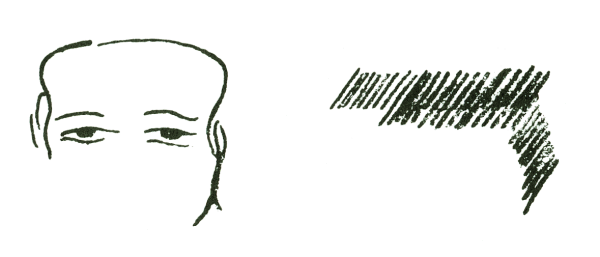 is drawn.) Is there anything of that sort? Nothing of the kind exists at all. What does exist is this: (see shaded drawing). There are certain surfaces in light and shade, and out of these a face appears. To bring lines into it, and form a face from them, is really an untruth: there is no such thing as this. An artistic feeling will prompt you to work out what is really there out of black and white or colour. Lines will then appear of themselves. Only when one traces the boundaries which arise in the light and shade or in the colour do the “drawing lines” appear. Therefore instruction in drawing must, in any case, not start from drawing itself but from painting, working in colour or in light and shade. And the teaching of drawing, as such, is only of real value when it is carried out in full awareness that it gives us nothing real. A terrible amount of mischief has been wrought in our whole method of thinking by the importance attached to drawing. From this has arisen all that we find in optics, for example, where people are eternally drawing lines which are supposed to be rays of light. Where can we really find these rays of light? They are nowhere to be found. What you have in reality is pictures. You make a hole in a wall; the sun shines through it and on a screen an image is formed. The rays can perhaps be seen, if at all, in the particles of dust in the room—and the dustier the room, the more you can see of them. But what is usually drawn as lines in this connection is only imagined. Everything, really, that is drawn, has been thought out. And it is only when you begin to teach the child something like perspective, in which you already have to do with the abstract method of explanation that you can begin to represent aligning and sighting by lines. But the worst thing you can do is to teach the child to draw a horse or a dog with lines. He should take a paint brush and make a painting of the dog, but never a drawing. The outline of the dog does not exist at all: where is it? It is, of course, produced of itself if we put on paper what is really there. We are now finding that there are not only children but also teachers who would like to join our school. There may well be many teachers in the outer world who would be glad to teach in the Waldorf School, because they would like it better there. I have had really quite a number of people coming to me recently and describing the manner in which they have been prepared for the teaching profession in the training colleges. One gets a slight shock in the case of the teachers of History, Languages, etc., but worst of all are the Drawing teachers, for they are carrying on a craft which has no connection whatever with artistic feeling: such feeling simply does not exist. And the result is (I am mentioning no names, so I can speak freely) that one can scarcely converse with the Drawing teachers: they are such dried-up, such terribly “un-human” people. They have no idea at all of reality. By taking up drawing as a profession they have lost touch with all reality. It is terrible to try to talk to them, quite apart from the fact that they want to teach drawing in the Waldorf School, where we have not introduced drawing at all. But the mentality of these people who carry on the unreal craft of drawing is also quite remarkable. And they have no moisture on the tongue—their tongues are quite dry. It is tragic to see what these drawing teachers gradually turn into, simply because of having to do something which is completely unreal. I will therefore answer this question by saying that where-ever possible you should start from painting and not from drawing. That is the important thing. I will explain this matter more clearly, so that there shall be no misunderstanding. You might otherwise think I had something personal against drawing teachers. I would like to put it thus: here is a group of children. I show them that the sun is shining in from this side. The sun falls upon something and makes all kinds of light, (see sketch). Light is shed upon everything. I can see bright patches. It is because the sun is shining in that I can see the bright patches everywhere. But above them I see no bright patches, only darkness (blue). But I also see darkness here, below the bright patches: there will perhaps be just a little light here. Then I look at something which, when the light falls on it in this way, looks greenish in colour. Here, where the light falls, it is whitish, but then, before the really black shadow occurs, I see a greenish colour; and here, under the black shadow, it is also greenish, and there are other curious things to be seen in between the two. Here the light does not go right in. You see, I have spoken of light and shadow, and of how there is something here on which the light does not impinge: and lo, I have made a tree! I have only spoken about light and colour, and I have made a tree. We cannot really paint the tree: we can only bring in light and shade, and green, or, 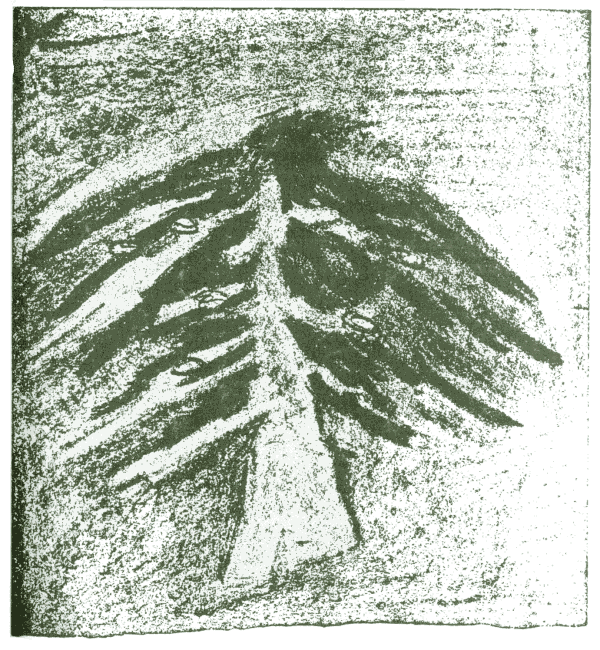 a little yellow, if you like, if the fruit happens to be lovely apples. But we must speak of colour and light and shade; and so indeed we shall be speaking only of what is really there—colour, light and shade. Drawing should only be done in Geometry and all that is connected with that. There we have to do with lines, something which is worked out in thought. But realities, concrete realities must not be drawn with a pen; a tree, for example, must be evolved out of light and shade and out of the colours, for this is the reality of life itself.2 It would be barbarous if an orthodox drawing teacher came and had this tree, which we have drawn here in shaded colours, copied in lines. In reality there are just light patches and dark patches. Nature does that. If lines were drawn here, it would be an untruth. Should the direct method, without translation, be used, even for Latin and Greek? In this respect a special exception must be made with regard to Latin and Greek. It is not necessary to connect these directly with practical life, for they are no longer alive, and we have them with us only as dead languages. Now Greek and Latin (for Greek should actually precede Latin in teaching) can only be taught when the children are somewhat older, and therefore the translation method for these languages is, in a certain way, fully justified. There is no question of our having to converse in Latin and Greek, but our aim is to understand the ancient authors. We use these languages first and foremost for the purposes of translation. And thus it is that we do not use the same methods for the teaching of Latin and Greek as those which we employ with all living languages. Now once more comes the question that is put to me whenever I am anywhere in England where education is being discussed: How should instruction in Gymnastics be carried out, and should Sports be taught in an English school, hockey and cricket, for example, and if so in what way? It is emphatically not the aim of the Waldorf School Method to suppress these things. They have their place simply because they play a great part in English life, and the child should grow up into life. Only please do not fall a prey to the illusion that there is any other meaning in it than this, namely, that we ought not to make the child a stranger to his world. To believe that sport is of tremendous value in development is an error. It is not of great value in development. Its only value is that it is a fashion dear to the English people, and we must not make the child a stranger to the world by excluding him from all popular usages. You like sport in England, so the child should be introduced to sport. One should not meet with philistine opposition what may possibly be philistine itself. With regard to “how it should really be taught,” there is very little indeed to be said. For in these things it is really more or less so that someone does them first, and then the child imitates him. And to devise special artificial methods here would be something scarcely appropriate to the subject. In Drill or Gymnastics one simply learns from anatomy and physiology in what position any limb of the organism must be placed in order that it may serve the agility of the body. It is a question of really having a sense for what renders the organism skilled, light and supple; and when one has this sense, one has then simply to demonstrate. Suppose you have a horizontal bar: it is customary to perform all kinds of exercises on the bar except the most valuable one of all, which consists in hanging on to the bar, hooked on, like this ... then swinging sideways, and then grasping the bar further up, then swinging back, then grasping the bar again. There is no jumping but you hang from the bar, fly through the air, make the various movements, grasp the bar thus, and thus, and so an alternation in the shape and position of the muscles of the arms is produced which actually has a healthy effect upon the whole body. You must study which inner movements of the muscles have a healthy effect on the organism, so that you will know what movements to teach. Then you have only to do the exercises in front of the children, for the method consists simply in this preliminary demonstration.3 How should religious instruction be given at the different ages? As I always speak from the standpoint of practical life, I have to say that the Waldorf School Method is a method of education and is not meant to bring into the school a philosophy of life or anything sectarian. Therefore I can only speak of what lives within the Waldorf School principle itself. It was comparatively easy for us in Württemberg, where the laws of education were still quite liberal: when the Waldorf School was established we were really shown great consideration by the authorities. It was even possible for me to insist that I myself should appoint the teachers without regard to their having passed any State examination or not. I do not mean that everyone who has passed a State examination is unsuitable as a teacher! I would not say that. But still, I could see nothing in a State examination that would necessarily qualify a person to become a teacher in the Waldorf School. And in this respect things have really always gone quite well. But one thing was necessary when we were establishing the school, and that was for us definitely to take this standpoint: We have a “Method-School”; we do not interfere with social life as it is at present, but through Anthroposophy we find the best method of teaching, and the School is purely a “Method-School.” Therefore I arranged, from the outset, that religious instruction should not be included in our school syllabus, but that Catholic religious teaching should be delegated to the Catholic priest, and the Protestant teaching to the pastor and so on. In the first few years most of our scholars came from a factory (the Waldorf-Astoria Cigarette Factory), and amongst them we had many “dissenting” children, children whose parents were of no religion. But our educational conscience of course demanded that a certain kind of religious instruction should be given them also. We therefore arranged a “free religious teaching” for these children, and for this we have a special method. In these “free Religion lessons” we first of all teach gratitude in the contemplation of everything in Nature. Whereas in the telling of legends and myths we simply relate what things do—stones, plants and so on—here in the Religion lessons we lead the child to perceive the Divine in all things. So we begin with a kind of “religious naturalism,” shall I say, in a form suited to the children. Again, the child cannot be brought to anunderstanding of the Gospels before the time between the ninth and tenth years of which I have spoken. Only then can we proceed to a consideration of the Gospels in the Religion lessons, going on later to the Old Testament. Up to this time we can only introduce to the children a kind of Nature-religion in its general aspect, and for this we have our own method. Then we should go on to the Gospels but not before the ninth or tenth year, and only much later, between the twelfth and thirteenth years, we should proceed to the Old Testament.4 This then is how you should think of the free Religion lessons. We are not concerned with the Catholic and Protestant instruction: we must leave that to the Catholic and Protestant pastors. Also every Sunday we have a special form of service for those who attend the free Religion lessons. A service is performed and forms of worship are provided for children of different ages. What is done at these services has shown its results in practical life during the course of the years; it contributes in a very special way to the deepening of religious feeling, and awakens a mood of great devotion in the hearts of the children. We allow the parents to attend these services, and it has become evident that this free religious teaching truly brings new life to Christianity And there is real Christianity in the Waldorf School, because through this naturalistic religion during the early years the children are gradually led to an understanding of the Christ Mystery, when they reach the higher classes. Our free Religion classes have, indeed, gradually become full to overflowing. We have all kinds of children coming into them from the Protestant pastor or the Catholic priest, but we make no propaganda for it. It is difficult enough for us to find sufficient Religion teachers, and therefore we are not particularly pleased when too many children come; neither do we wish the school to acquire the reputation of being an Anthroposophical School of a sectarian kind. We do not want that at all. Only our educational conscience has constrained us to introduce this free Religion teaching. But children turn away from the Catholic and Protestant teaching and more and more come over to us and want to have the free Religion teaching: they like it better. It is not our fault that they run away from their other teachers: but as I have said, the principle of the whole thing was that religious instruction should be given, to begin with, by the various pastors. When you ask, then, what kind of religious teaching we have, I can only speak of what our own free Religion teaching is, as I have just described it. Should French and German be taught from the beginning, in an English School? If the children come to a Kindergarten Class at five or six years old, ought they, too, to have language lessons? As to whether French and German should be taught from the beginning in an English School, I should first like to say that I think this must be settled entirely on grounds of expediency. If you simply find that life is making it necessary to teach these languages, you must teach them. We have introduced French and English into the Waldorf School, because with French there is much to be learnt from the inner quality of the language, not found elsewhere, namely, a certain feeling for rhetoric which it is very good to acquire: and English is taught because it is a universal world language, and will become so more and more. Now, I should not wish to decide categorically whether French and German should be taught in an English School, but you must be guided by the circumstances of life. It is not at all so important which language is chosen as that foreign languages are actually taught in the school. And if children of four or five years do already come to school (which should not really be the case) it would then be good to do languages with them also. It would be right for this age. Some kind of language teaching can be given even before the age of the change of teeth, but it should only be taught as a proper lesson after this change. If you have a Kindergarten Class for the little children, it would be quite right to include the teaching of languages but all other school subjects should as far as possible be postponed until after the change of teeth. I should like to express, in conclusion, what you will readily appreciate, namely, that I am deeply gratified that you are taking such an active interest in making the Waldorf School Method fruitful here in England, and that you are working with such energy for the establishment of a school here, on our Anthroposophical lines. And I should like to express the hope that you may succeed in making use of what you were able to learn from our Training Courses in Stuttgart, from what you have heard at various other Courses which have been held in England, and, finally, from what I have been able to give you here in a more aphoristic way, in order to establish a really good school here on Anthroposophical lines. You must remember how much depends upon the success of the very first attempt. If it does not succeed, very much is lost, for all else will be judged by the first attempt. And indeed, very much depends on how your first project is launched: from it the world must take notice that the matter is neither something which is steeped in abstract, dilettante plans of school reform, nor anything amateur but something which arises out of a conception of the real being of man, and which is now to be brought to bear on the art of education. And it is indeed the very civilisation of today, which is now moving through such critical times, that calls us to undertake this task, along with many other things. In conclusion I should like to give you my right good thoughts on your path—the path which is to lead to the founding of a school here on Anthroposophical lines.
|




